
For many years, users have wanted to combine two ideas: portability and productivity. Usually, this requires buying a desktop PC and a lightweight laptop. Some manufacturers try to combine these ideas into one, but there are always compromises. Today we are reviewing a laptop from the Acer brand that copes with this quite successfully — Acer Nitro 14 (AN14-41-R6) with AMD Ryzen 7 8845HS processor and NVIDIA Geforce RTX 4060 (TGP 110 W).
Content
- 1 Specifications of Acer Nitro 14 (AN14-41-R6)
- 2 Completeness and packaging
- 3 Design, ergonomics and materials
- 4 Wired and wireless interfaces
- 5 Camera and Sound
- 6 Keyboard and trackpad
- 7 Display Acer Nitro 14 (AN14-41-R6)
- 8 Proprietary software
- 9 Acer Nitro 14 (AN14-41-R6) performance and benchmarks
- 10 Battery life, temperatures and noise
- 11 Experience of use
- 12 Price and competitors
Specifications of Acer Nitro 14 (AN14-41-R6)
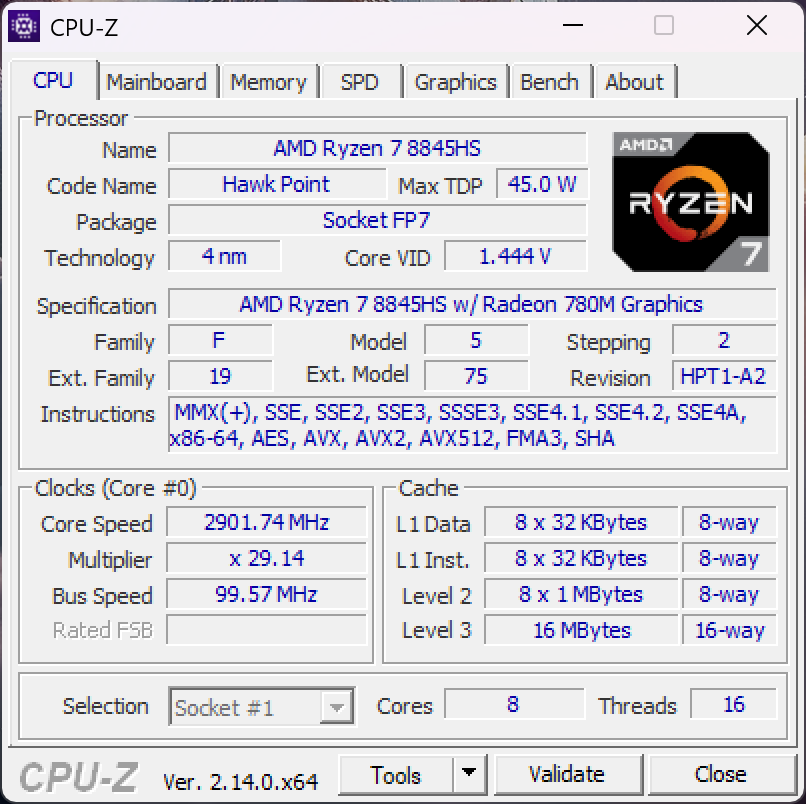
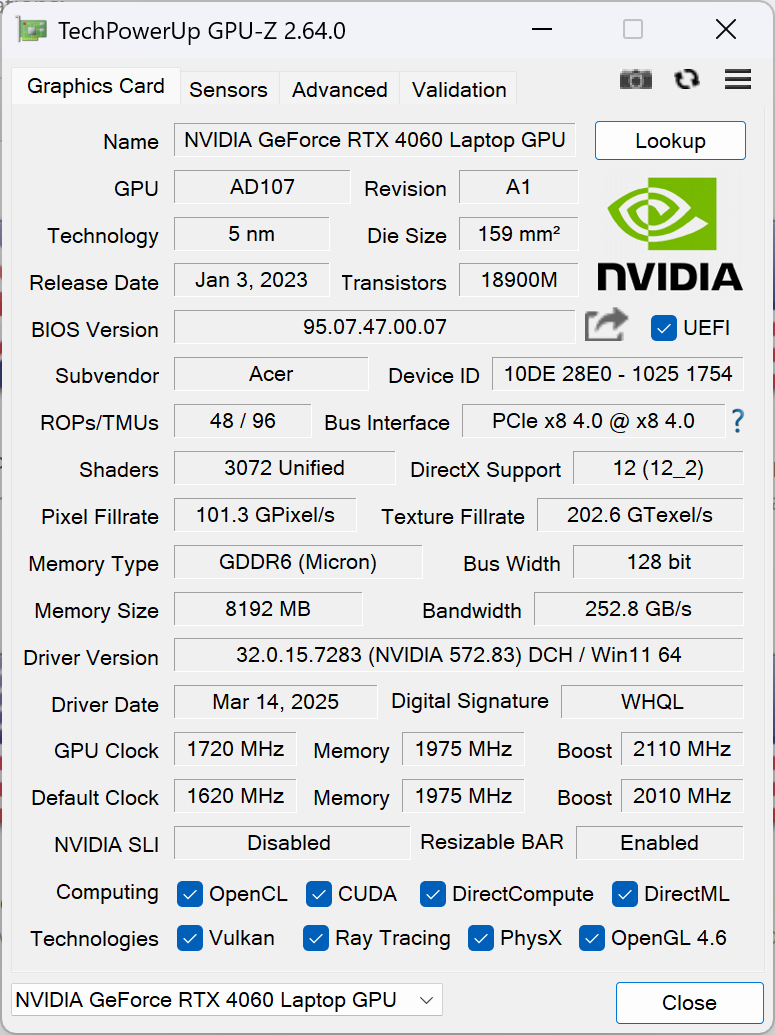

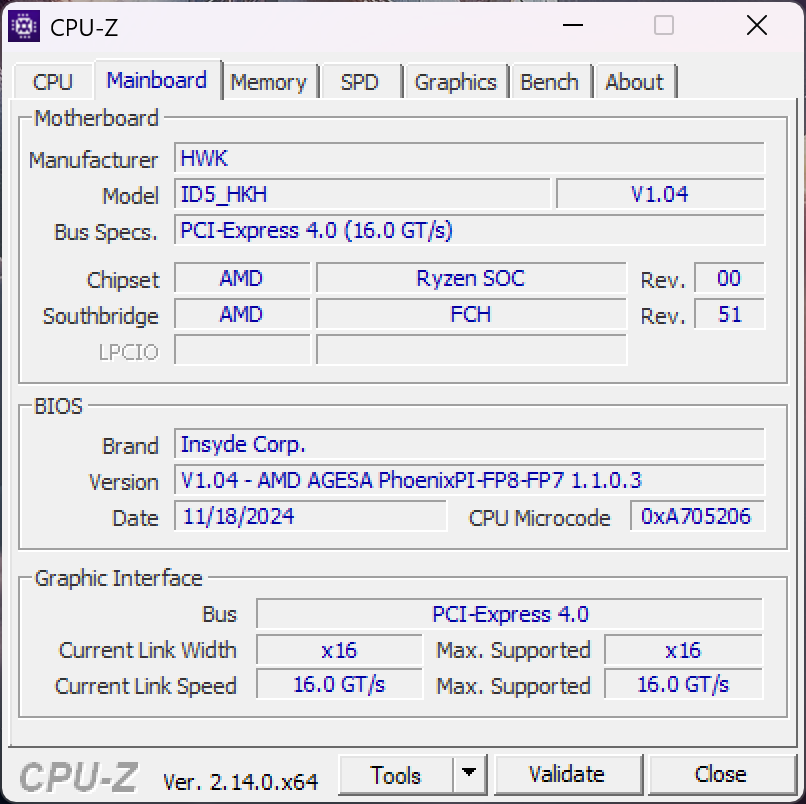

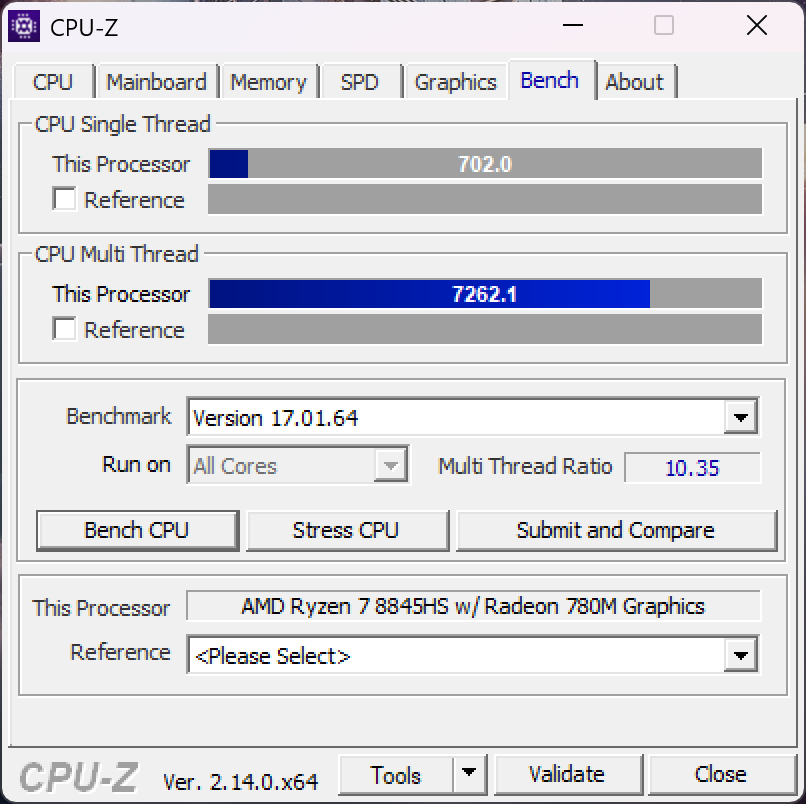
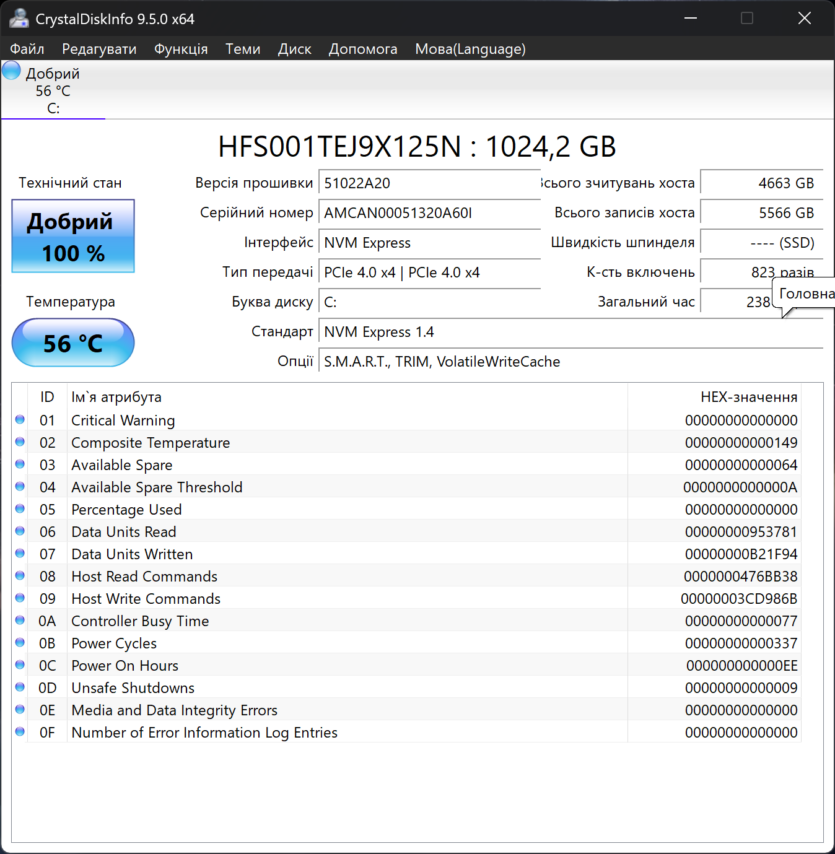

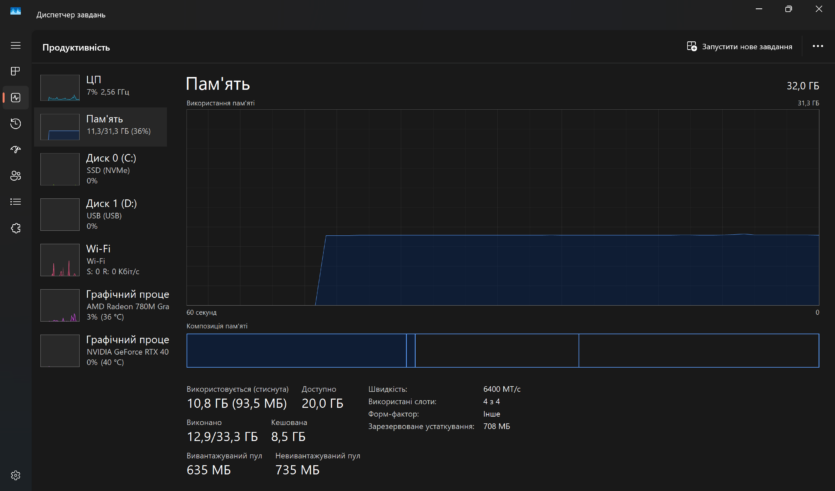

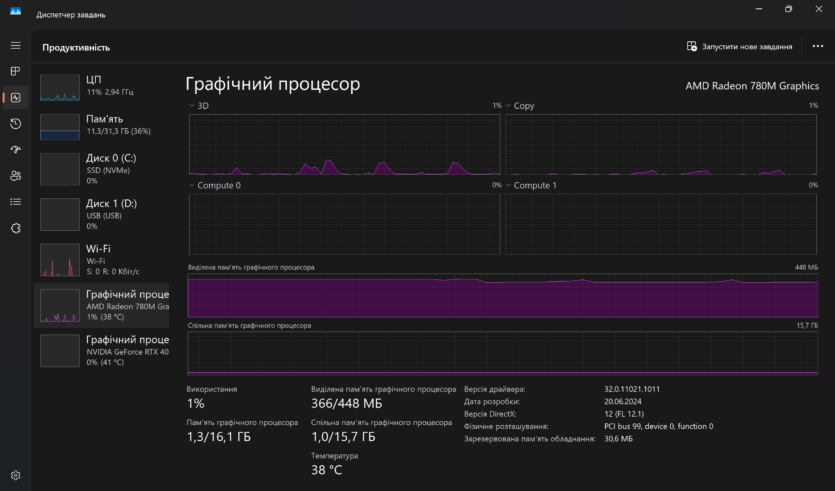
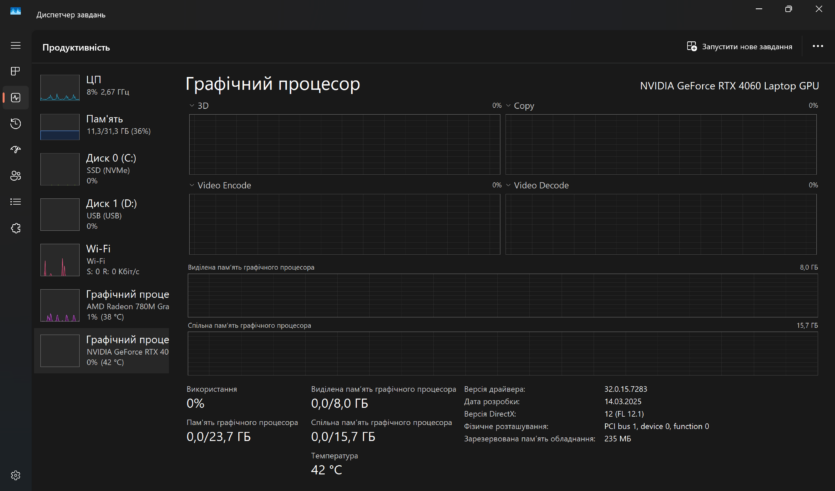
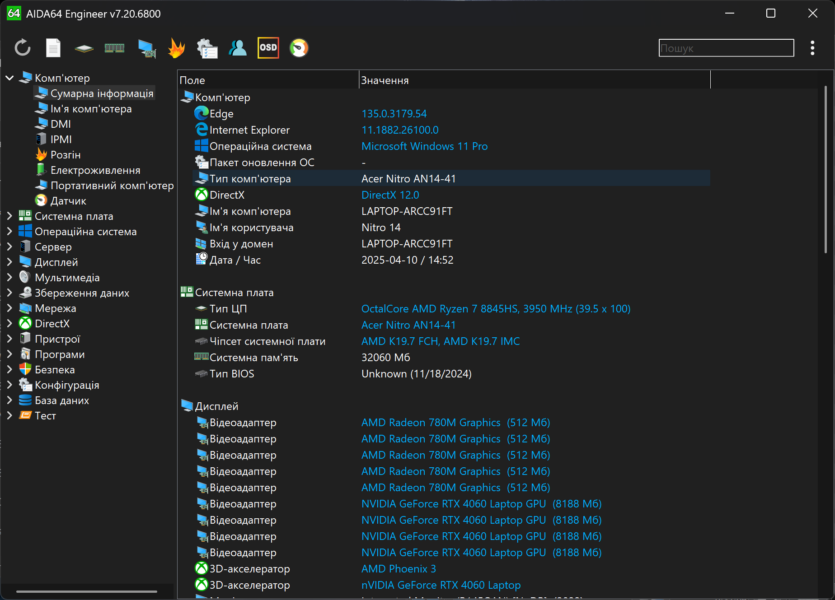
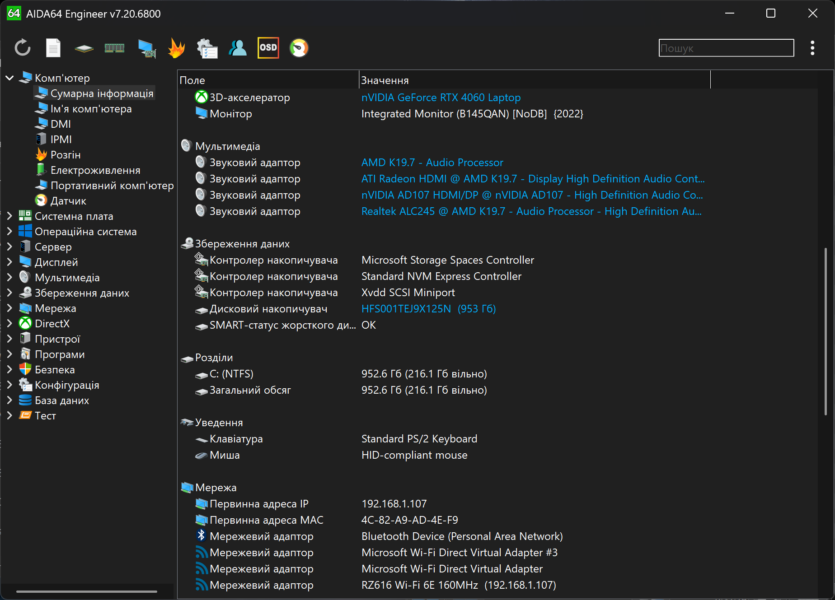
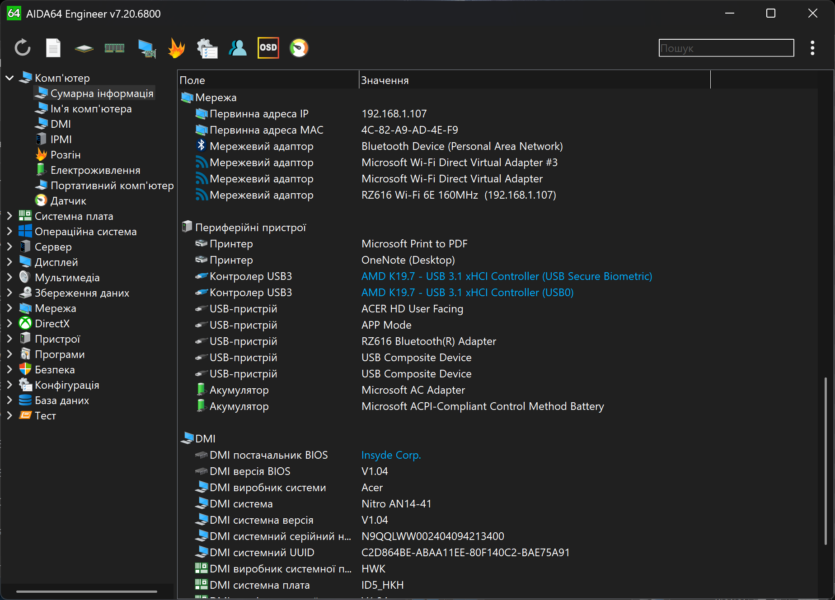
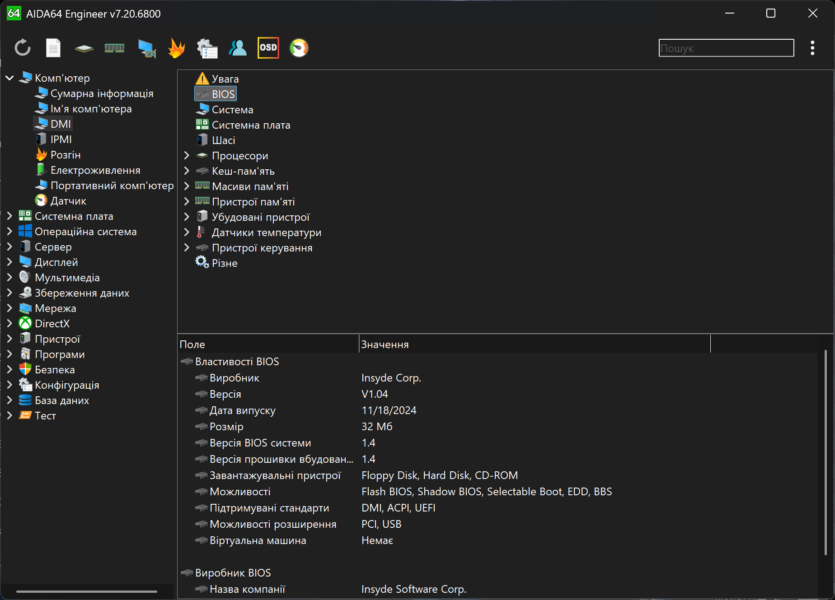
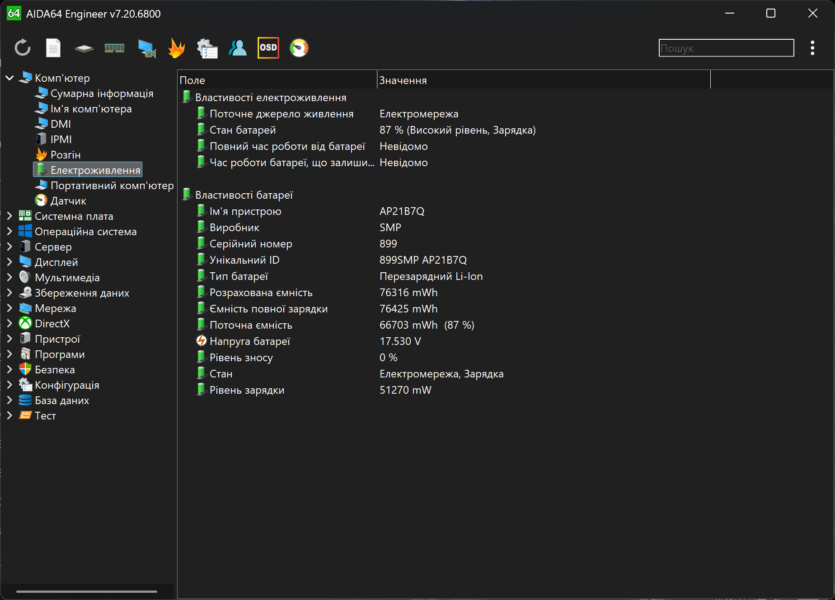

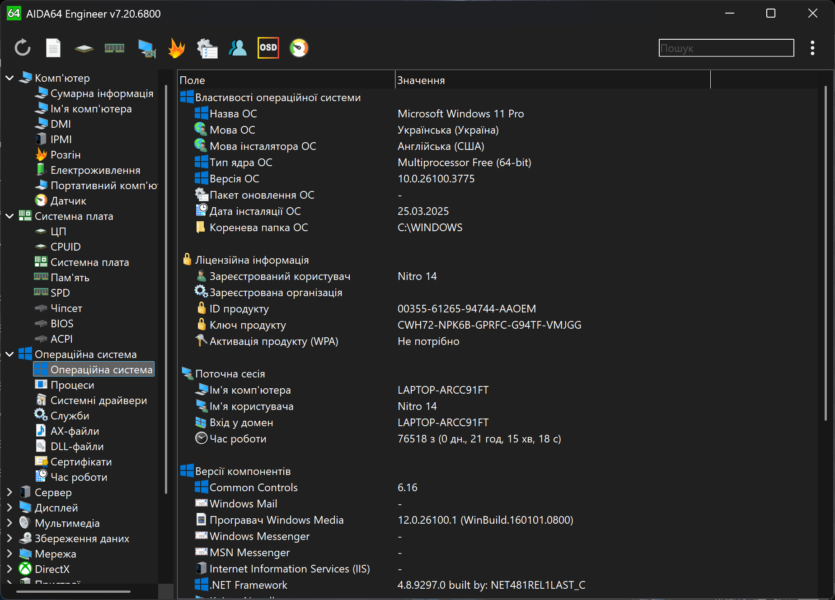

| Screen | 14.5″, WQXGA (2560×1600), IPS, 100% sRGB, 72% DCI-P3,120 Hz, matte, NVIDIA G-SYNC |
| Processor | AMD Ryzen 7 8845HS (8 cores / 16 threads, 3.8 / 5.1 GHz, 8 MB L2 / 16 MB L3) |
| RAM | 32 GB LPDDR5x-6400 (soldered) |
| Drive | 1 TB SSD M.2 2280, PCIe 4.0 |
| Video card | AMD Radeon 780M, NVIDIA Geforce RTX 4060 8 GB (TGP 110 W) |
| Wireless interfaces | Wi-Fi 6E, 802.11ax, BT5.3 |
| Wired interfaces | 2x USB-A (USB 3.2 Gen 2) 1x USB-C (USB 3.2 Gen 2) 1x USB-C (USB 4) 1x HDMI® 2.1, up to 4K/60 Hz 1 x 3.5 mm combo audio jack 1x microSD |
| Power supply | 230 W |
| Battery | 73 W*h, 4 cells |
| Weight | 2.02 kg |
| Dimensions | 324.12 x 255.9 x 22.84 mm |
Completeness and packaging
The Acer Nitro 14 (AN14-41-R6) comes in a stylish black box with matching brand logos. Inside, it is divided into two parts, where in the larger one we find the hero of the review in a fabric case, and in the other — a large power supply for as much as 230 W and a power cable. The total length of the cables is more than 3.5 meters, which should be enough in most situations to connect to a power outlet.
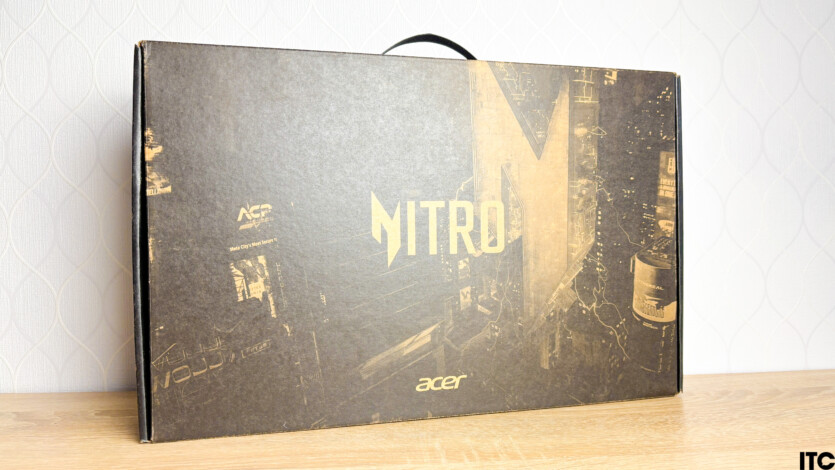
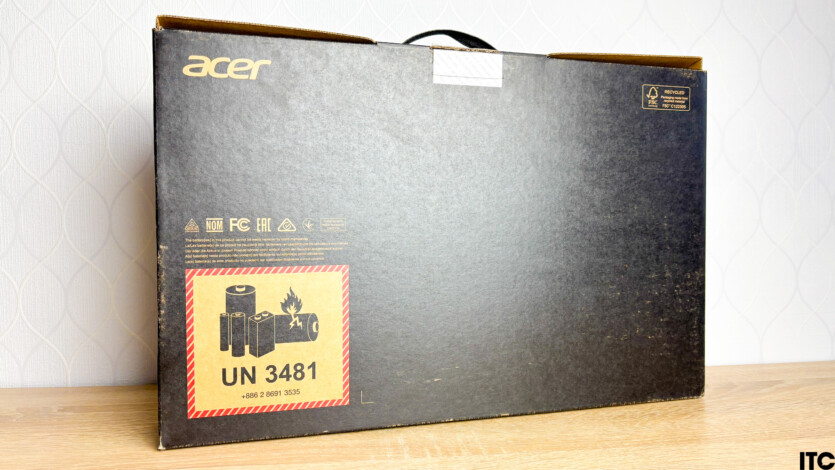
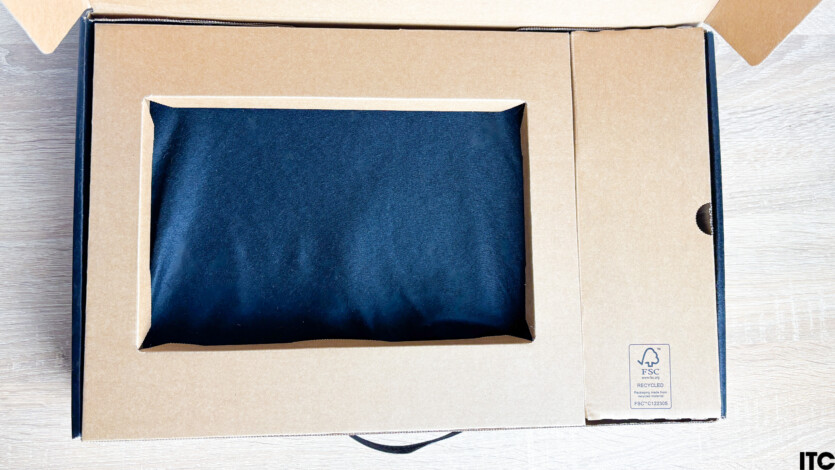
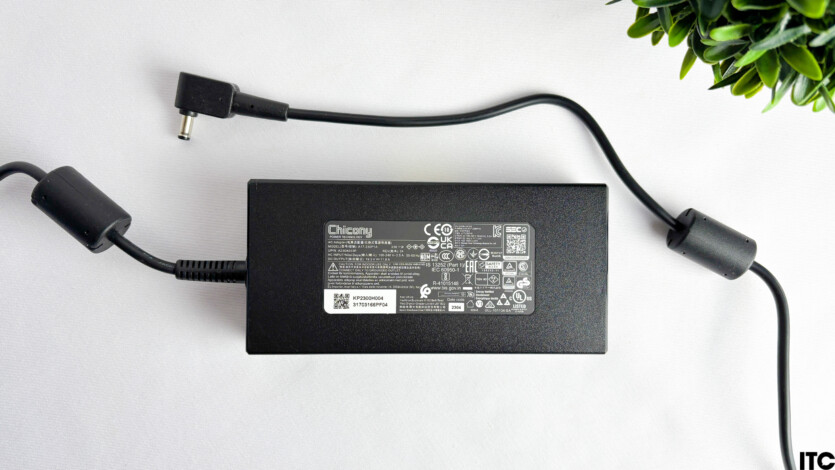
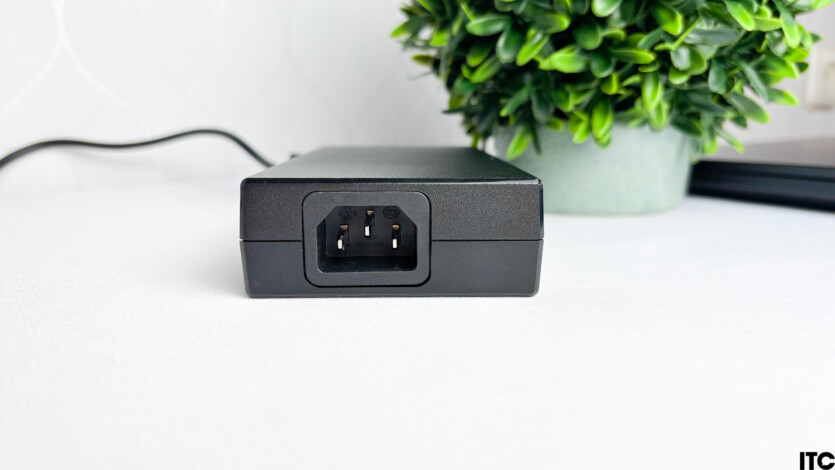
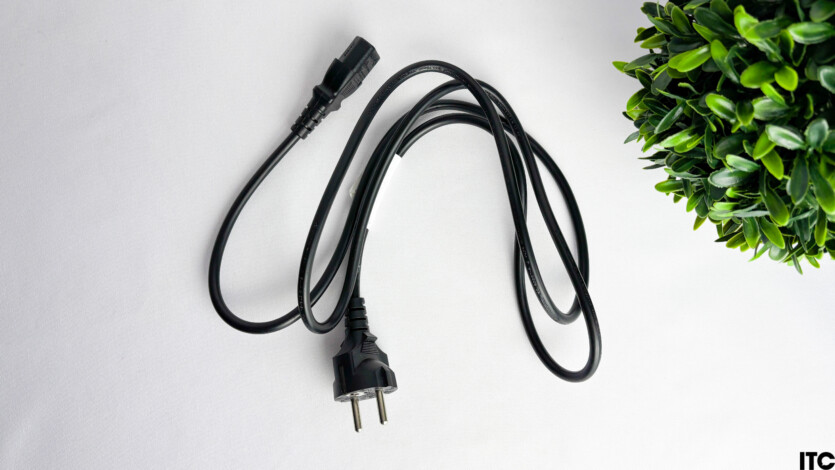
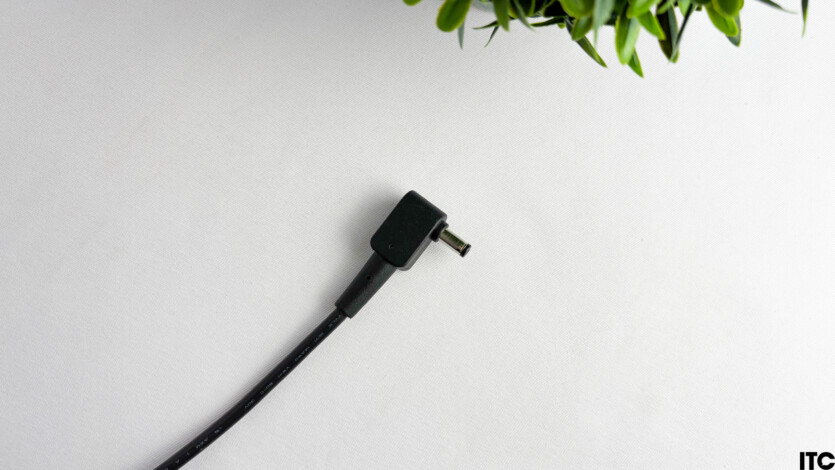
Design, ergonomics and materials
Acer is positioning the Nitro series as affordable gaming laptops if users can’t afford the older and more powerful Predator lines for some reason. The exterior of the Acer Nitro 14 (AN14-41-R6) looks stylish. The beveled corners, matte black color with a splash of orange do not turn the laptop into a fully gaming or «flat» business style. The only thing that gives away the gaming orientation is the additional rear part behind the display, which is an additional «shaft» for removing hot air from the inside of the device, which improves circulation and cooling of internal components.

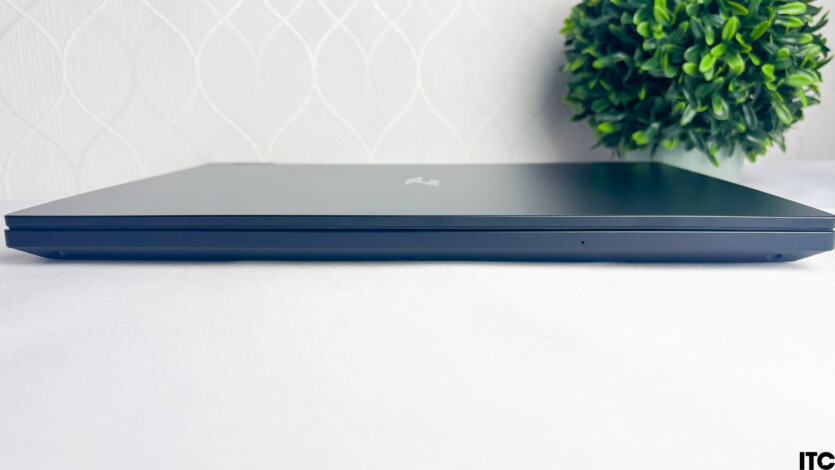
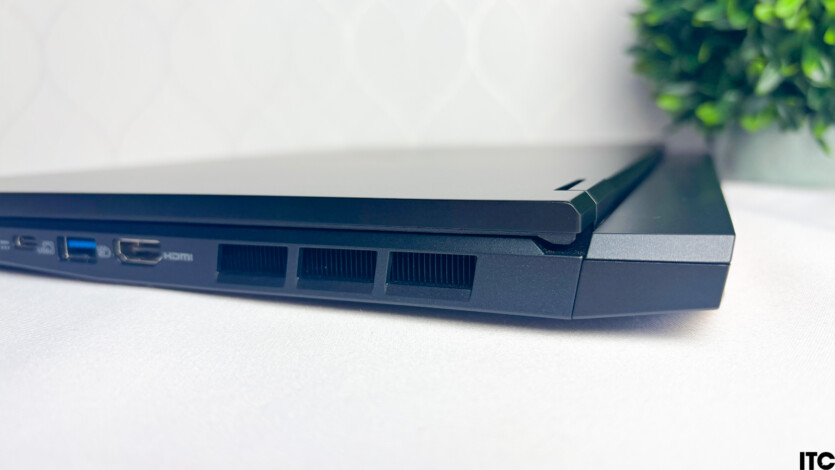
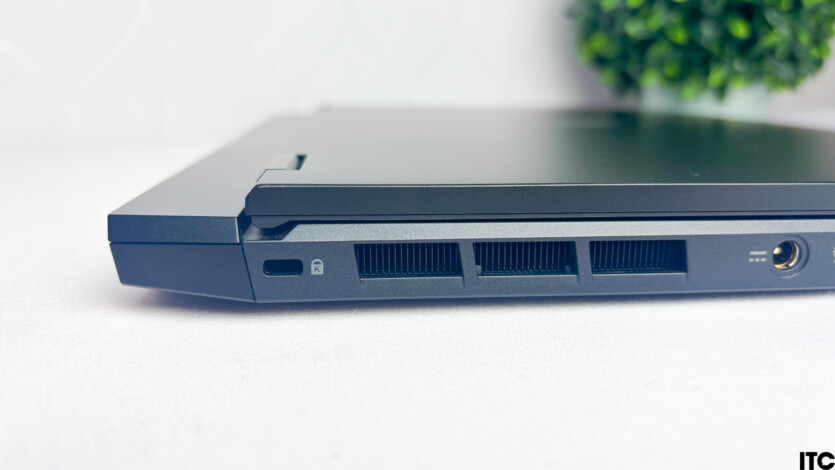
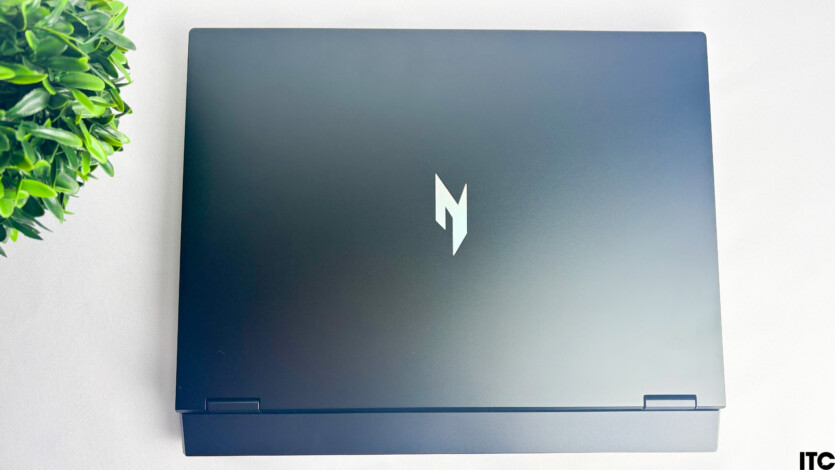
On the back of the monitor is the Nitro logo, which shimmers slightly against the light. You can also find it under the laptop display above the keyboard unit. On the back there are symmetrical holes (two fans inside the case) for air intake for further removal of already hot streams to other sides. Namely, on the sides, at the back of the case and above the keyboard unit. The marketing name of the cooling system is Vortex Flow. We will talk about the benefits of such a system in the corresponding section.
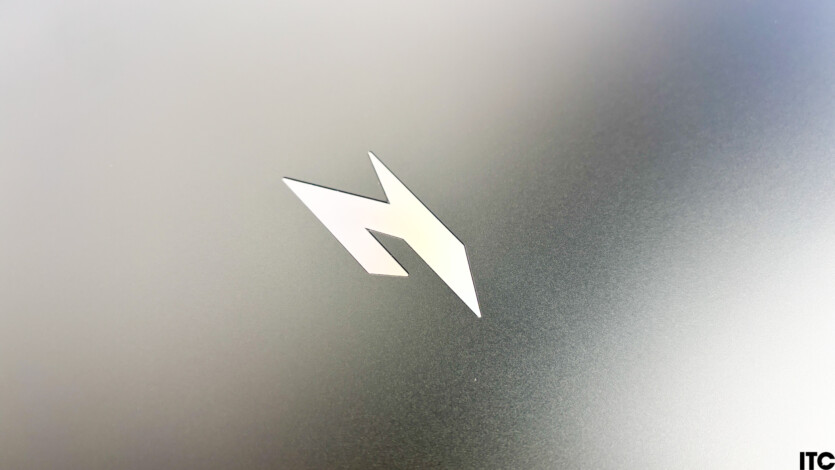
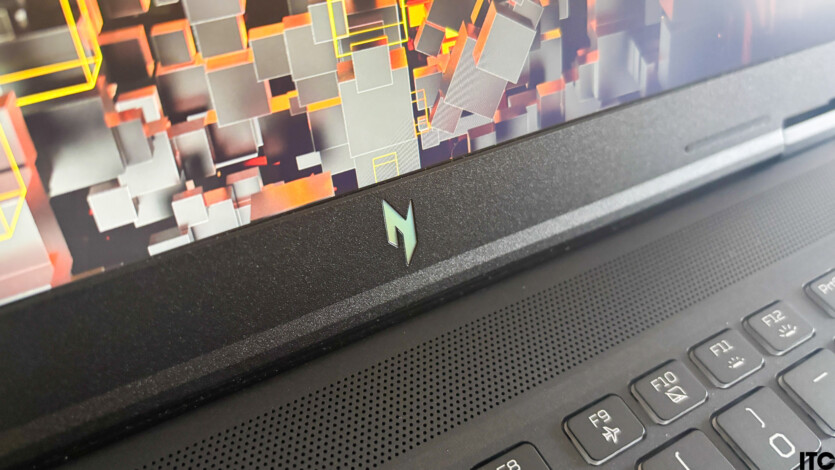
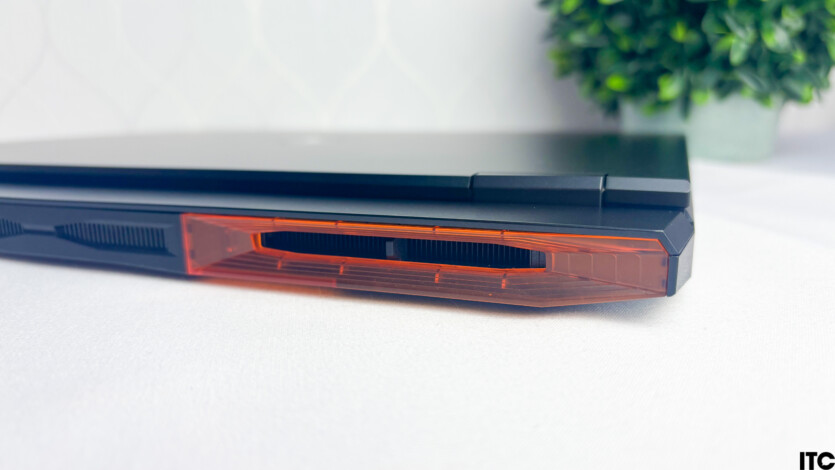
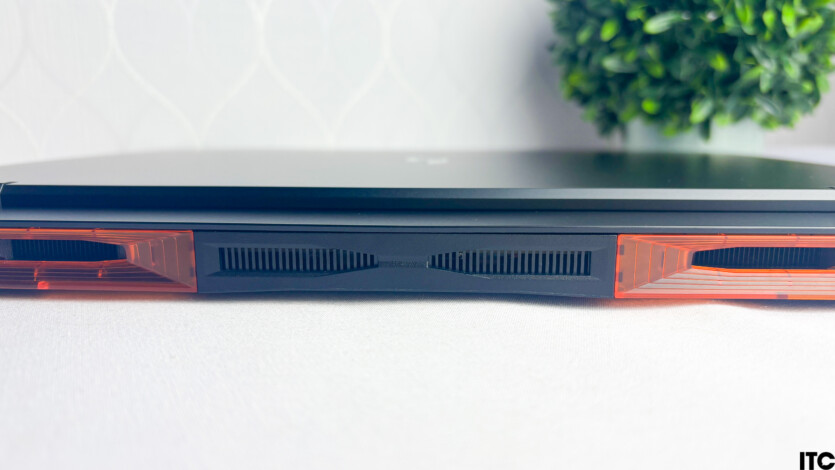
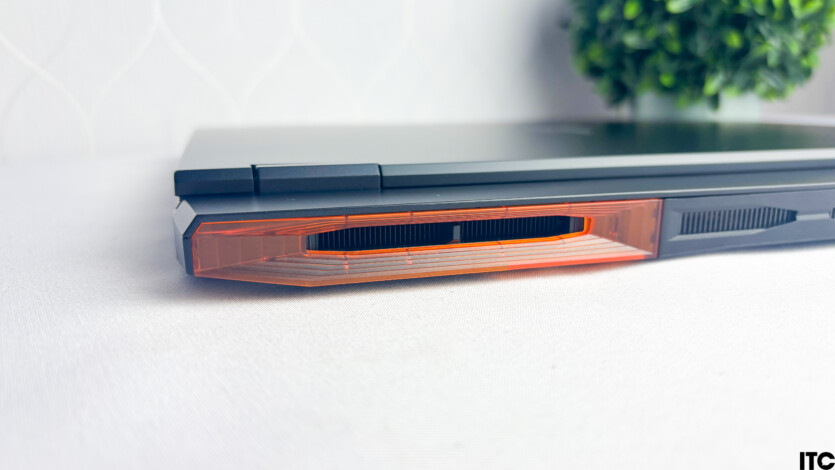
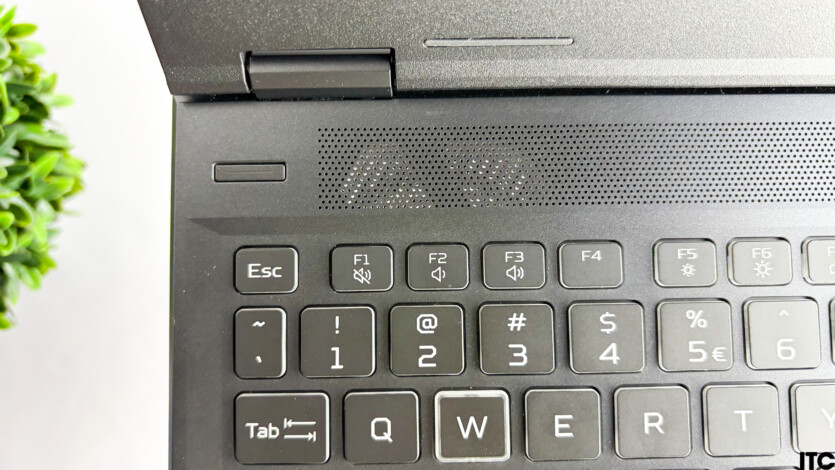
Due to its strict design, the laptop looks monolithic, although it is made of plastic. I have no complaints about the upper display part: nothing creaks, «MacBook test» passes. But there are questions about the quality of the touchpad, which bends a little at the top.
Since the air intake is from the bottom of the case, you need to be very careful when using it in bed or on a fabric surface. Looking ahead, I will say that the laptop turns off the coolers even in Turbo mode if there is no load on the system or the load is quite light. For gaming, it is generally better to have a stand that will raise the Acer Nitro 14 (AN14-41-R6) above the table surface for better air intake.
The bottom contains information about the laptop, a Windows hologram, two speakers, rubber feet, and holes through which air is drawn into the cooling system. The cooling system consists of two fans, so you need to be careful not to cover both holes.
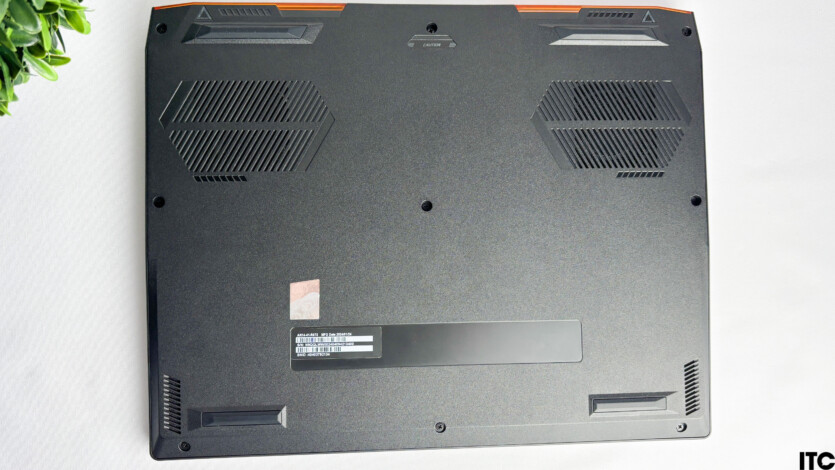
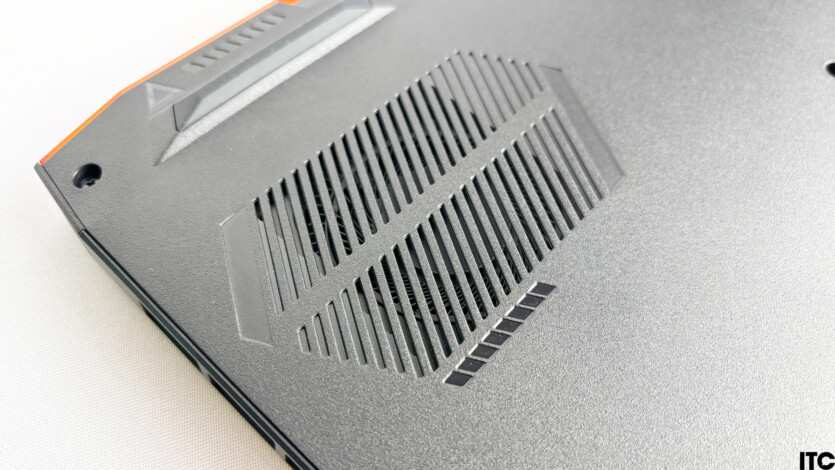
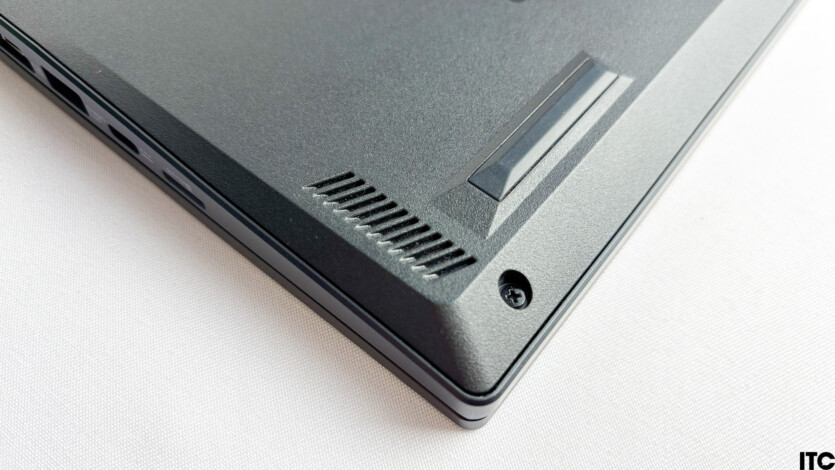

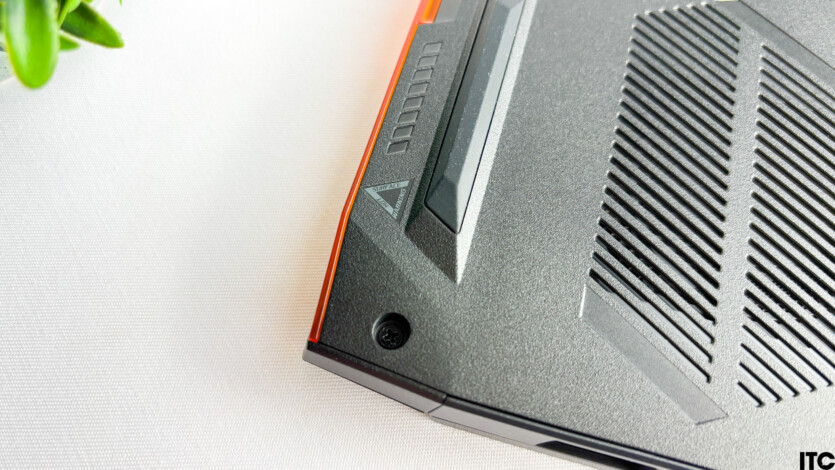
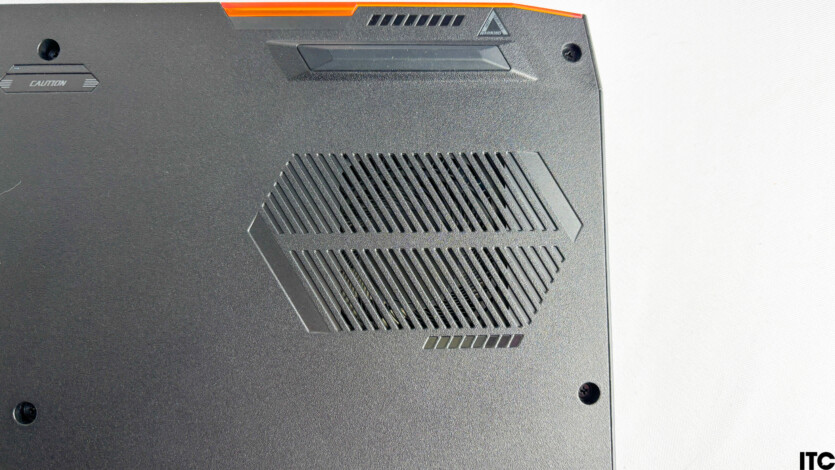
The maximum opening angle is 130 degrees. This should be enough for most cases. The display is not touch-sensitive, so there is no need to press and have a larger opening angle.
The dimensions of the laptop are 324.12 x 255.9 x 22.84 mm. The laptop weighs 2.02 kg. Of course, the Acer Nitro 14 (AN14-41-R6) will be larger than its business counterparts, as it requires better and heavier cooling for the internal powerful components in this class of devices. There shouldn’t be any problems with transportation. Just don’t forget the power supply, it’s quite large and heavy.
Wired and wireless interfaces
On the left side of the Acer Nitro 14 (AN14-41-R6) case are: a round plug for charging the device, a 3.5 mm headset jack, one USB Type-A 3.2 Gen 2 and one USB Type-C 3.2, power and battery indicators.
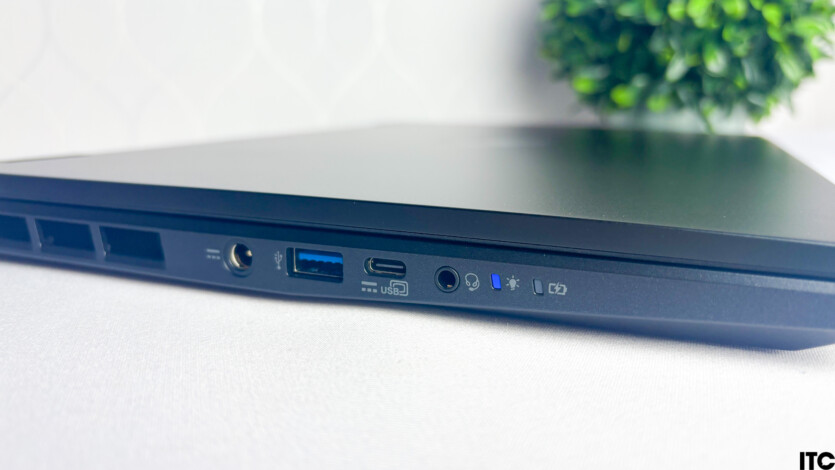

On the right side, there is a single MicroSD card reader, a regular USB Type-A 3.2 Gen 1 with Always-On mode, a USB Type-C 3.2, and an HDMI 2.1 video output. Both USB Type-Cs support charging the device, PowerDelivery 3.0 and DisplayPort 1.4.
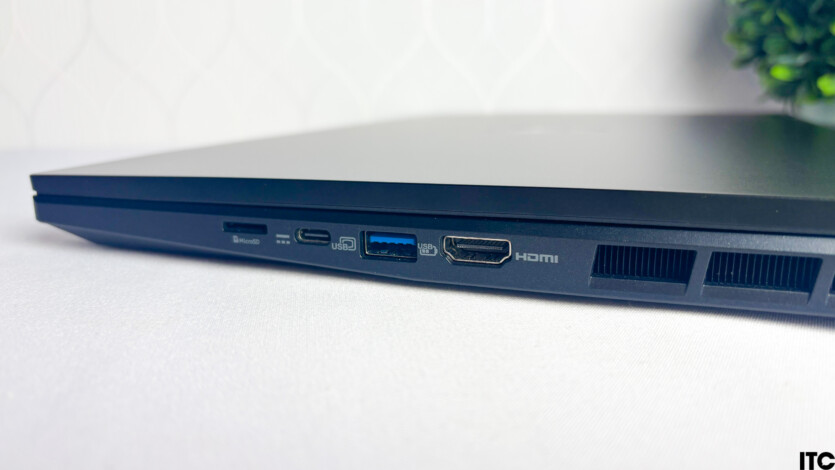

There are cooling vents on both sides to exhaust hot air from the laptop. So be careful to connect the charging plug on the left side of the device so that the currents do not heat the wire unnecessarily. It is better to buy an additional laptop stand: the cable will not heat up and it will be easier for the cooling system to draw air for cooling.

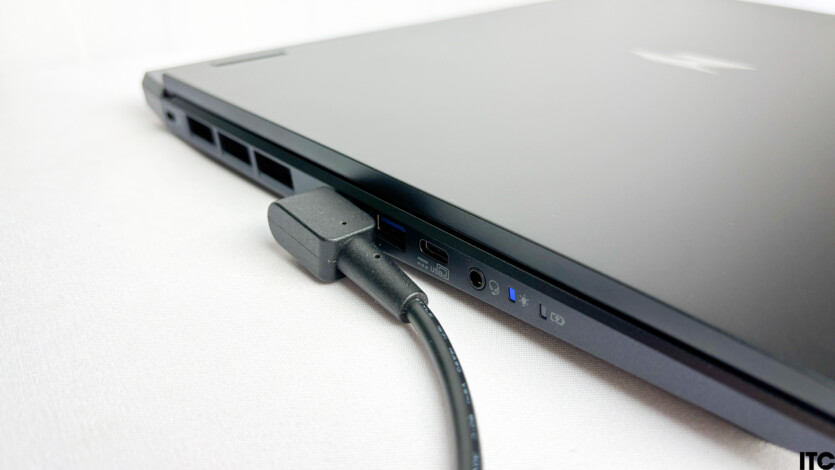
As for wireless interfaces, Acer Nitro 14 (AN14-41-R6) offers WiFi 6 (802.11ax) and Bluetooth 5.3. While all the test programs were loaded, no problems with the wireless Internet were detected. To test Bluetooth 5.3, I connected one pair of TWS headsets. There were no problems with range or sound.
Camera and Sound
Above the monitor is a built-in 2-megapixel webcam with a resolution of 1920×1080 pixels (FullHD) and a diode indicator. I wish I could say something about it, but I never managed to get it working. Perhaps it’s a feature of the test copy. It should be suitable for video conferencing, but definitely not for streaming or anything else.
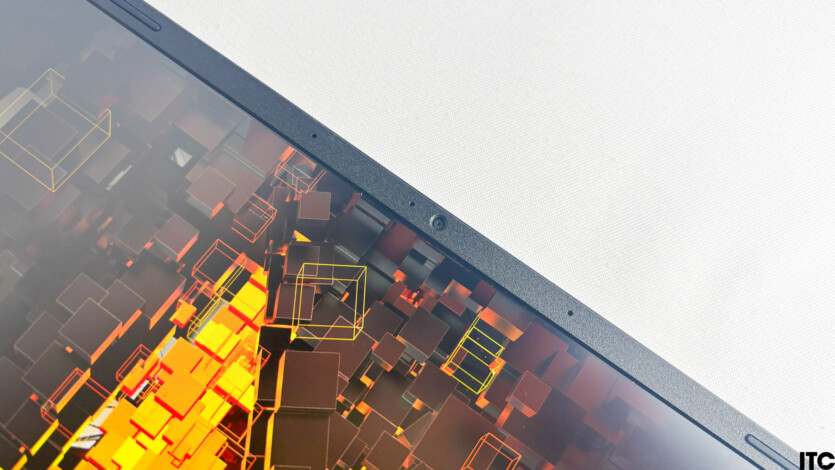
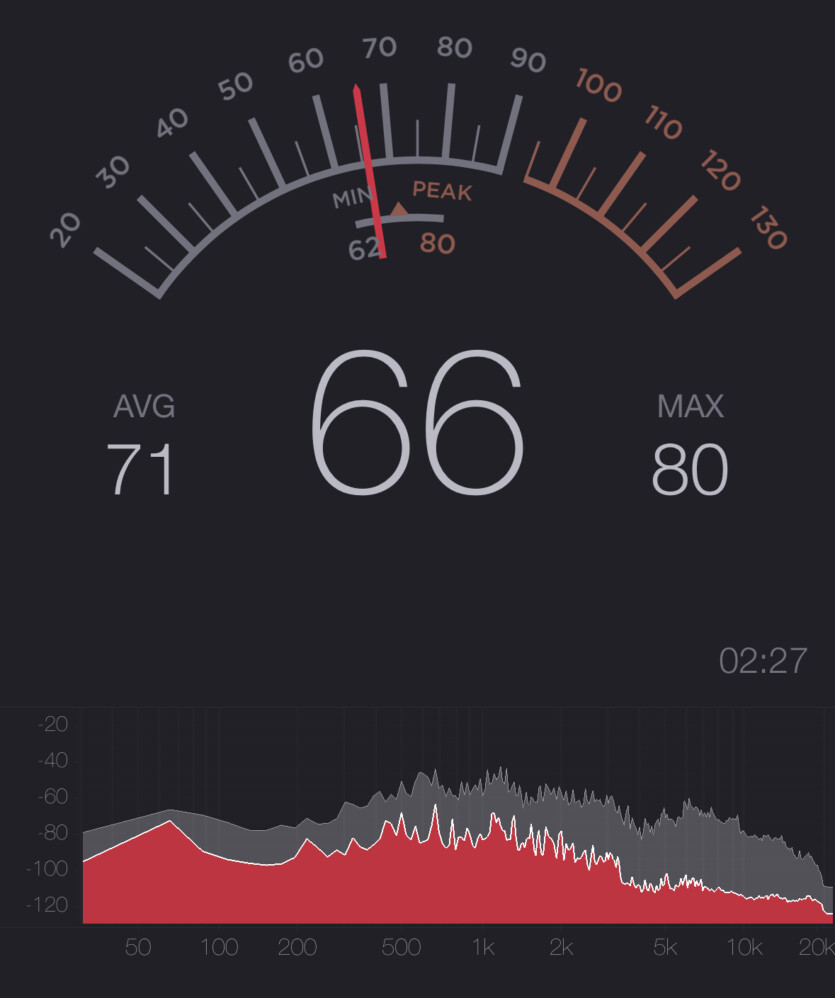
The manufacturer has placed 2W speakers in the laptop. They are located on the bottom panel on the sides. To be honest, the sound system is quite quiet — only 80 decibels at maximum volume. Even the support for DTX X: Ultra Audio support doesn’t help the situation. This maximum volume level should be enough for watching movies and non-esports games.
Keyboard and trackpad
The keyboard has large buttons with a fairly comfortable and quiet keystroke. The arrows are large and not paired. Of course, it will take some time to learn how to use the new keyboard. As you can see in the photos, there is no Ukrainian language on the keyboard layout. This is a feature of the test copy.

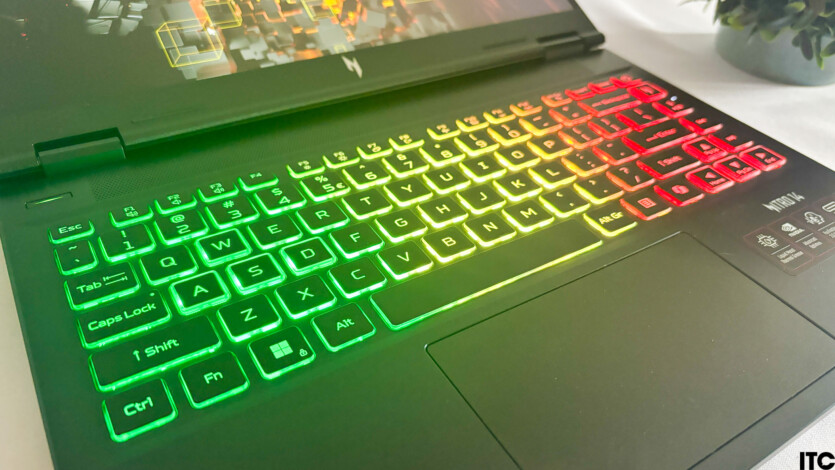
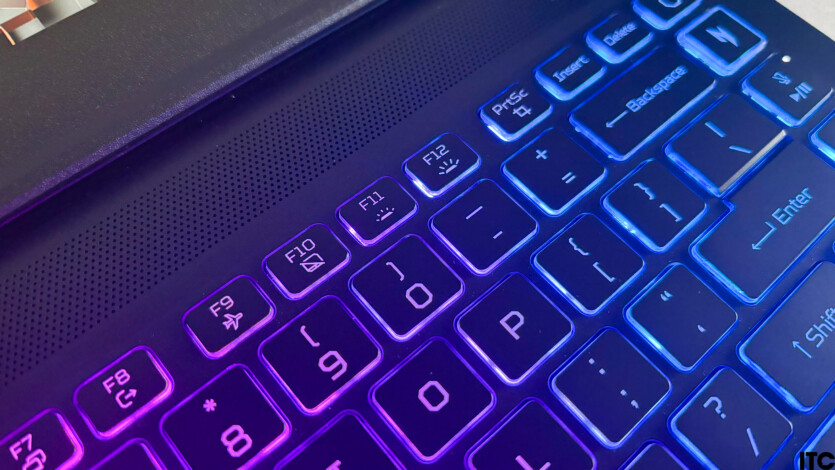
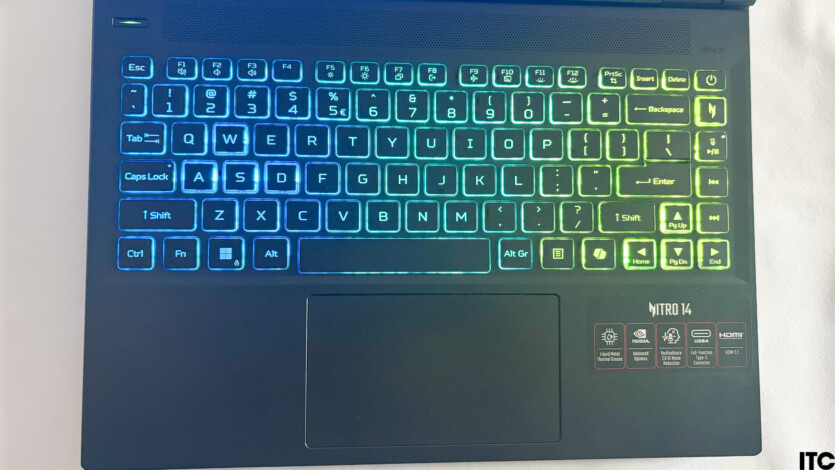
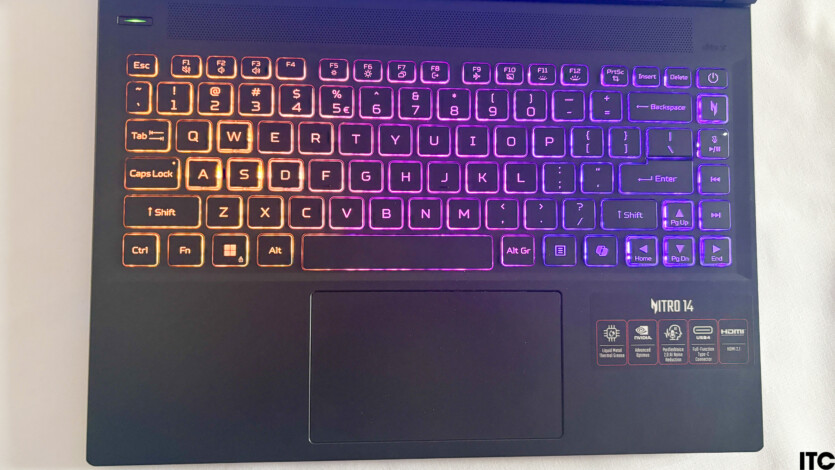
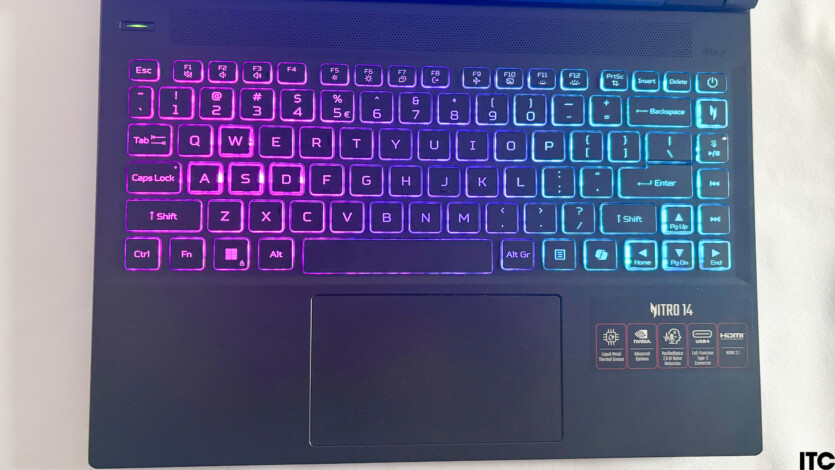
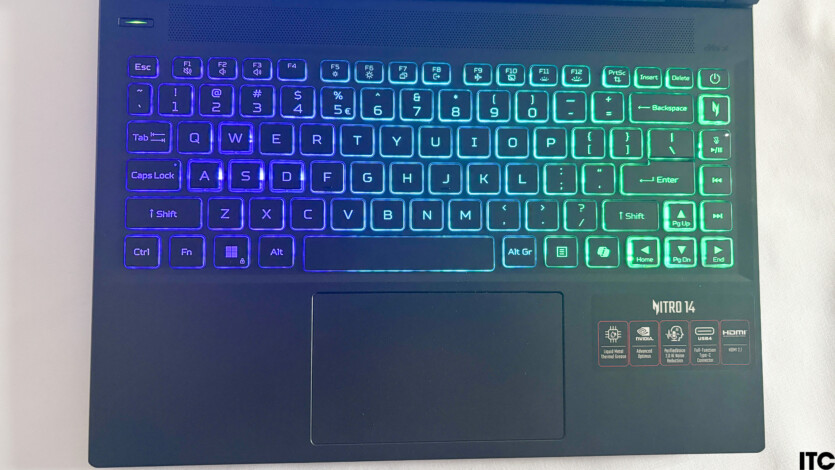
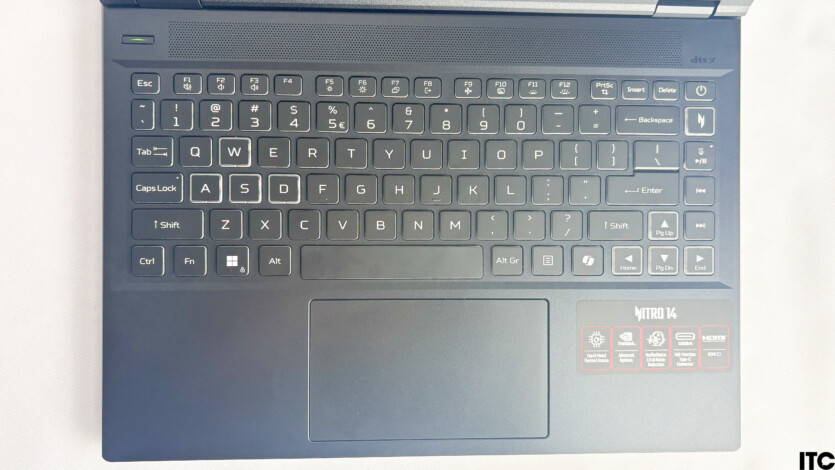
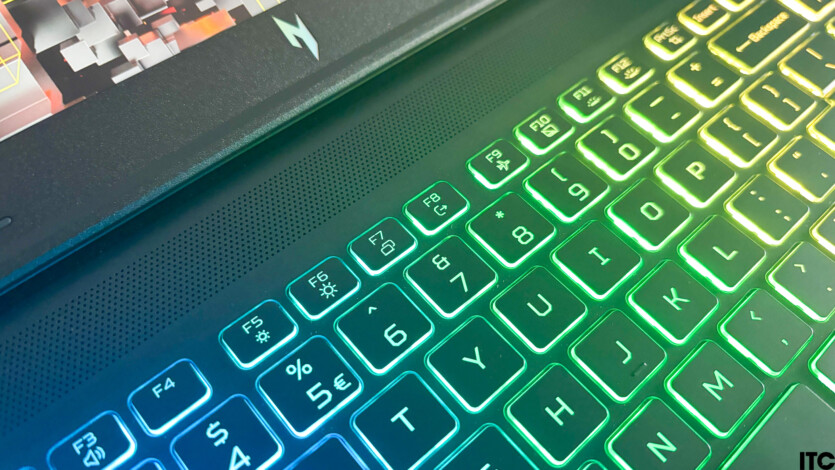
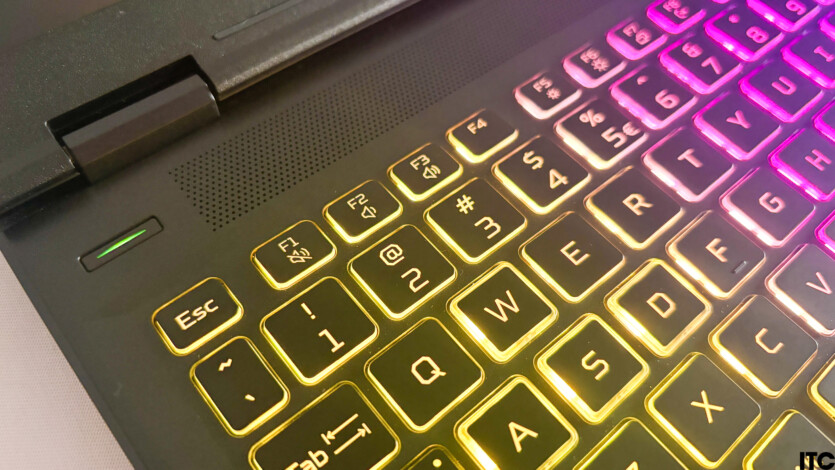
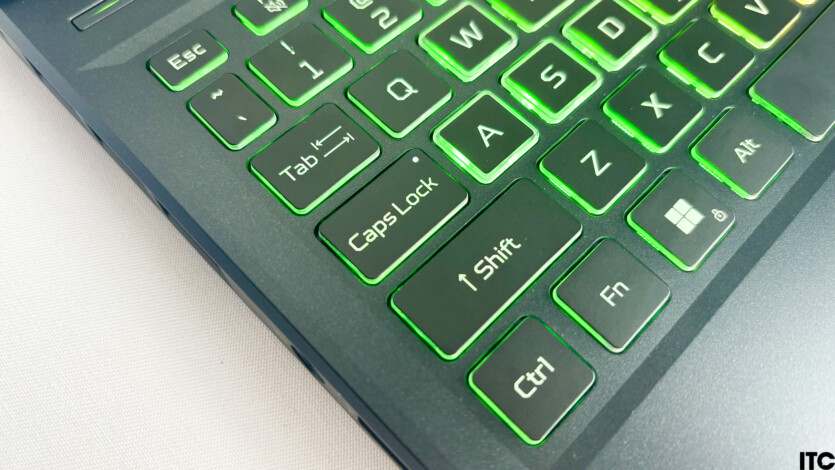
The keyboard backlight works in five brightness levels. In the settings of the Acer Nitrosence app, you can customize different modes (for example, waterfall) or even highlight individual zones for the desired color. Everything is easily customizable. To turn the backlight on or off, press F11 or F12.
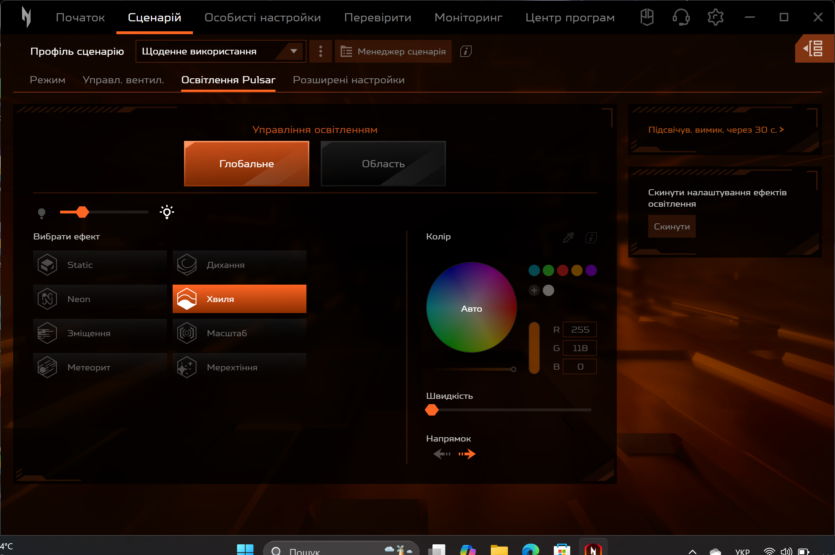

On the right side of the keyboard, there are four additional function keys: three keys for music control and one paired with a microphone on/off indicator and a key to call the Acer Nitrosence application. Above them is the laptop power button. At first, you will get used to not pressing them.
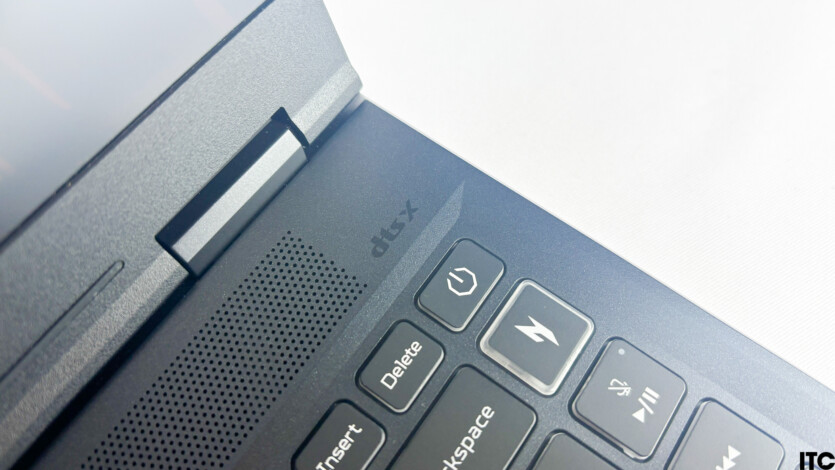
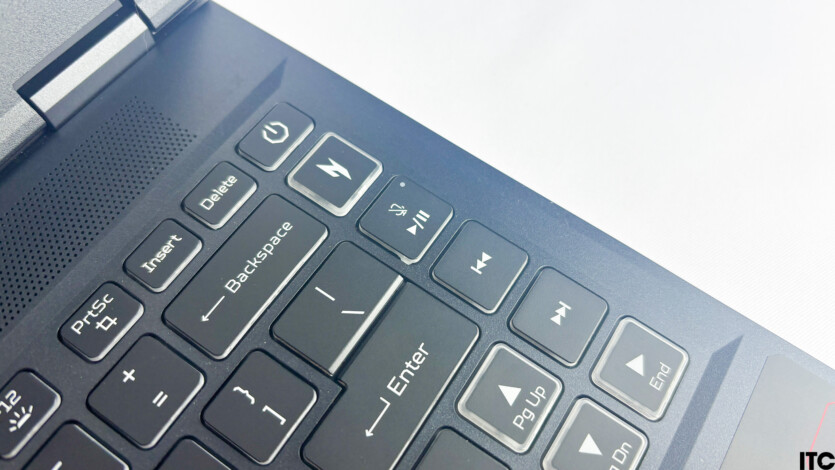
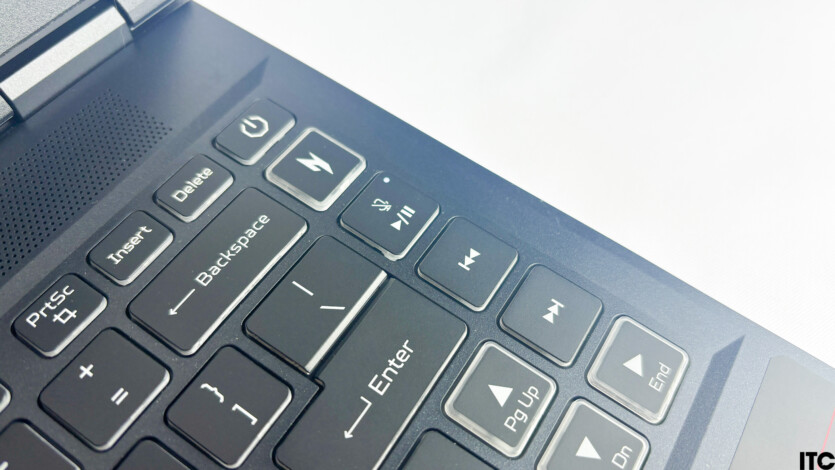
At the top left is a key for changing the laptop’s power consumption modes with a corresponding indication. As you can see, there are six types of operating modes. However, I will tell you more about them in the section «Performance»:
- Green — Quiet (with Battery)
- Orange — Balanced (with Battery or PSU)
- White — Quiet (with Power Supply)
- Red — Performance (available only with PSU);
- Purple — Turbo (available with PSU only).
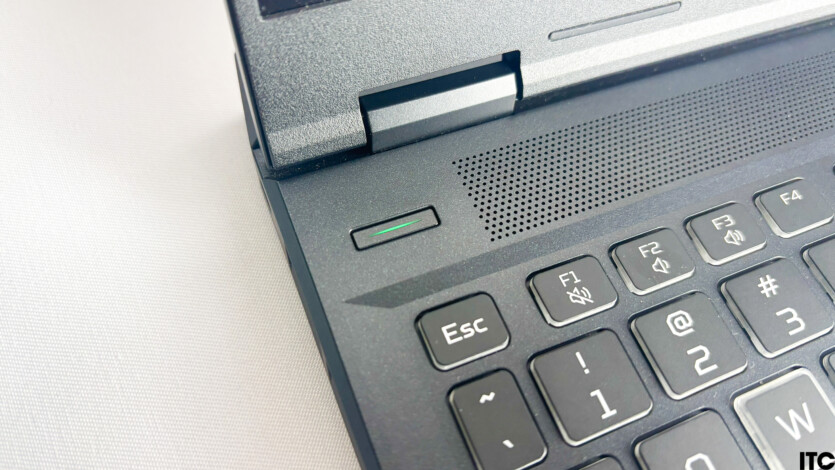
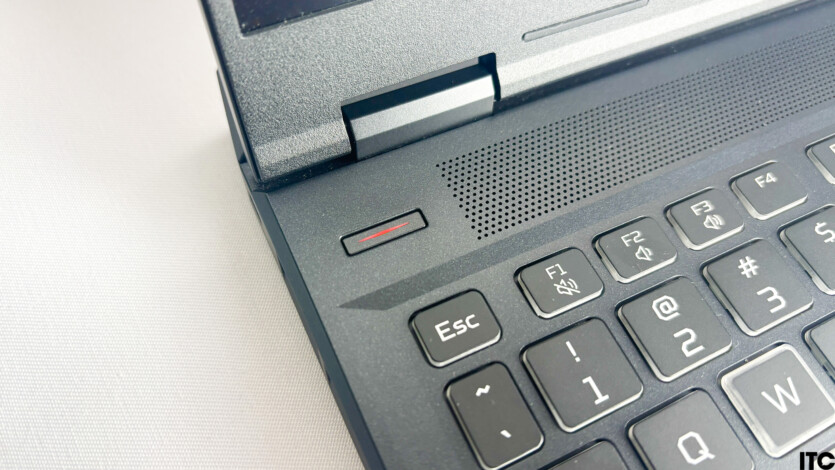
Instead of the right Ctrl, there is a new function key to launch the AI assistant Copilot. I’m not sure if it was worth separating this functionality into a separate key, but these are the general trends.
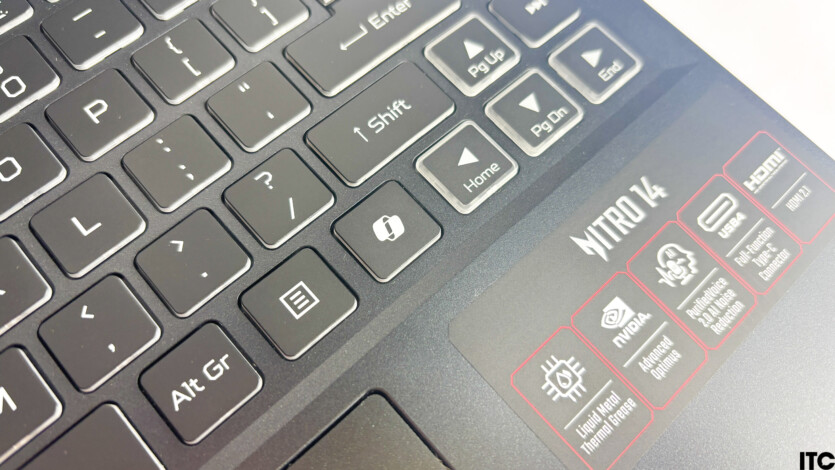

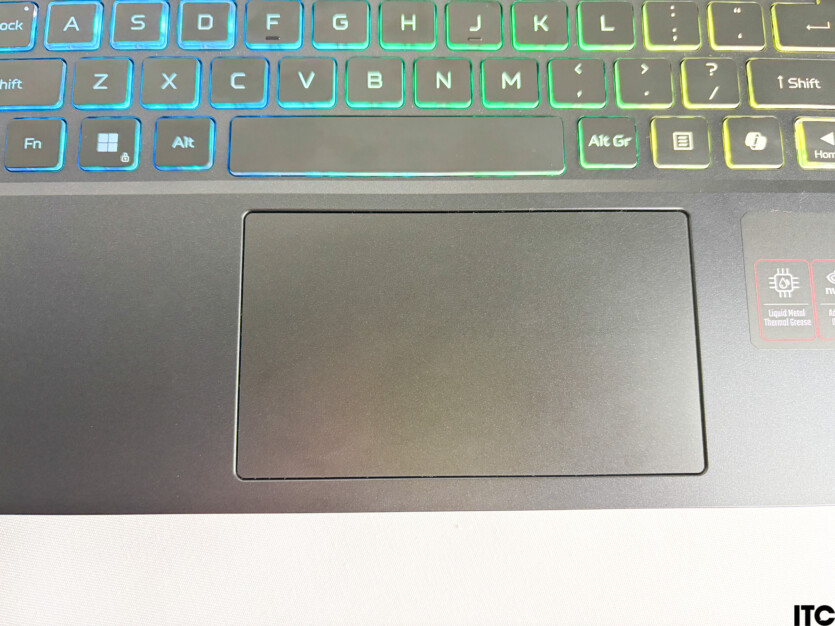
The Acer Nitro 14 (AN14-41-R6) laptop has a fairly large touchpad. I give it an above-average rating, but I want better tactile feedback.
Display Acer Nitro 14 (AN14-41-R6)
The Acer Nitro 14 (AN14-41-R6) is equipped with a matte 14.5-inch IPS screen with a resolution of 2560 x 1600 pixels. Its aspect ratio is 16:10, and the pixel density is 216 PPI. Therefore, you will not see individual pixels and the picture will be clear.
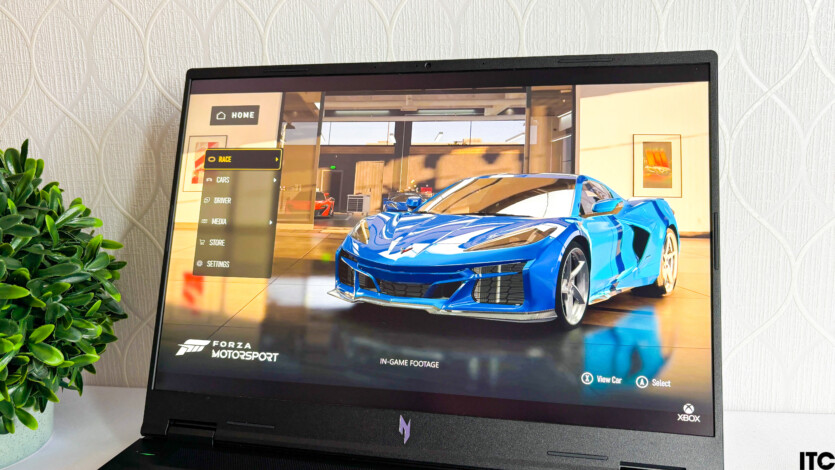


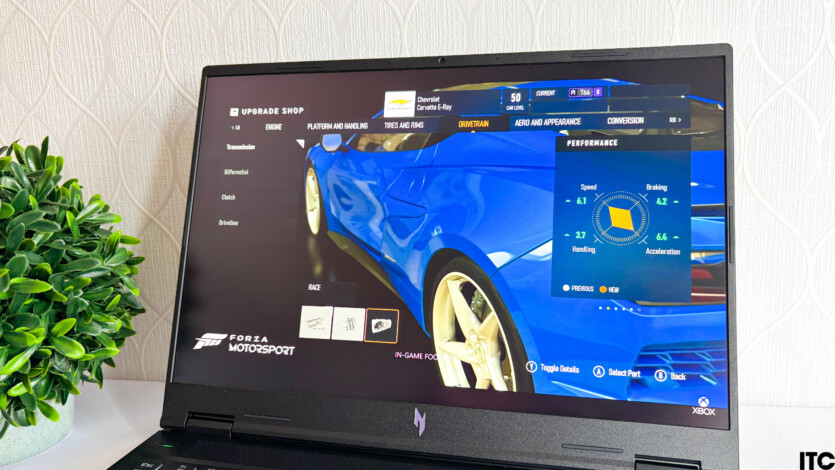
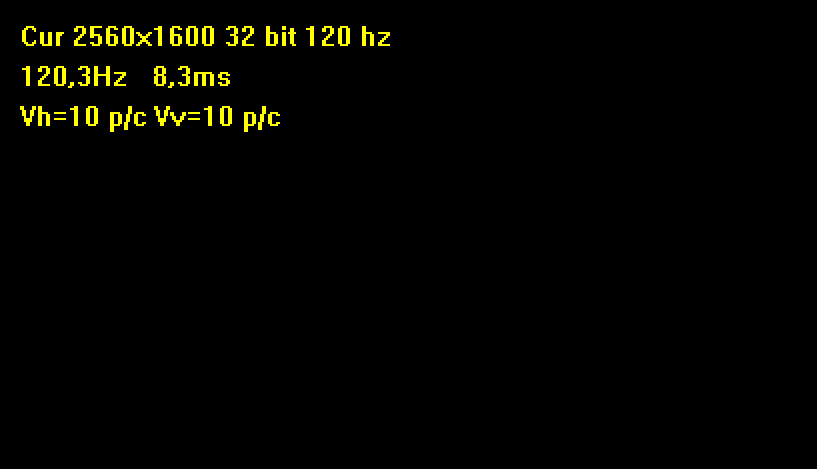
The maximum frequency is 120 Hz and the response time is — 8 ms. This is also a good indicator, which allows you to achieve high smoothness in the user interface of the operating system and is suitable for gaming.
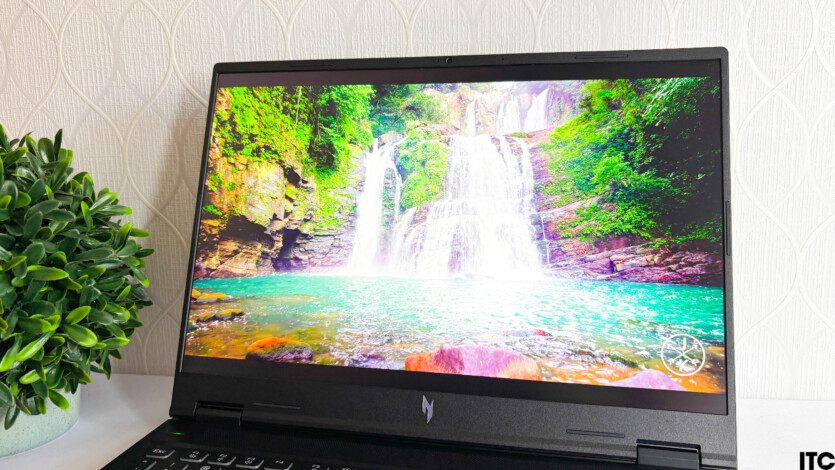
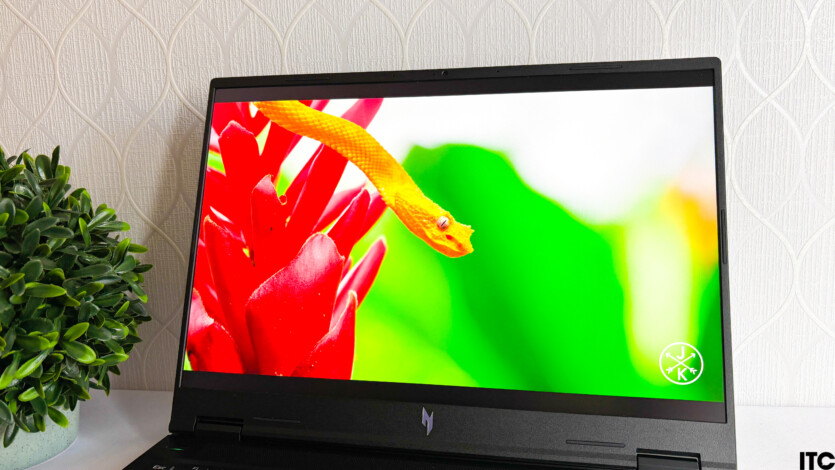
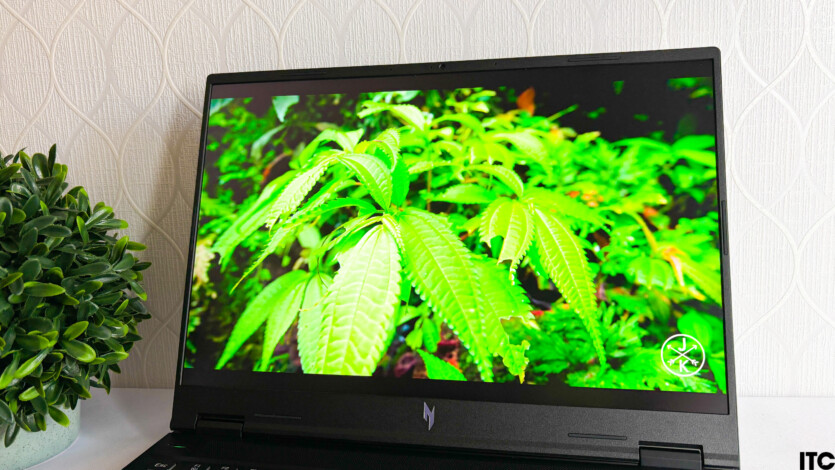
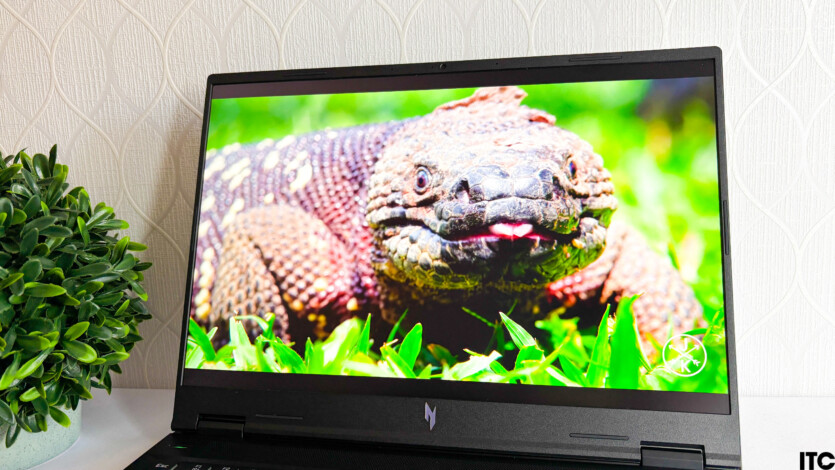
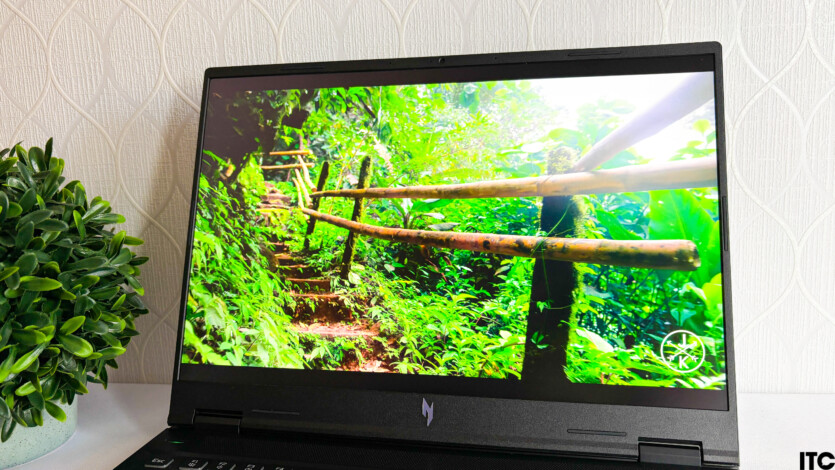
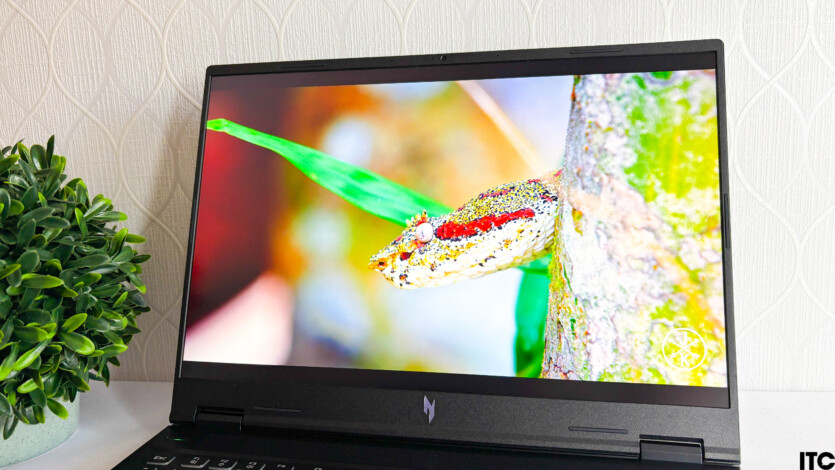
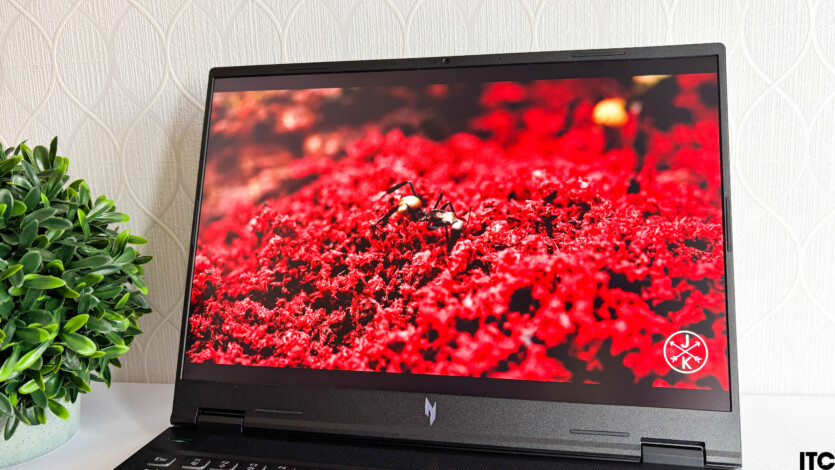
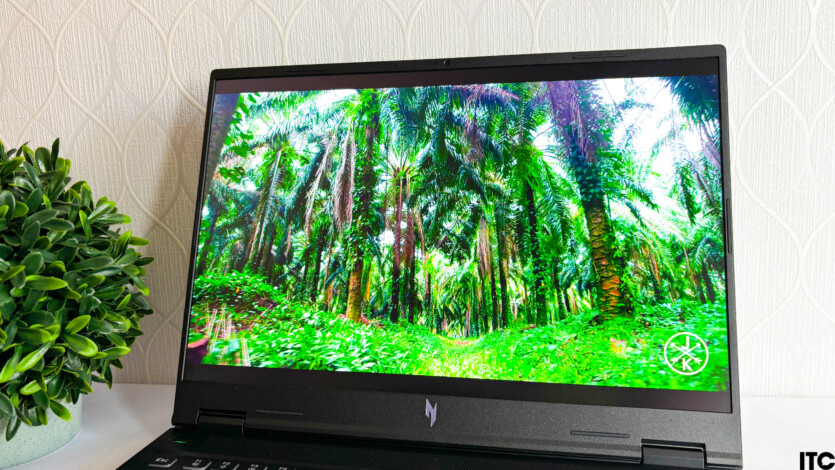
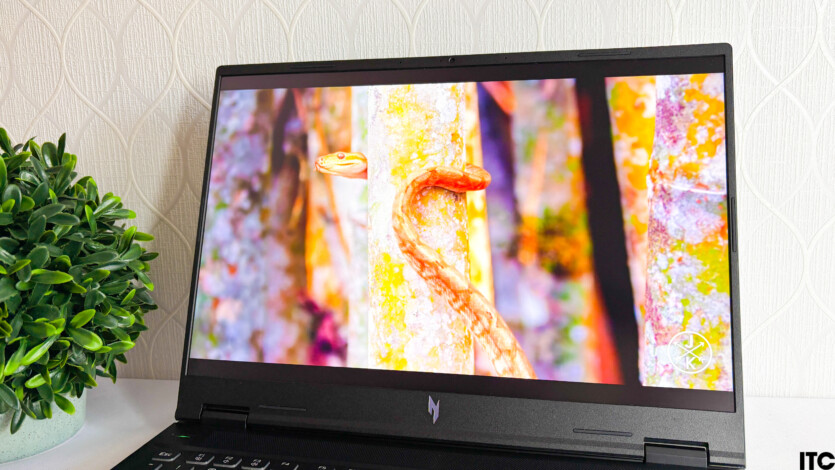
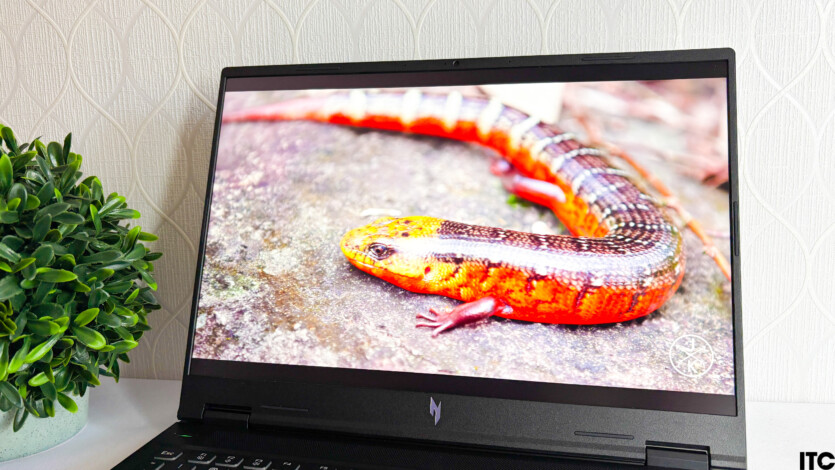
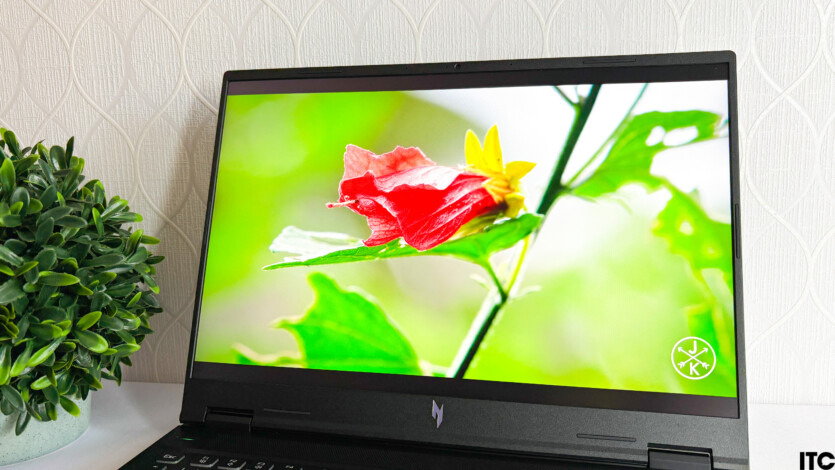
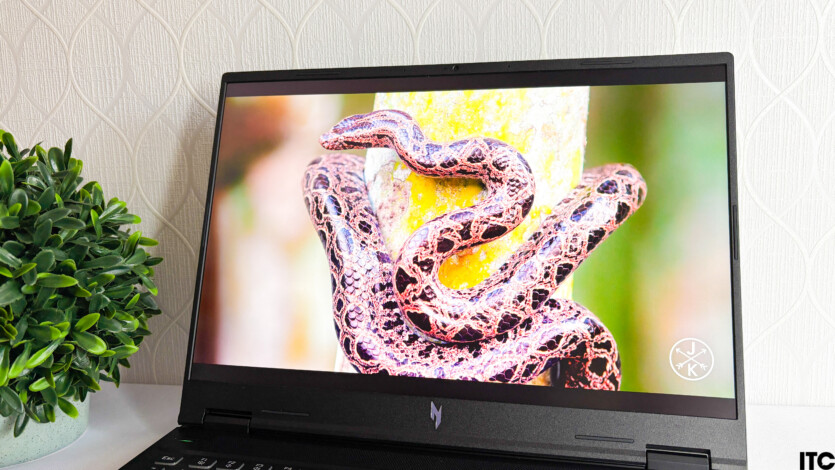
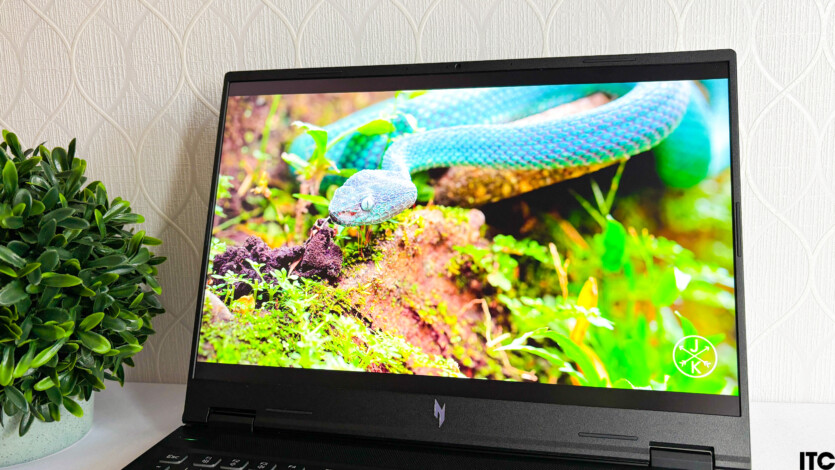
Acer promises a sRGB color gamut of 100%, with DCI-P3 color gamut coverage of 72%. This should be enough for most users. However, NVIDIA G-Sync — a function that eliminates freezing and jerking of the image is especially for gamers. It is enabled by default in CS2.
Proprietary software
The Acer Nitro 14 (AN14-41-R6) test laptop comes with Windows 11 Pro installed. Therefore, the manufacturer has preinstalled all the necessary initial drivers and proprietary programs: Acer QuickPanel, Acer PurifiedView, Acer Purified Voice Console, and Acer Nitrosence. The first three programs are needed to control the front camera and the sound from the speakers. The last one on the list is the most interesting of them all.
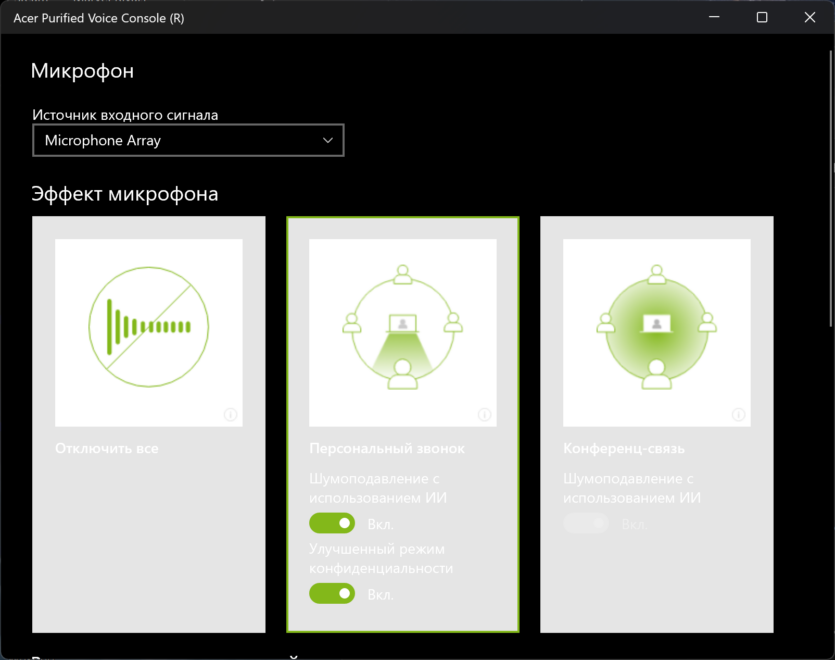
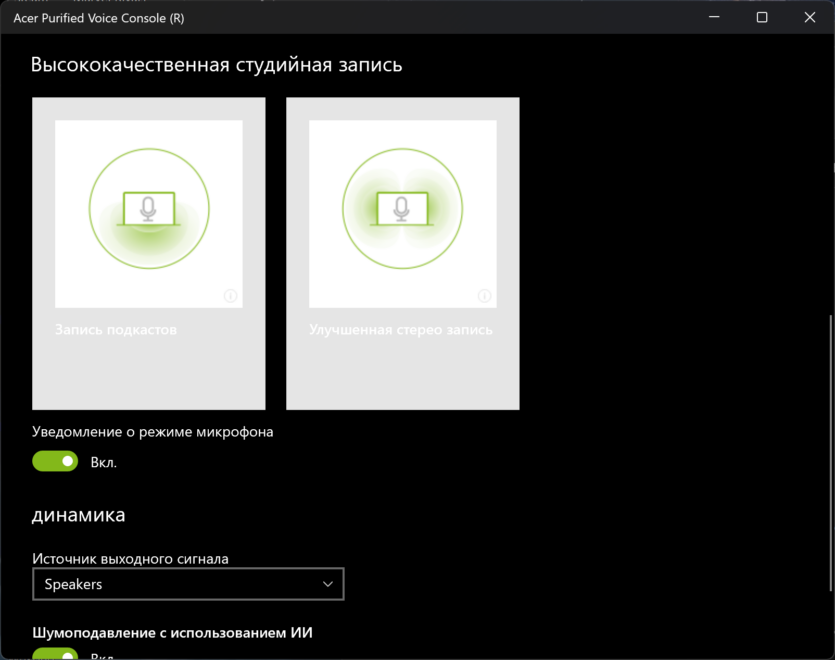
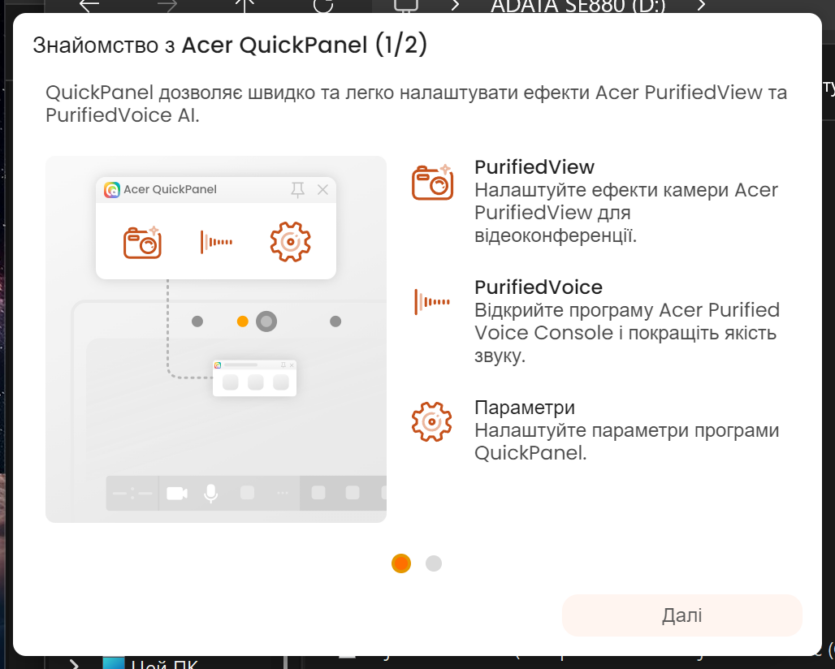
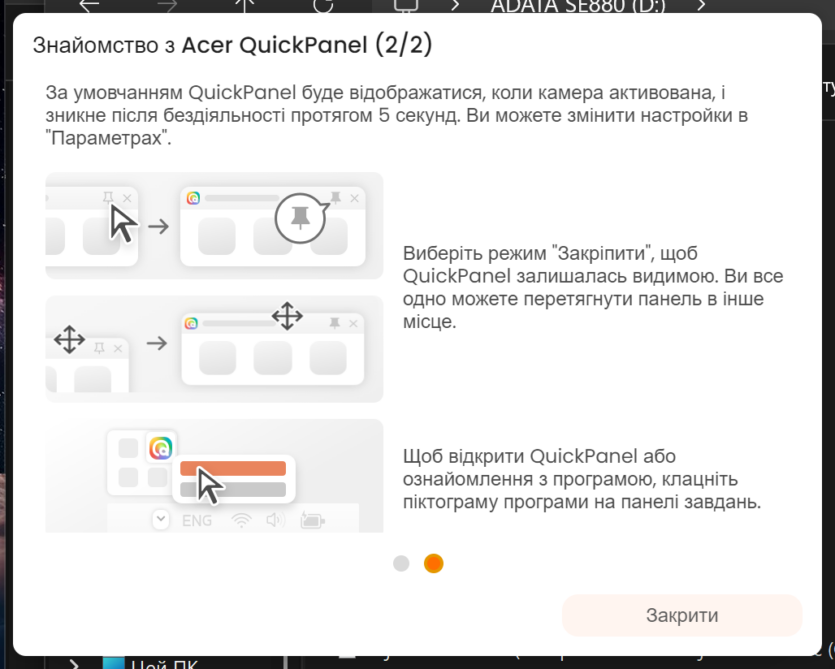
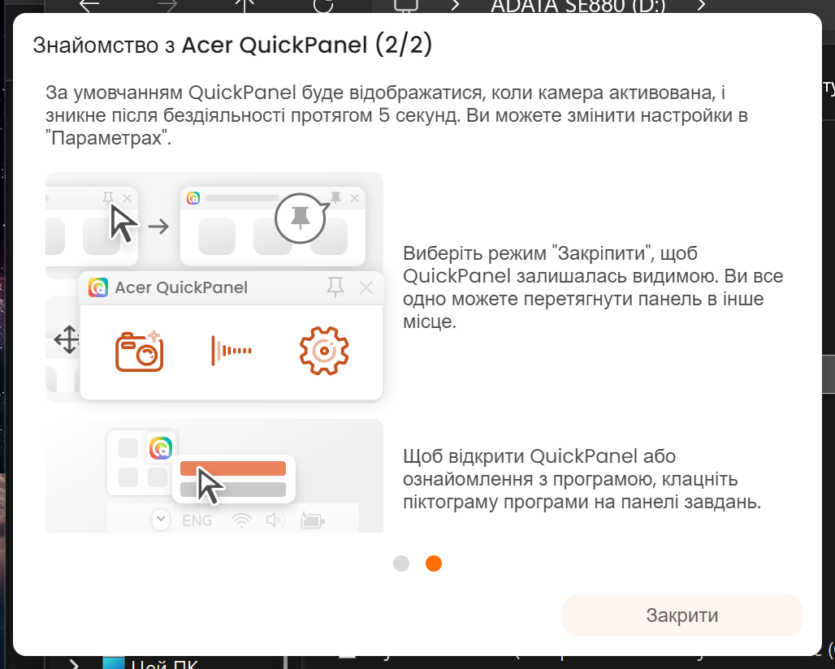
The Acer Nitrosence application is launched using a separate key in the right block of the keyboard. The user interface is rather «gamer», highlighted by dark and orange tones. The program allows you to customize the keyboard backlight, select and configure power consumption modes, monitor CPU and GPU temperatures, and adjust the speed of the coolers.
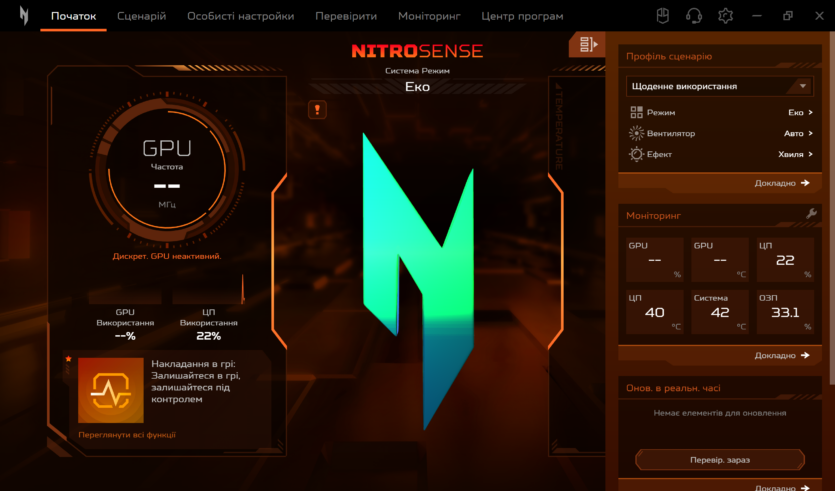
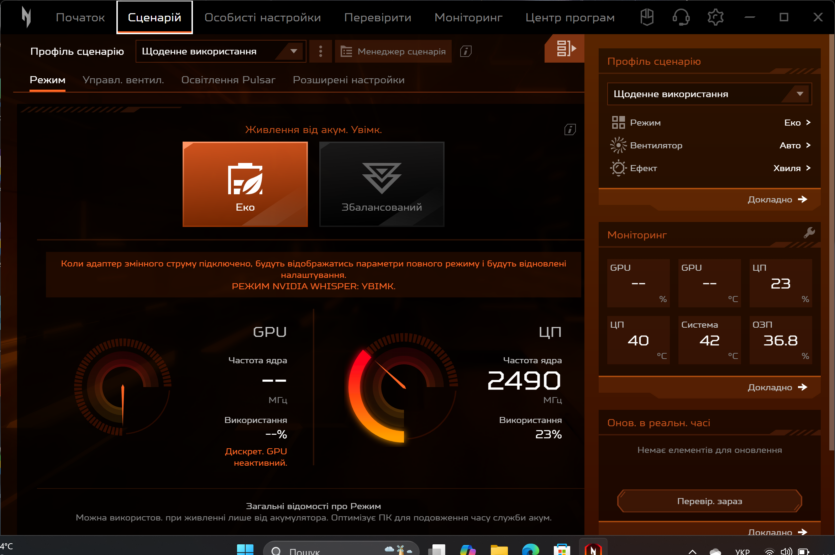
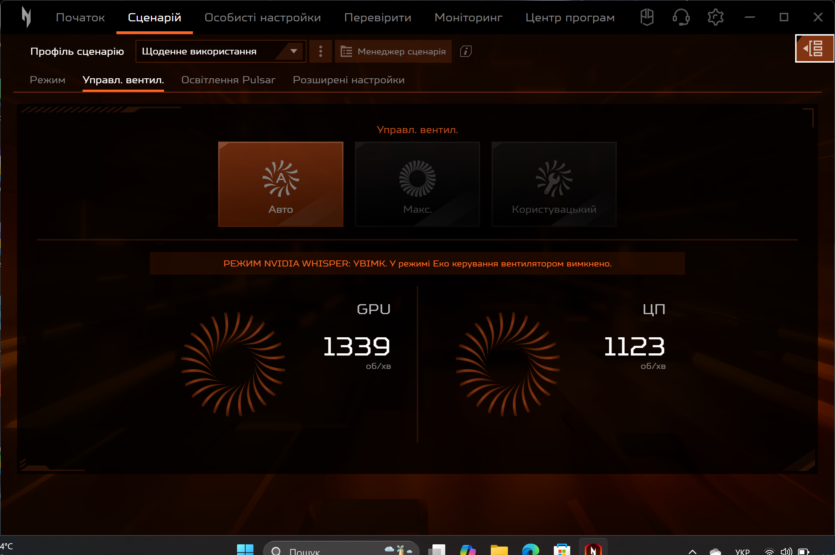

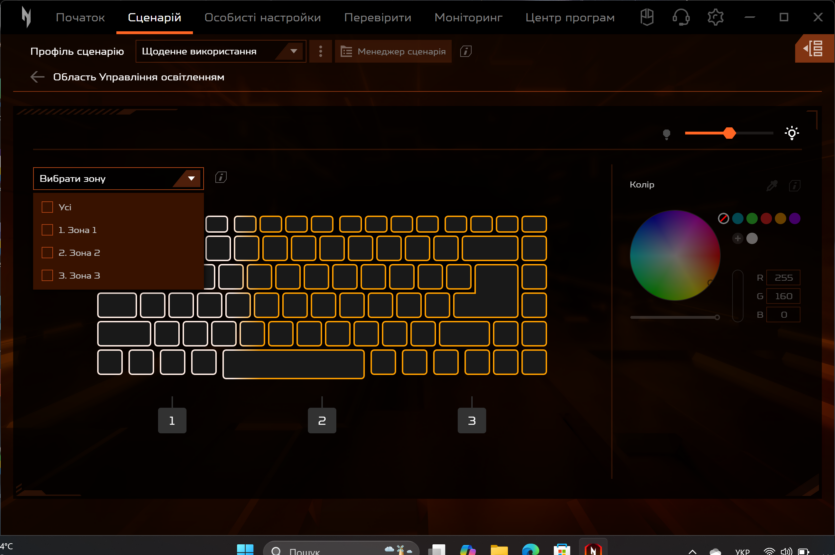
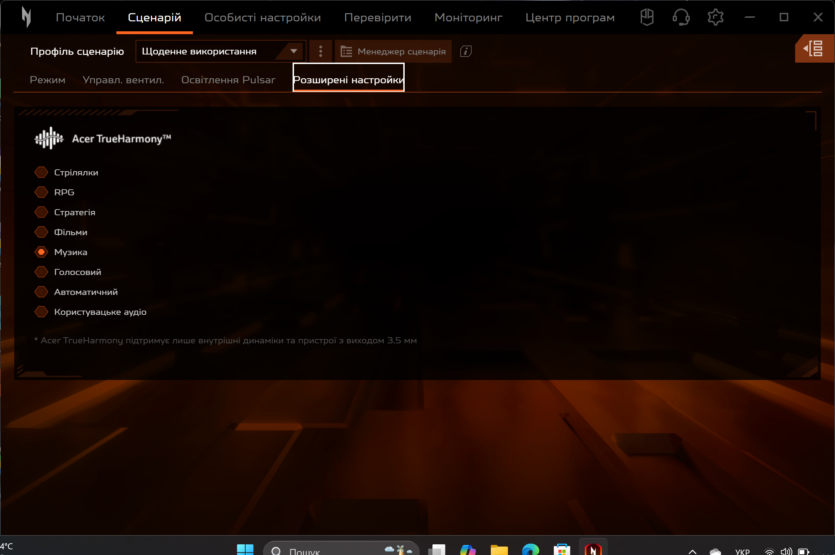

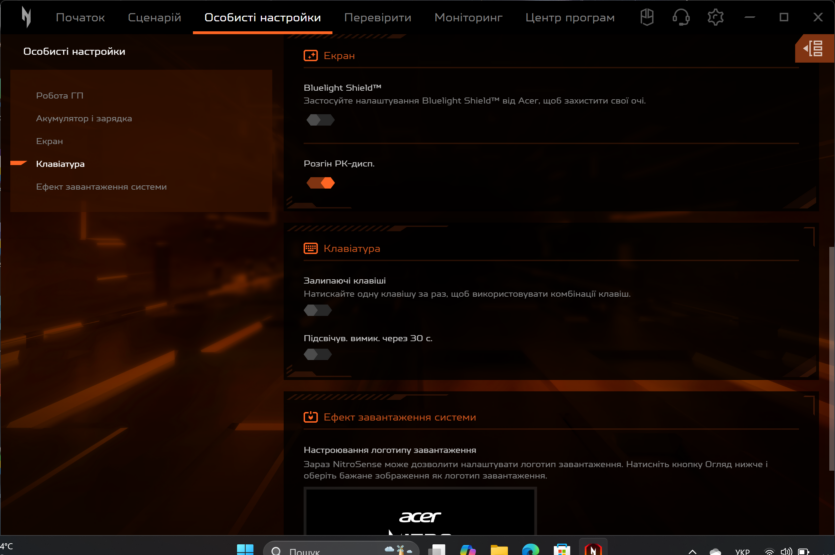
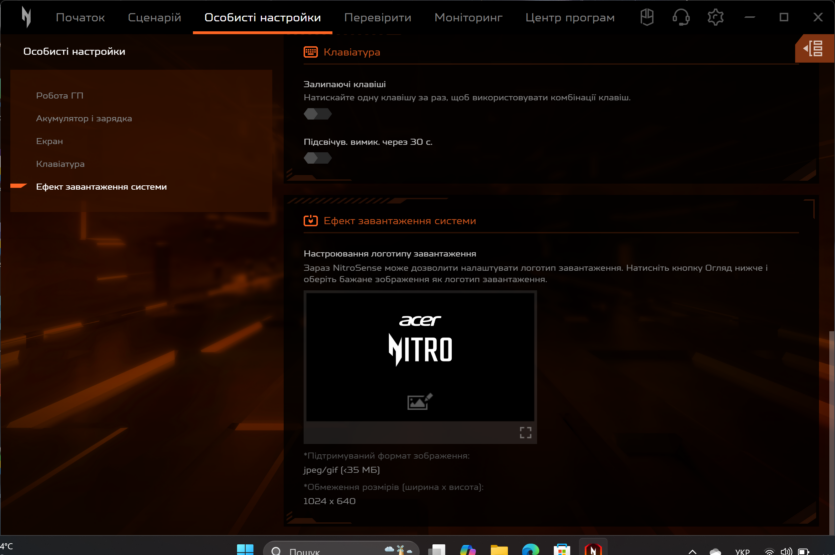
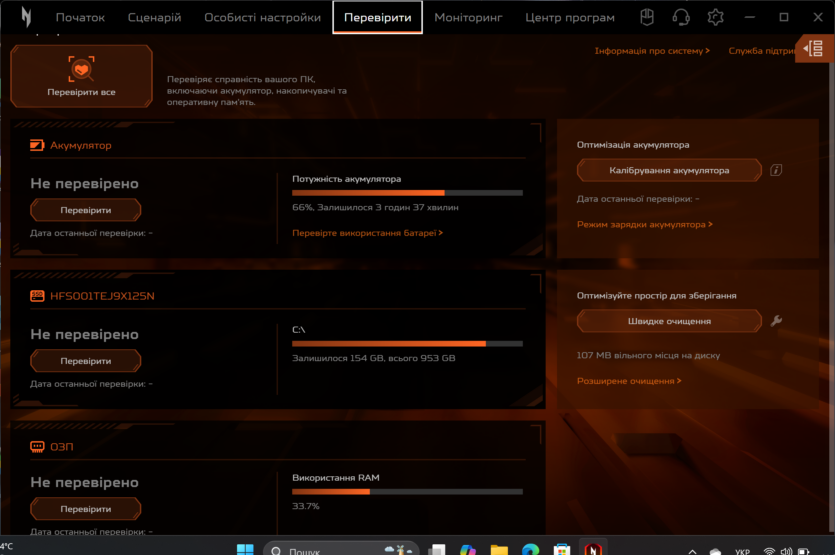

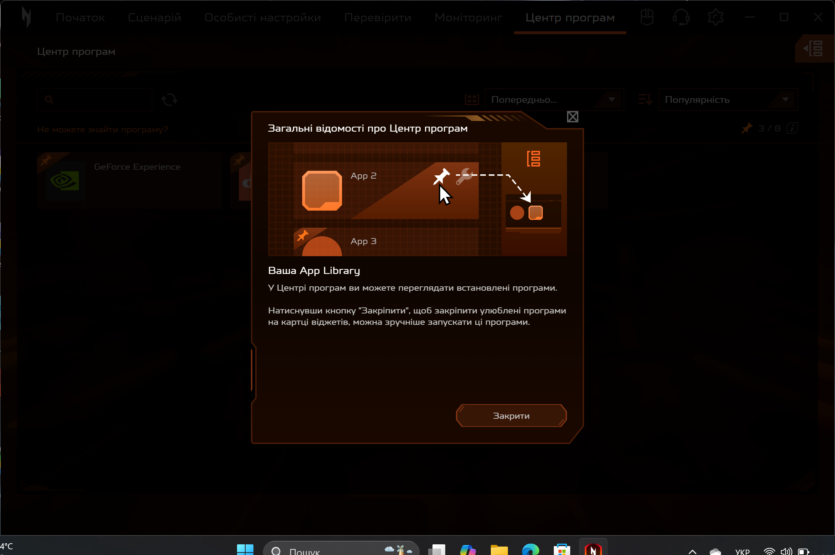
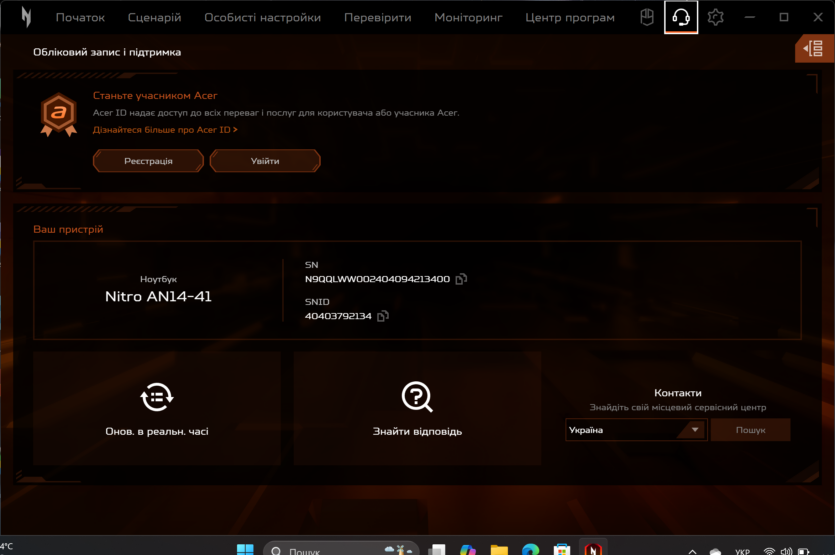

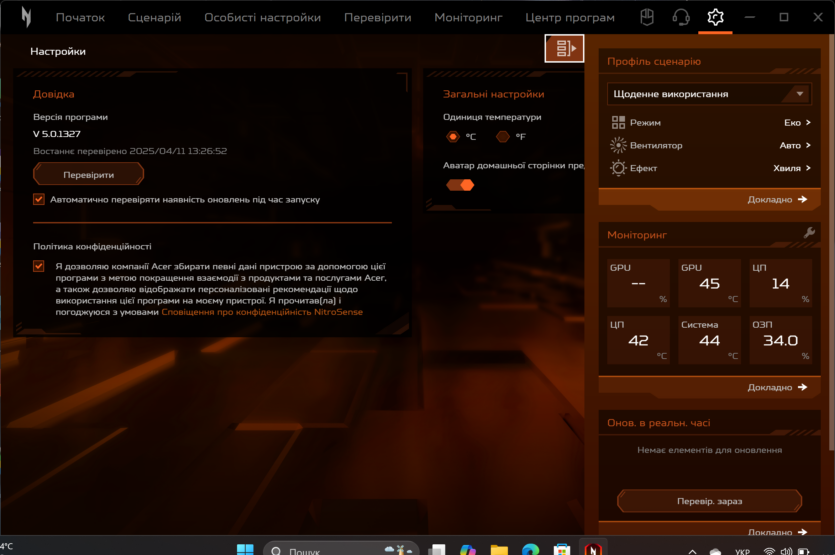
It was in the app that we learned about the separate modes of power supply from the battery (battery) and the socket (power supply). This point can be confusing at the beginning of using the device. Each of these modes is additionally customizable. As mentioned above, a separate button on the upper left side of the case, above the keyboard unit, is used to quickly switch between these modes.
Acer Nitrosense allows you to conduct a full diagnosis of the laptop, which you may need to quickly check when buying it and optimize battery performance by limiting the maximum charge to 80% of the maximum capacity. There is a separate setting for using USB when the laptop is turned off.
Acer Nitro 14 (AN14-41-R6) performance and benchmarks
The Acer Nitro 14 (AN14-41-R6) laptop is powered by an AMD Ryzen 7 8845HS processor. It stands out for its good built-in AMD Radeon 780M graphics (RDNA3; 12-core; 2700 MHz) and high performance thanks to its architecture: 8 cores / 16 threads with a maximum frequency of 5.1 GHz. The base TDP is 45 W. L2 and L3 cache size is 8 MB and 16 MB respectively.





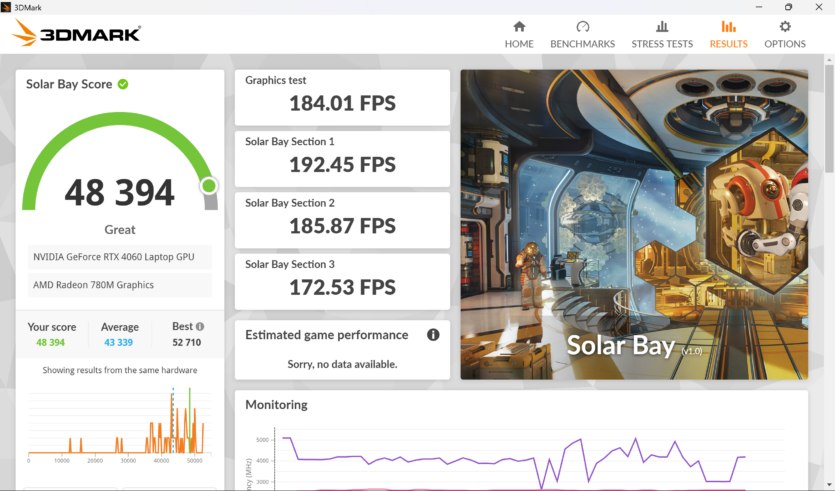
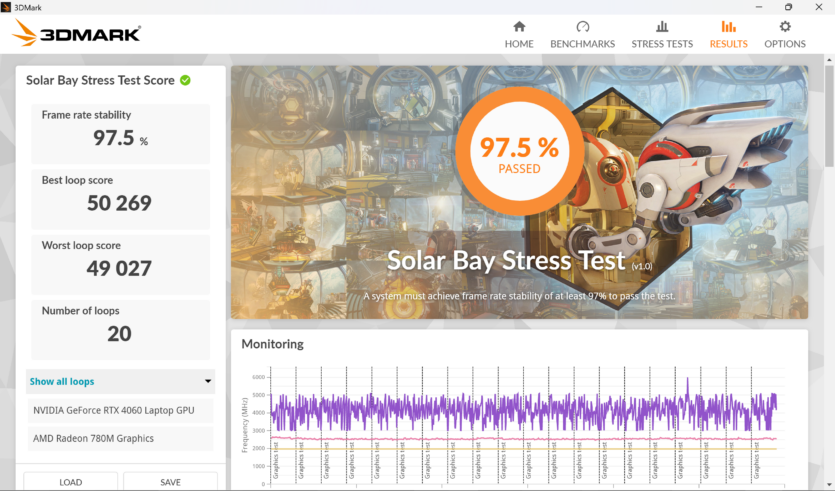
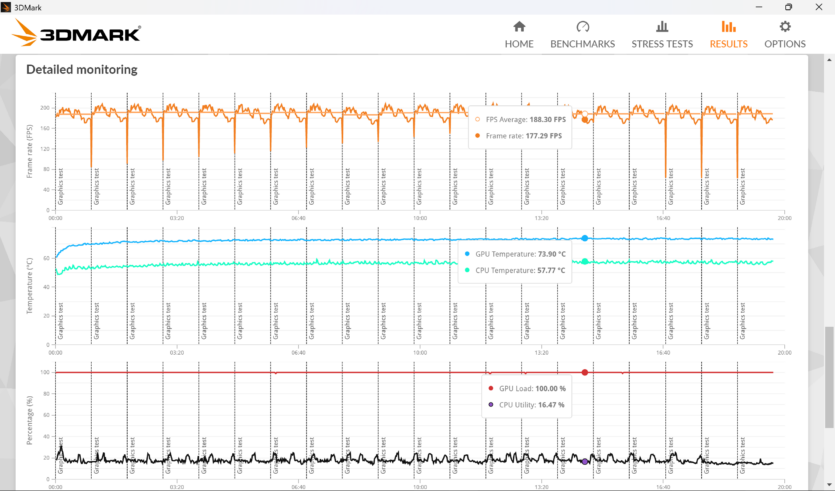
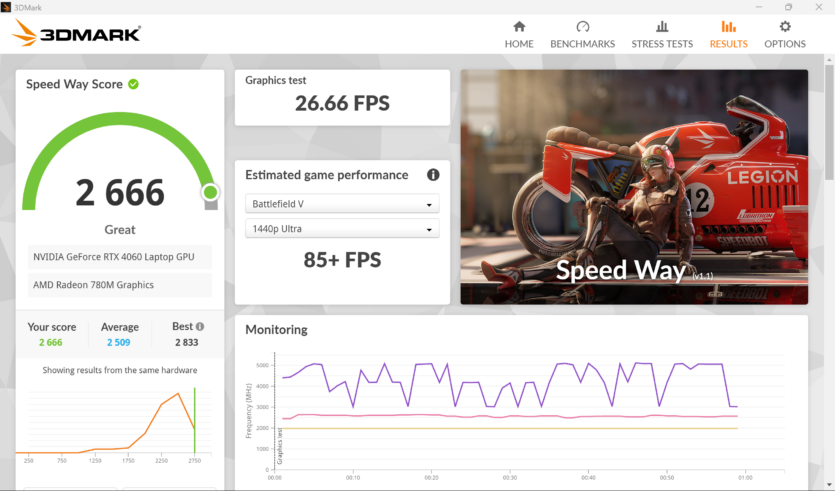

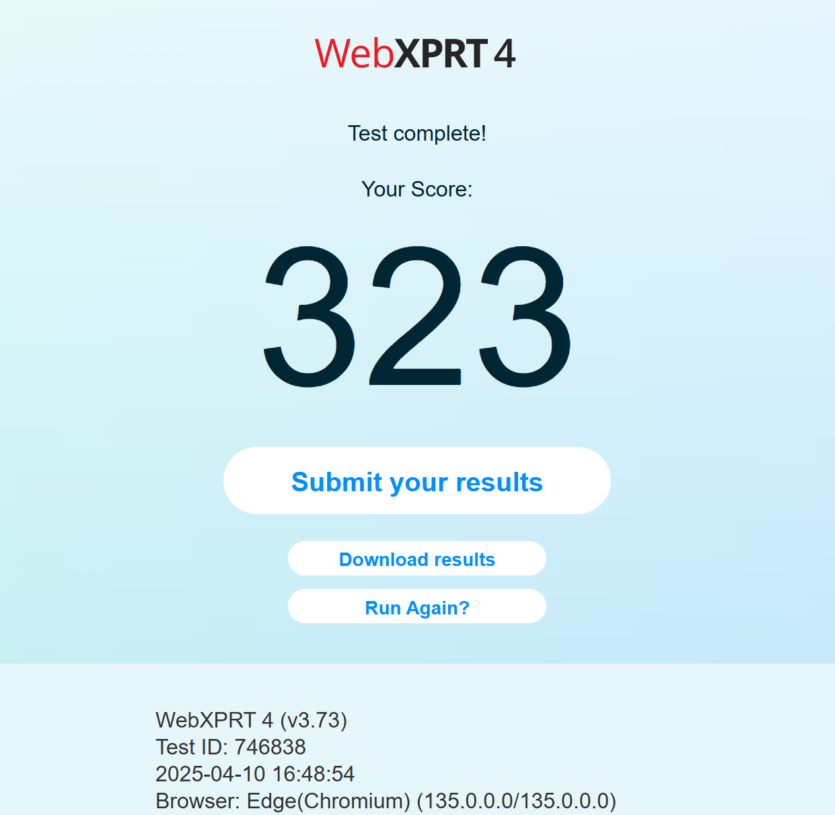
The cooling system consists of two fans and two thick copper heat pipes that are shared by the CPU and GPU. For better thermal conductivity, the so-called «liquid metal» is used. Unfortunately, 32 GB of LPDDR5x-6400 RAM is soldered on the motherboard. You can’t add more memory.
The Acer Nitro 14 (AN14-41-R6) laptop has only one M.2 slot of 2280 size with PCIe 4.0 x 4 support. This is a standard SSD, so it showed good results in the CrystalDiskMark test even when 75% full.
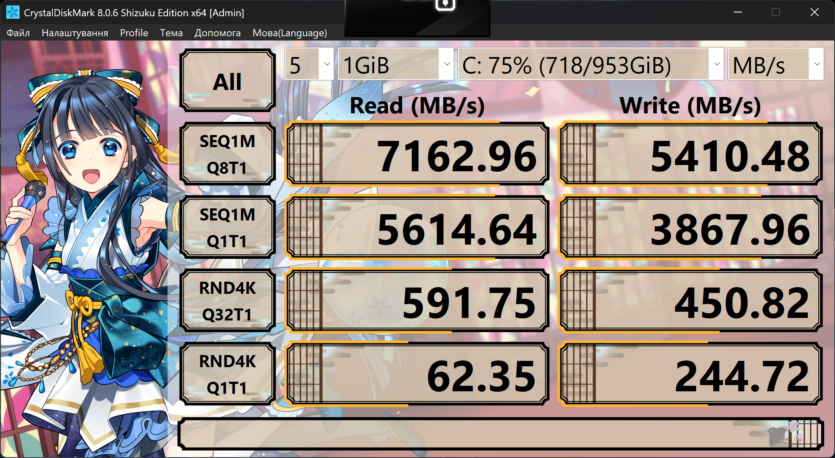

In the Cinebench 2024 test, the laptop showed good results in Turbo mode: CPU (single thread) = 102 points, CPU (multi-thread) = 944 points, and GPU (NVIDIA RTX 4060) = 10851 points.
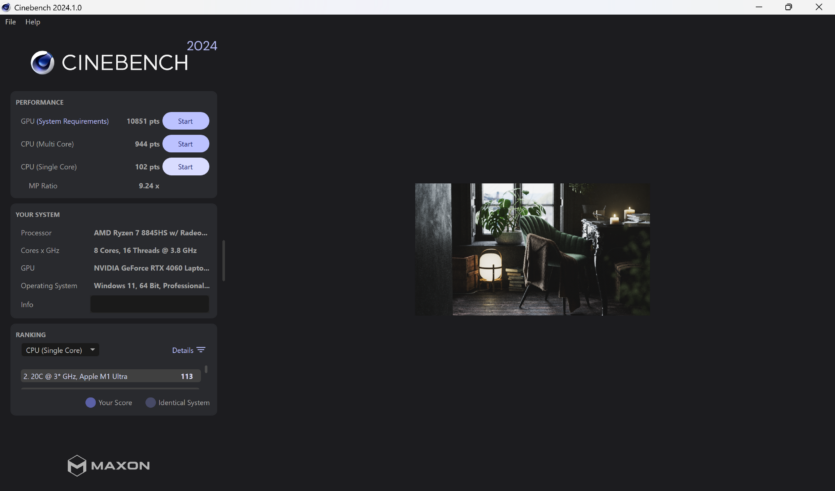
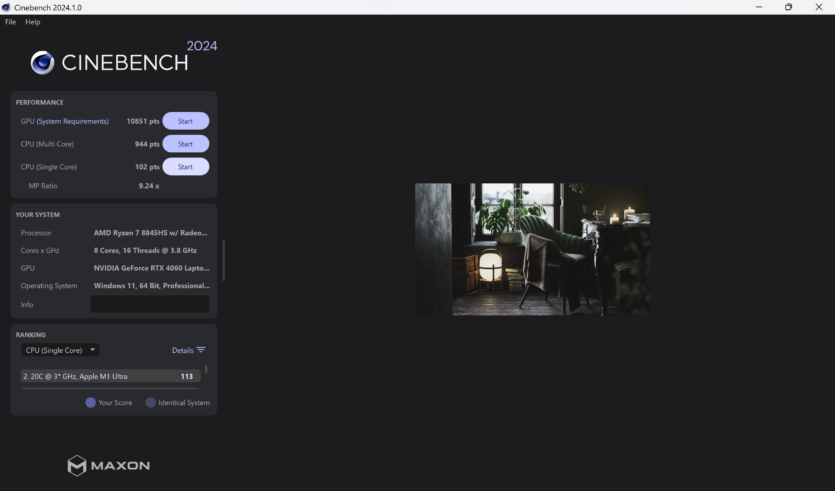
The manufacturer claims that the NVIDIA RTX 4060 discrete graphics card has a TGP (Total Graphic Power) of around 110 watts. This parameter should have a strong advantage over possible competitors. Therefore, it is necessary to check it. Let’s run stress tests in AIDA64 for the processor and Furmark according to the video card depending on the operating mode. First, here is a table of individual component tests. As you can see for yourself, the Acer Nitro 14 (AN14-41-R6) really achieves the characteristics declared by the manufacturer.
| Modes | Processor only (AIDA64) | Only NVIDIA graphics card (Furmark) |
| Т(battery, green indicator color) | 30-32 W | 30-32 W |
| Balanced (battery, orange indicator color) | 30-32 W | 30-32 W |
| Quiet (PSU, white indicator color) | 50 W | 65 W |
| Balanced (PSU, orange indicator color) | 68 W | 75 W |
| Performance (PSU, red color of the indicator | 75 W | 90 W |
| Turbo (PSU, purple indicator color) | 75 W | 113 W |
Now we need to check the utilization of the CPU and Video Card in both programs simultaneously. Here we encounter a rather strange situation: in the Quiet (PSU) mode, the TDP value for both components constantly «jumps». It seems that the laptop doesn’t know exactly who should be allocated more power: the processor or the video card. In Turbo mode, the laptop prefers the video card to the processor.
| Modes | Processor (AIDA64) | NVIDIA graphics card (Furmark) |
| Quiet (battery, green indicator color) | 25 W | 20 W |
| Balanced (AKB,orange color of the indicator) | 25 W | 20 W |
| Quiet (PSU, white indicator color) | up to 44 W | up to 60 W |
| Balanced (PSU, orange indicator color) | up to 19 W | 70 W |
| Performance (PSU, red color of the indicator | 17-24 W | 87 – 90 W |
| Turbo (PSU, purple indicator color) | 17-40 W | 110 W |
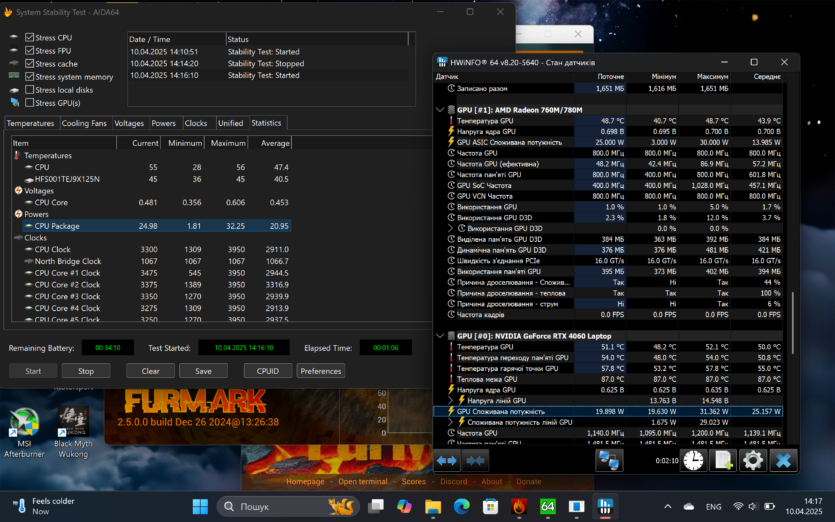
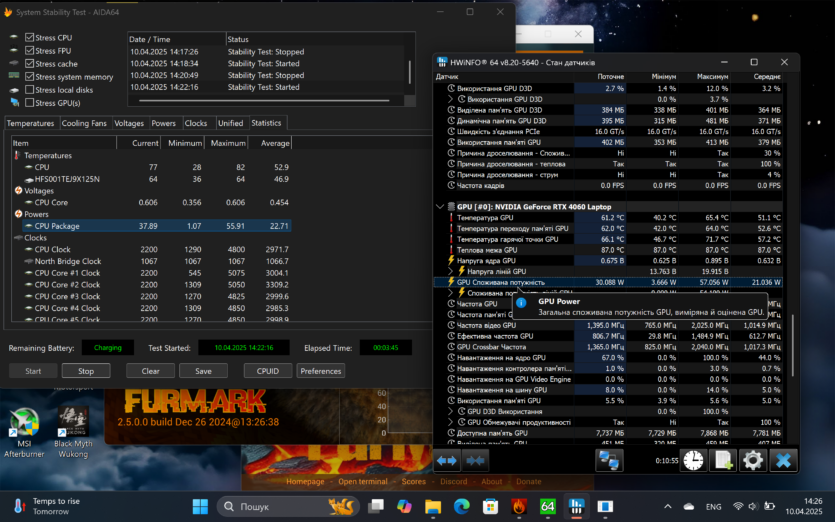
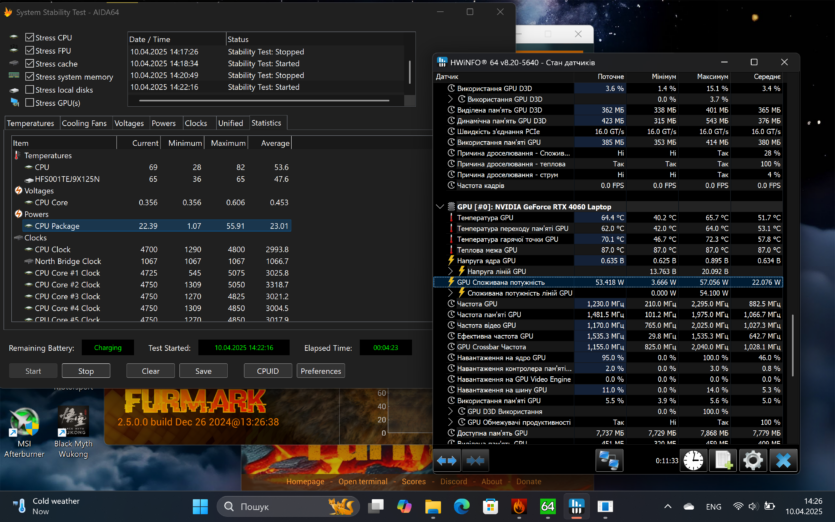
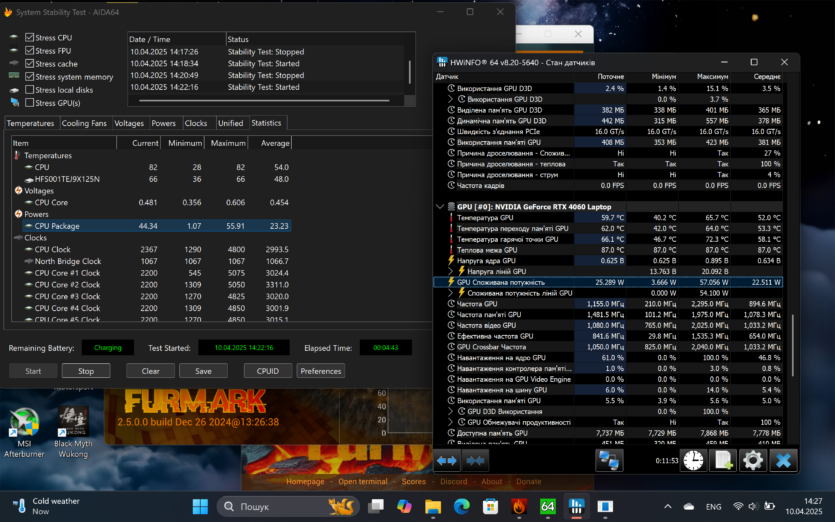
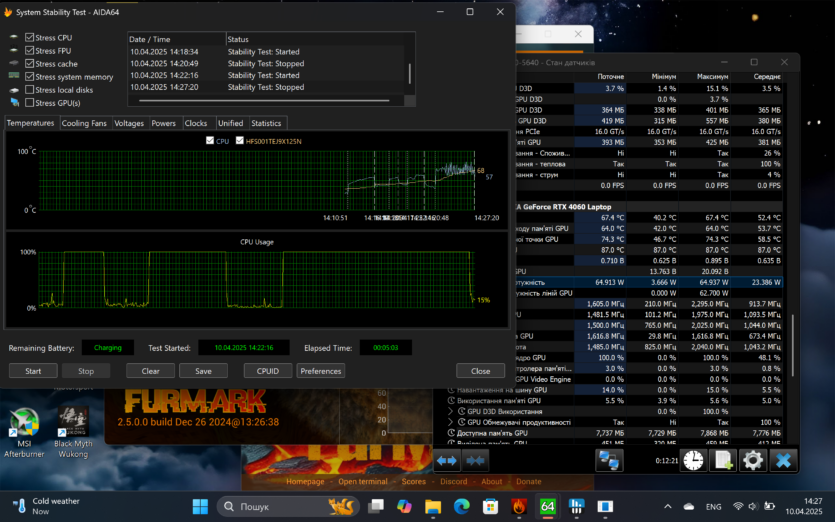
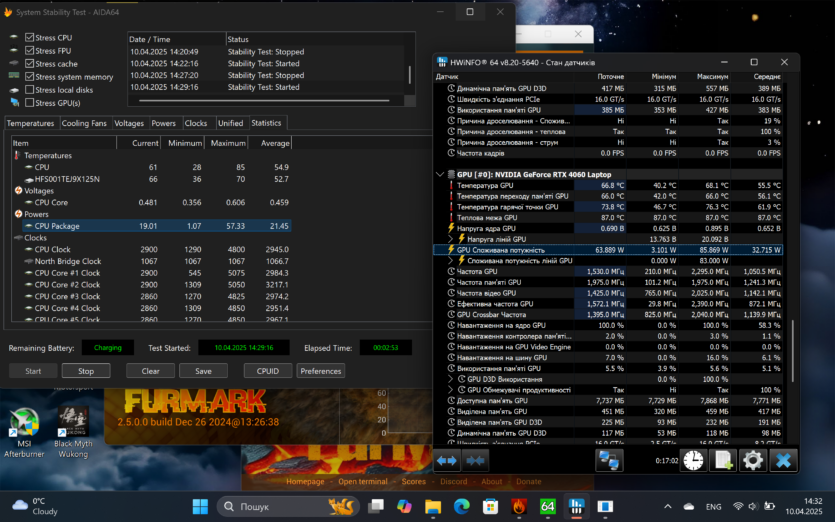
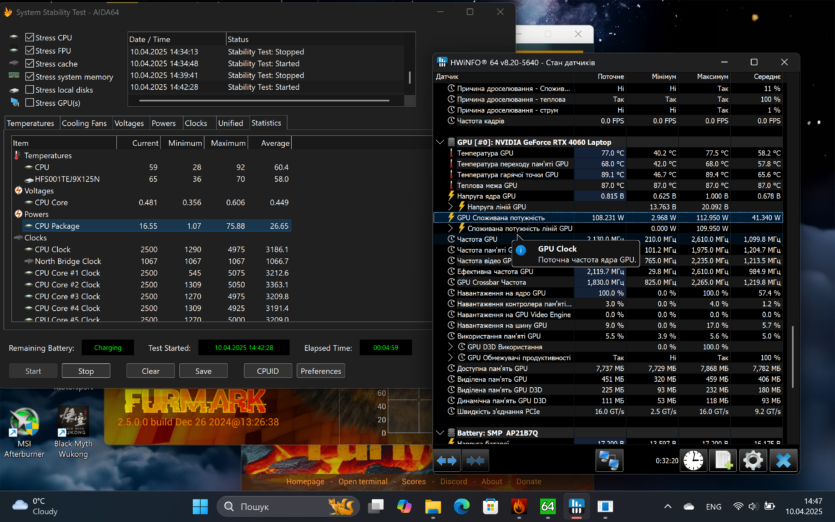
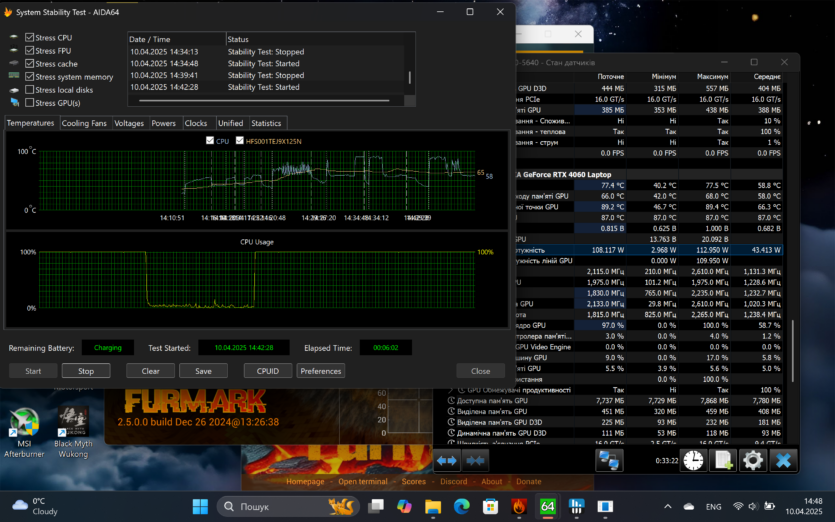
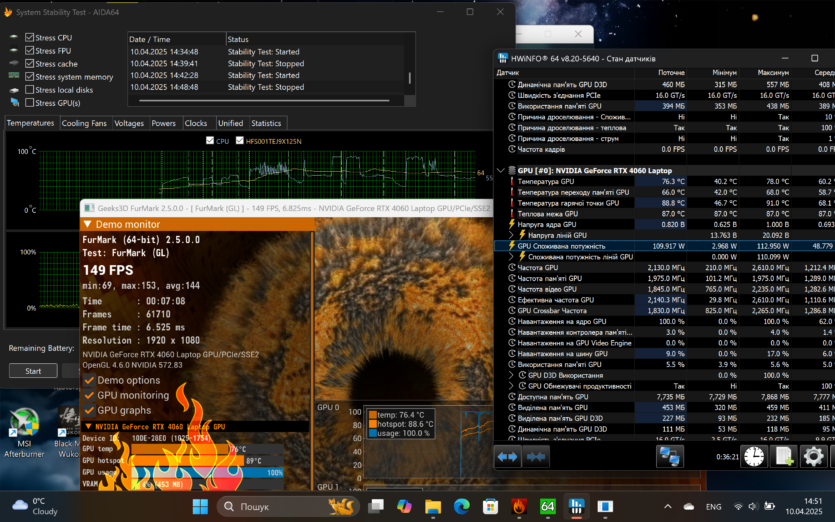
Another interesting point becomes clear from these two tables — both the Quiet and Balanced battery modes start behaving exactly the same when the load appears. This can have a negative impact on the overall energy efficiency when operating on battery power.
To check the above data in games, let’s use the game Black Myth: Wukong. Let’s apply the game’s recommended settings with Motion Blur turned off. The power consumption almost corresponds to the values in the stress tests, except that in Turbo mode it fell a little short of the preserved 110 watts.
| Modes | Processor | NVIDIA video card |
| Quiet (battery, green indicator color) | 15 W | 24-32 W |
| Balanced (battery, orange indicator color) | 15 W | 24-32 W |
| Quiet (PSU, white indicator color) | 10 W | 64 W |
| Balanced (PSU, orange indicator color) | 13 W | 73 W |
| Performance (PSU, red color of the indicator | 18 W | 86 W |
| Turbo (PSU, purple indicator color) | 30 W | 107 W |
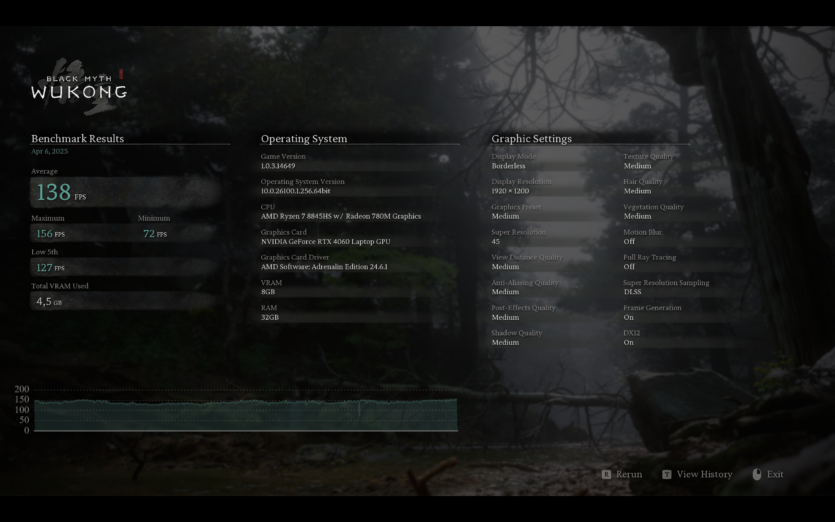
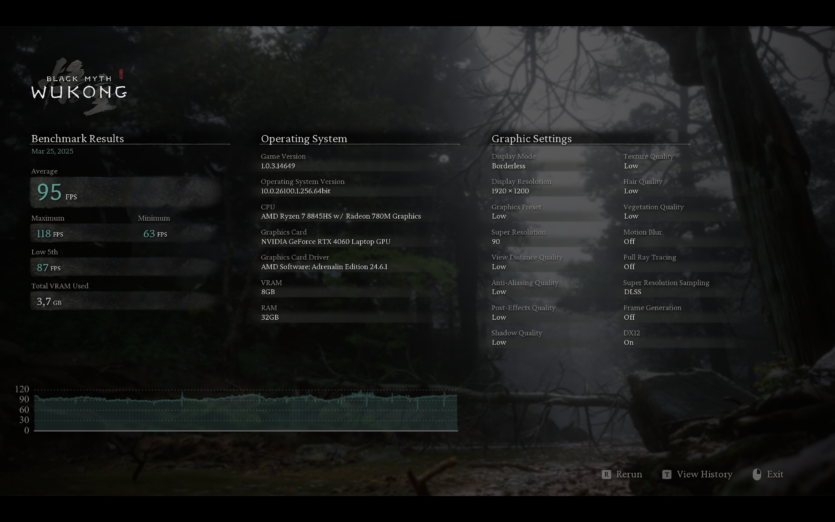
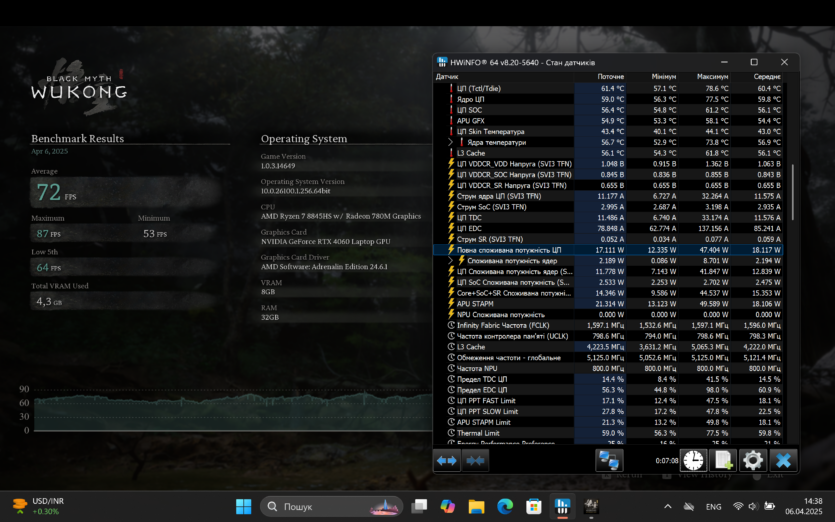
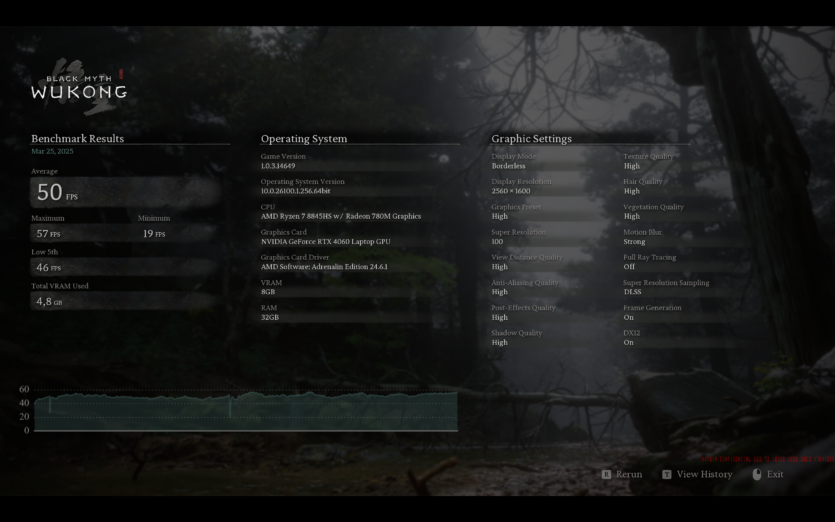
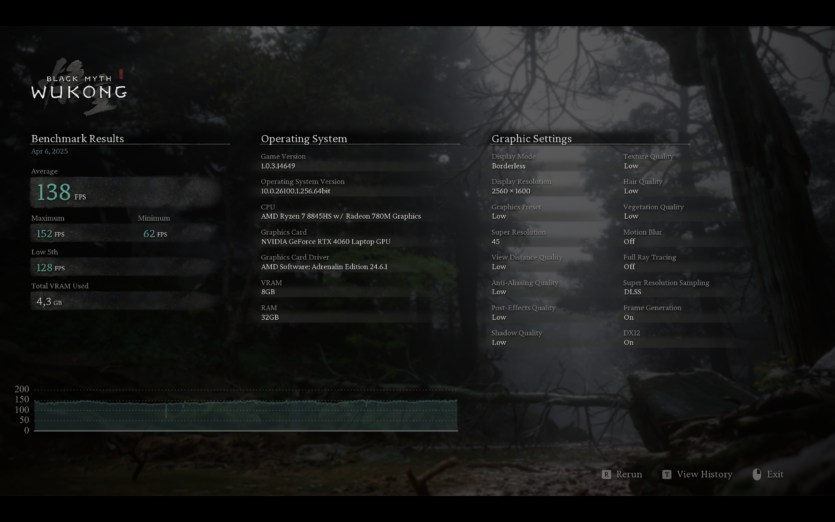
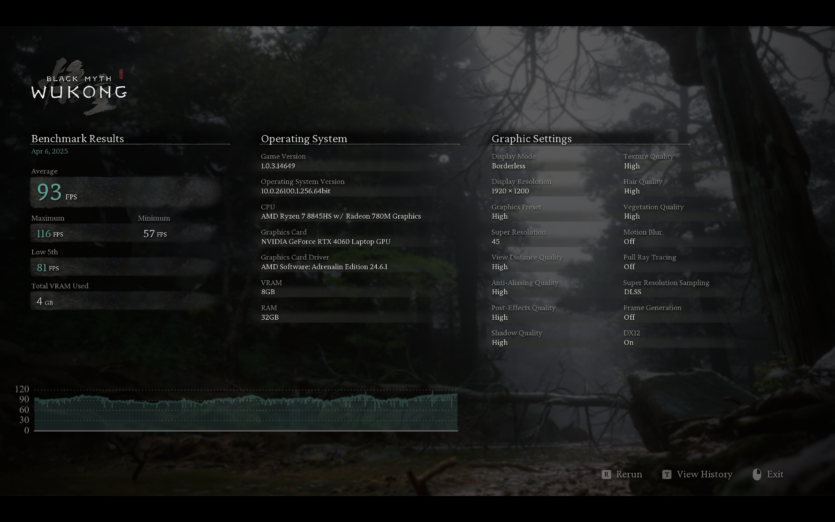
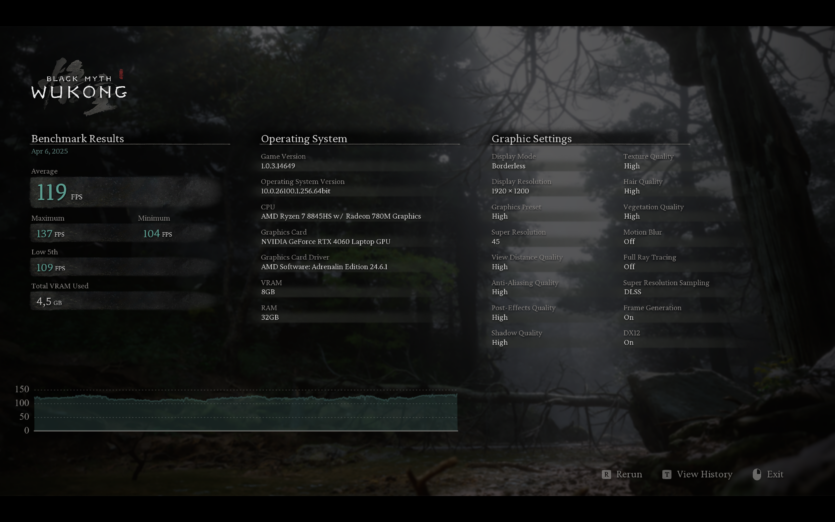
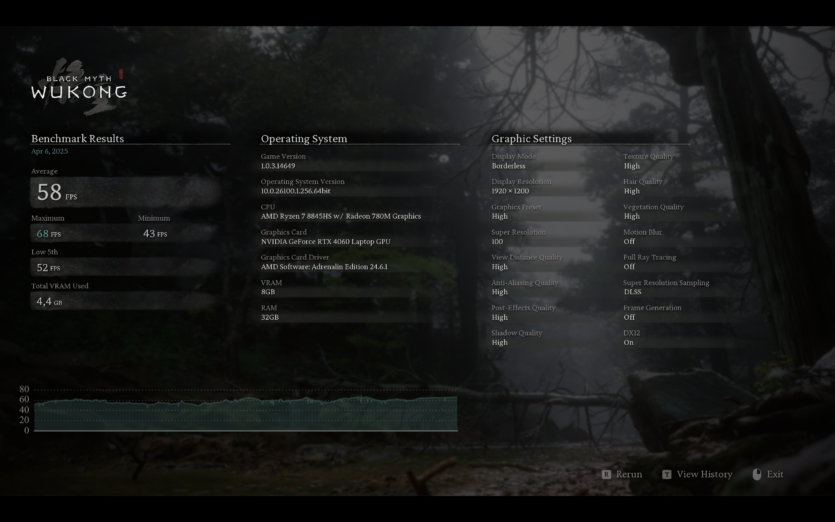
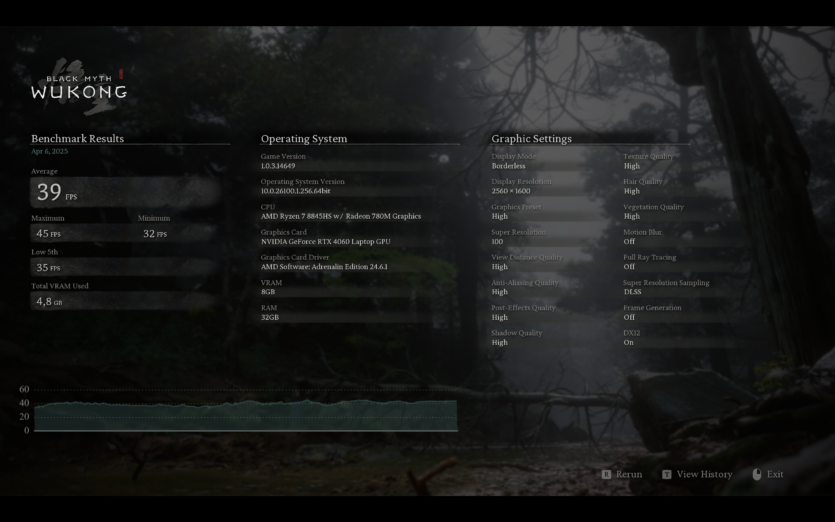
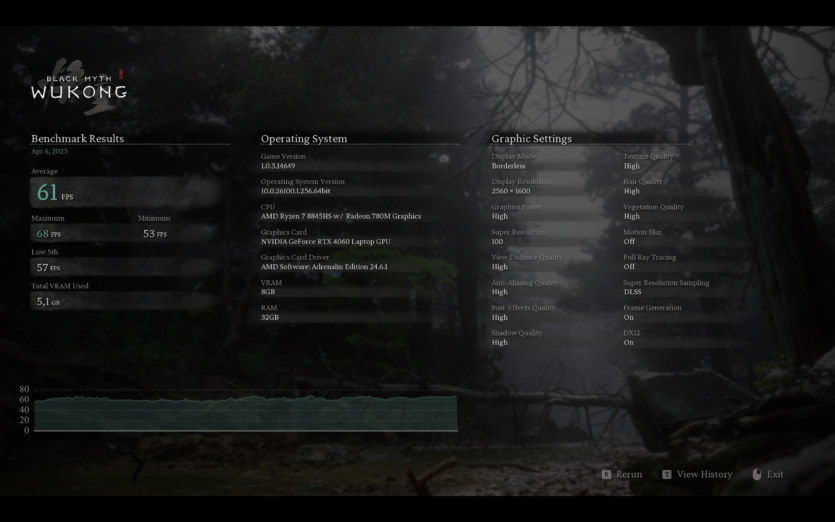
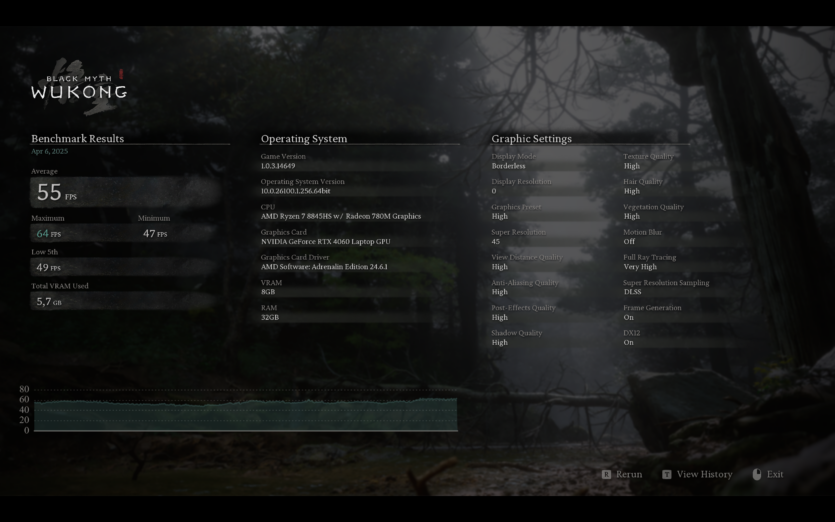

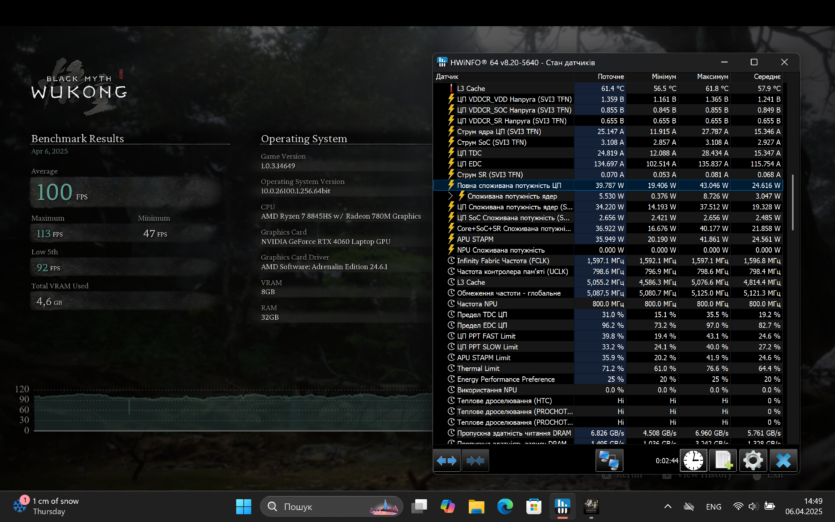
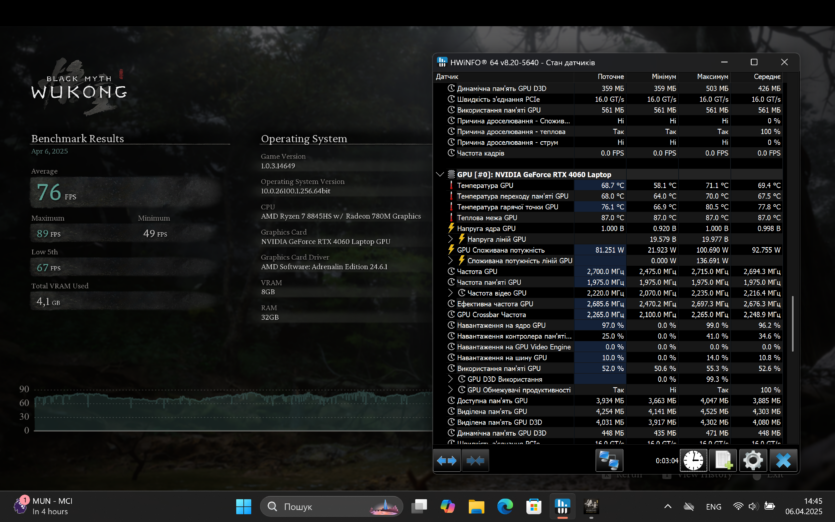
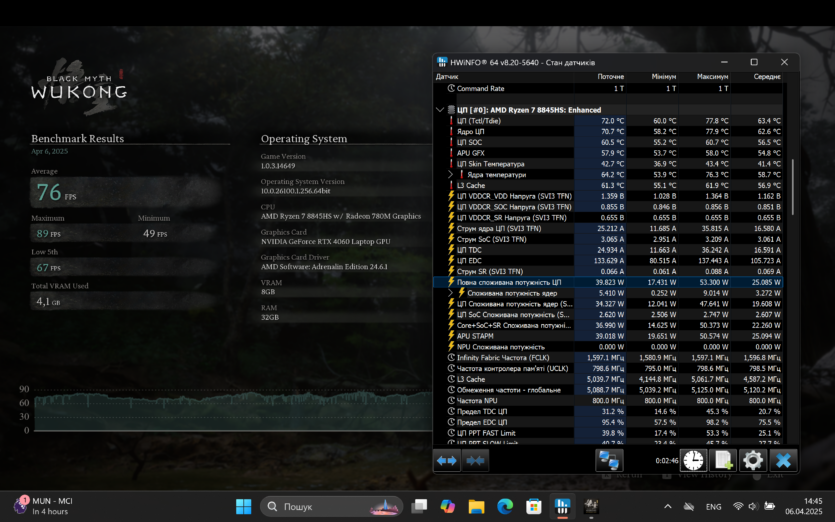
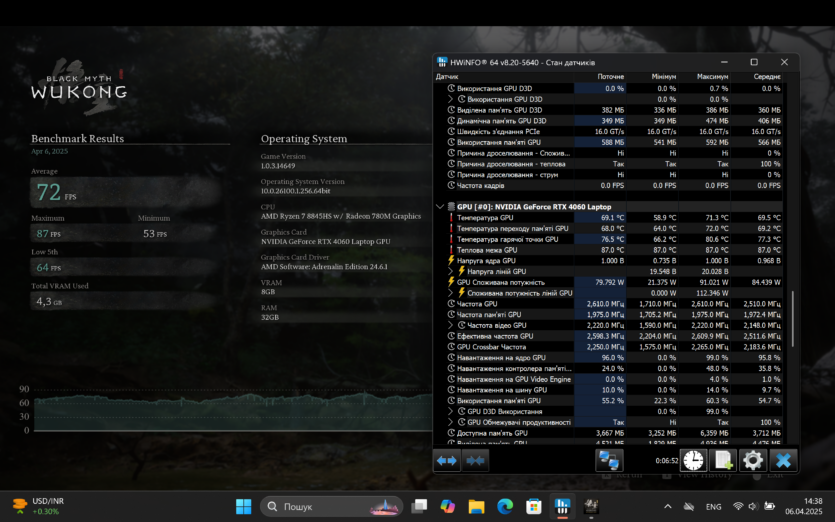
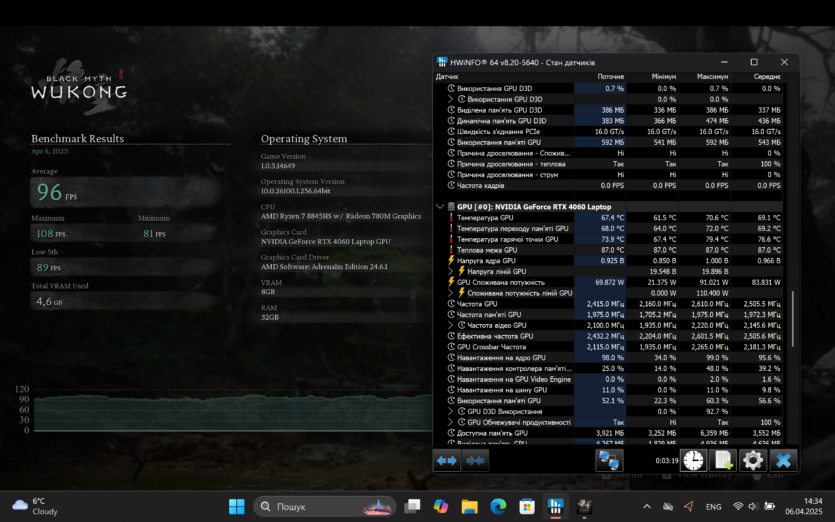
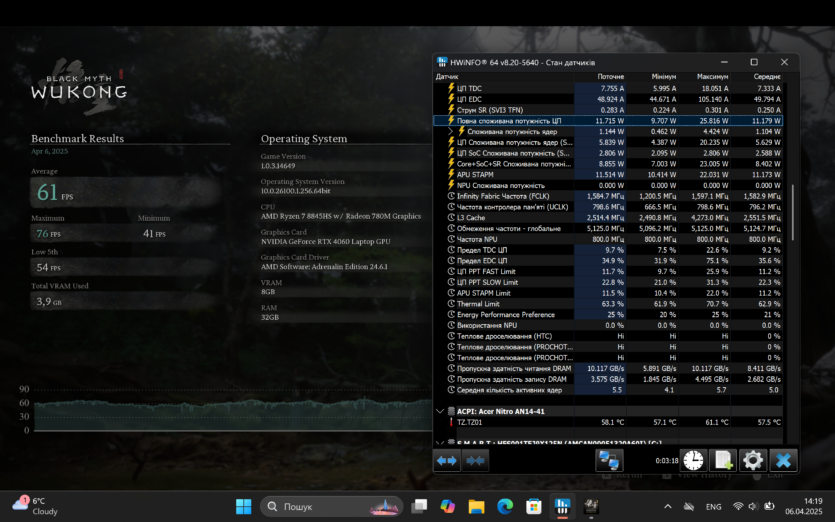

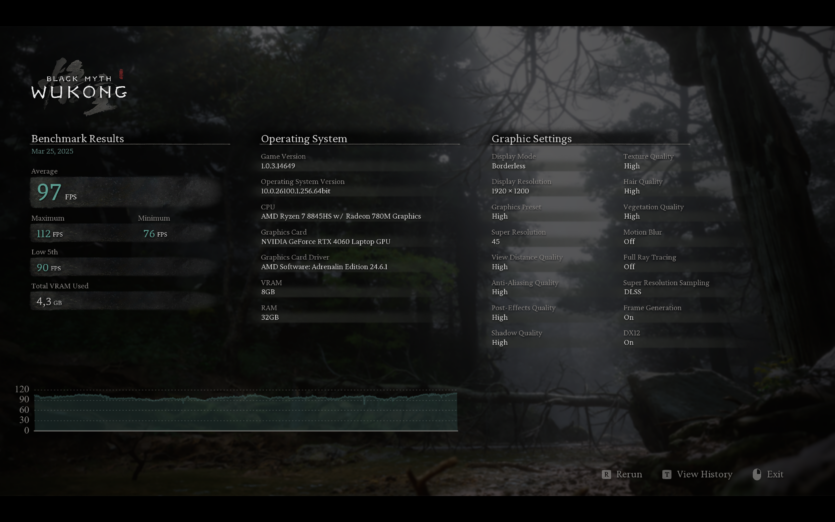
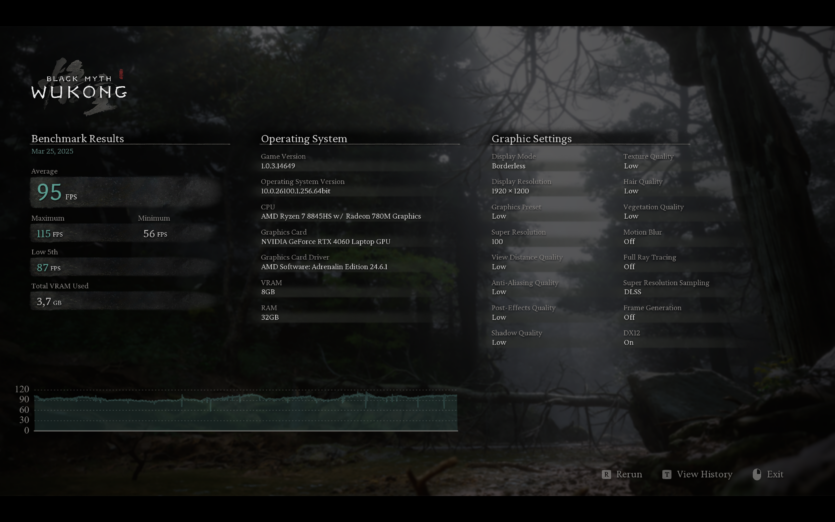
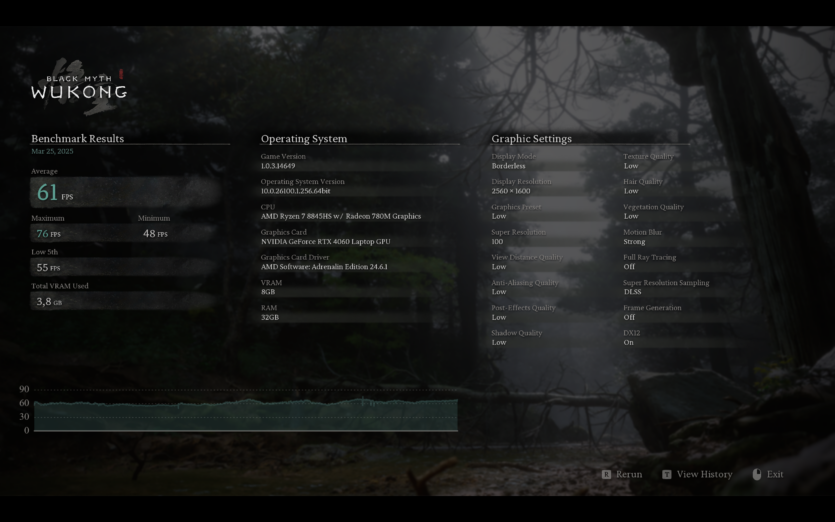
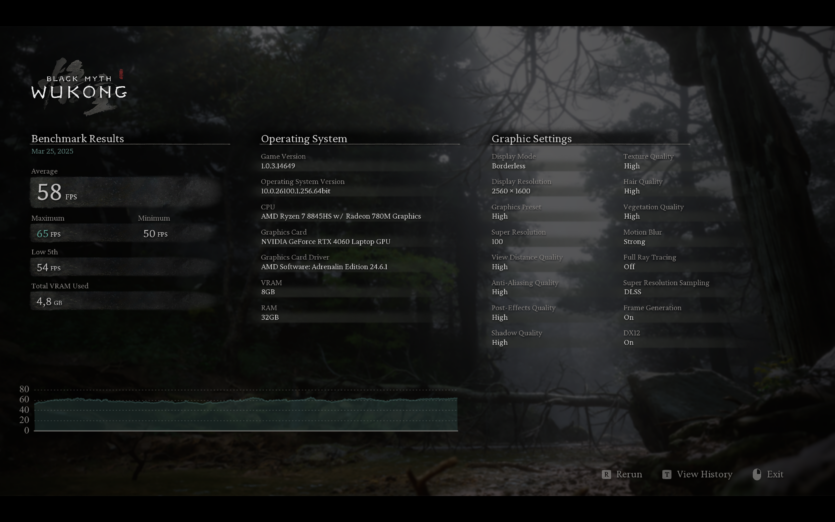
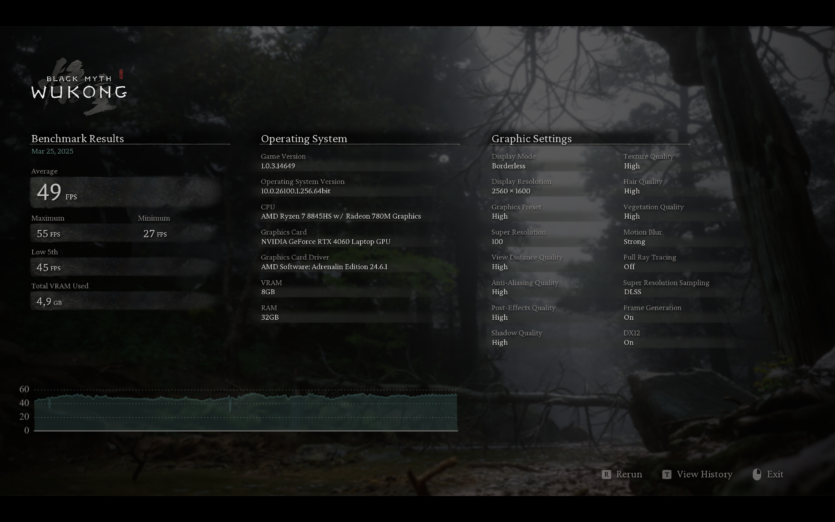
What about the performance itself? It is quite high even with high graphics and low TDP.
| Modes | Without FG | FG |
| Quiet (battery, green indicator color) | 30 FPS | 59 FPS |
| Balanced (battery, orange indicator color) | 30 FPS | 59 FPS |
| Quiet (PSU, white indicator color) | 61 FPS | 80 FPS |
| Balanced (PSU, orange indicator color) | 68 FPS | 86 FPS |
| Performance (PSU, red color of the indicator | 72 FPS | 96 FPS |
| Turbo (PSU, purple indicator color) | 76 FPS | 100 FPS |
However, you don’t need to enable Ray Tracing (RT), but the NVIDIA RTX 4060 is a basic solution, so you will have to enable Frame Generation (FG) for normal gaming.
| Turbo, RT Low, FG | 67 FPS |
| Turbo, RT Middle, FG | 65 FPS |
| Turbo, RT High, FG | 55 FPS |
For further gaming tests, let’s use Turbo mode and try to reach 120 FPS to achieve a smooth gameplay thanks to the 120 Hz display. Finally, let’s finish with Black Myth: Wukong and look ahead to the clear truth for all future games: to achieve 120 FPS, you need to enable the Frame Generator.
| Modes | FG is off | FG is enabled |
| FullHD (DLSS 45%) | 93 FPS | 119 FPS |
| 2K (DLSS 45%) | 76 FPS | 100 FPS |
| FullHD (no DLSS, DLAA 100%) | 58 FPS | 78 FPS |
| 2K (without DLSS, DLAA 100%) | 39 FPS | 61 FPS |
| For 120 FPS: 2K, DLSS 45%, Low Graphics | х | 138 FPS |
In Cyberpunk 2077, the laptop shows good results. With a native resolution of 2560 x 1600 and medium settings, you can get a stable 120 fps with DLSS 3 and Frame Generator.
| Modes | FG is off | FG is enabled |
| FullHD (DLSS Quality) | 91 FPS | 136 FPS |
| 2K (DLSS Quality) | 53 FPS | 86 FPS |
| FullHD | 73 FPS | 117 FPS |
| 2К | 42 FPS | 69 FPS |
| For 120 FPS: 2K, DLSS Quality, Custom Graphics | x | 134 FPS |
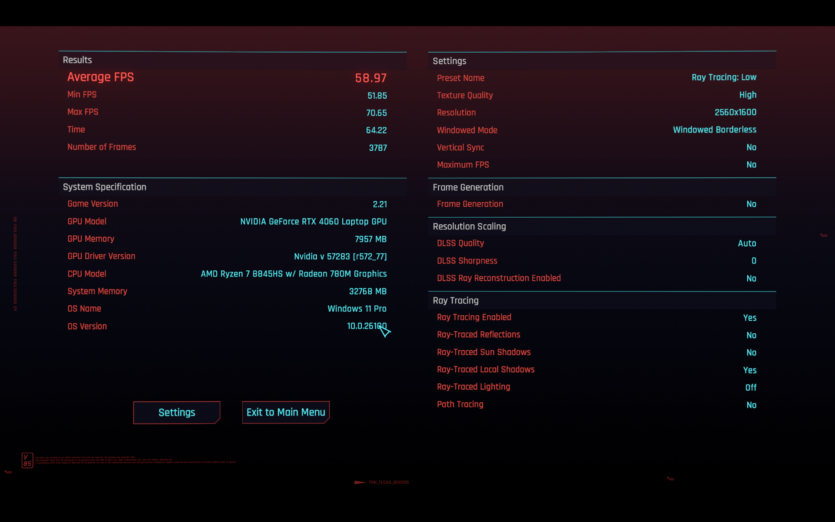
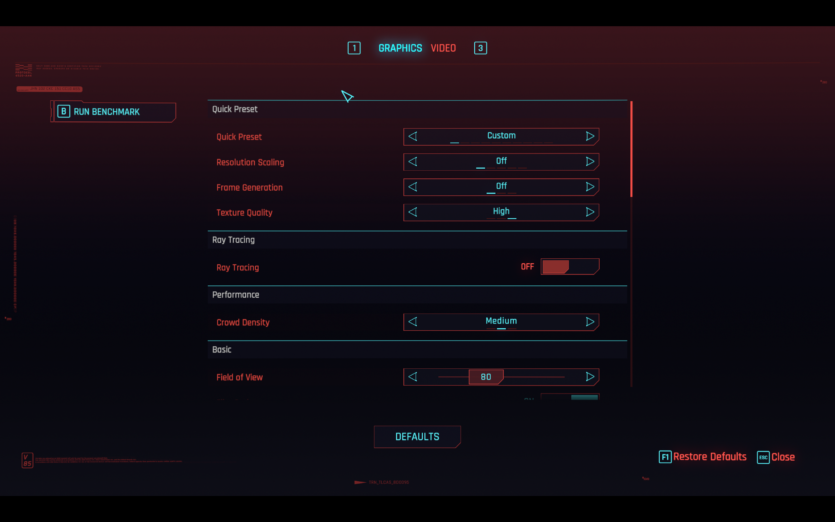
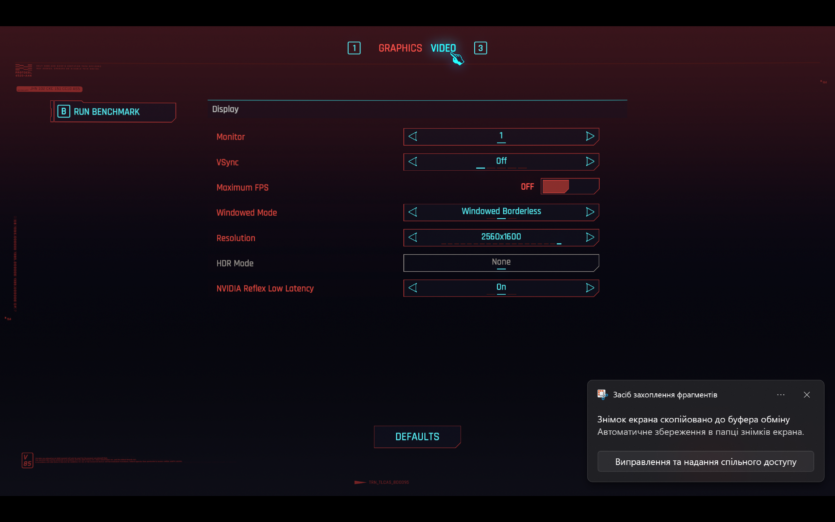
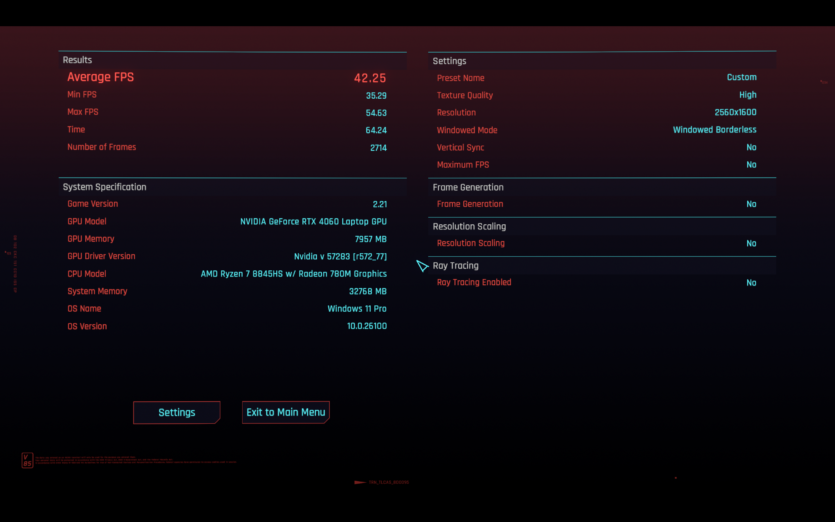

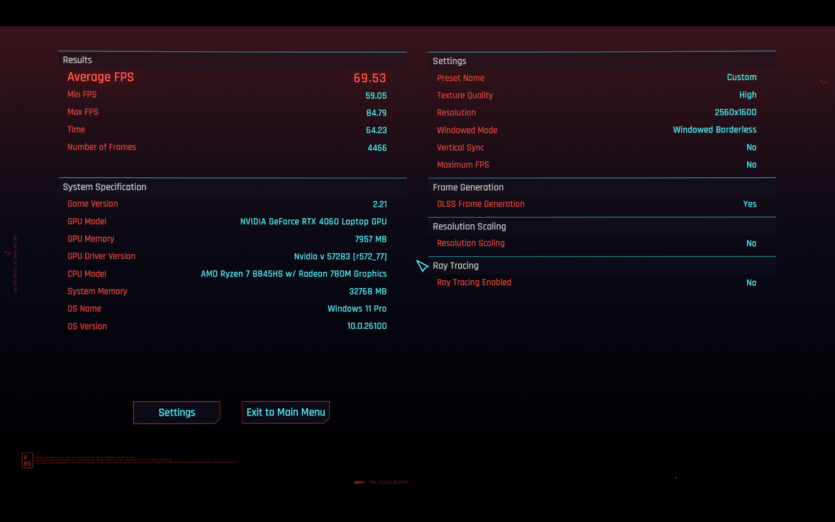
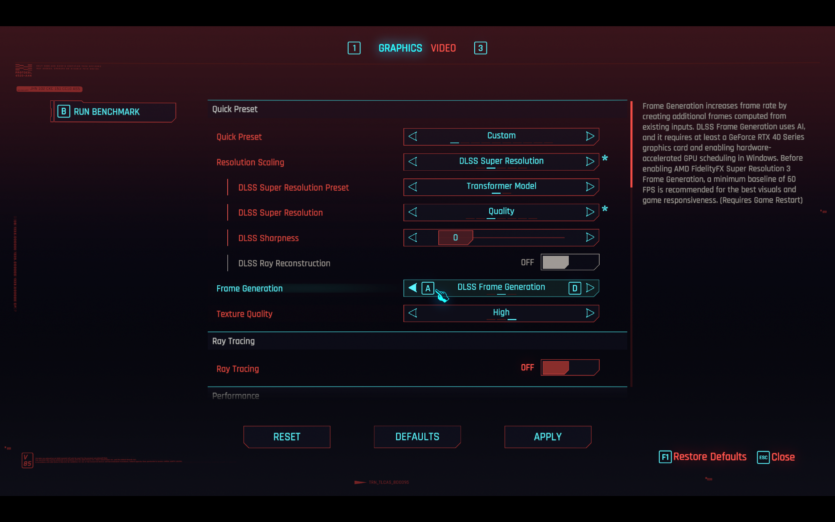
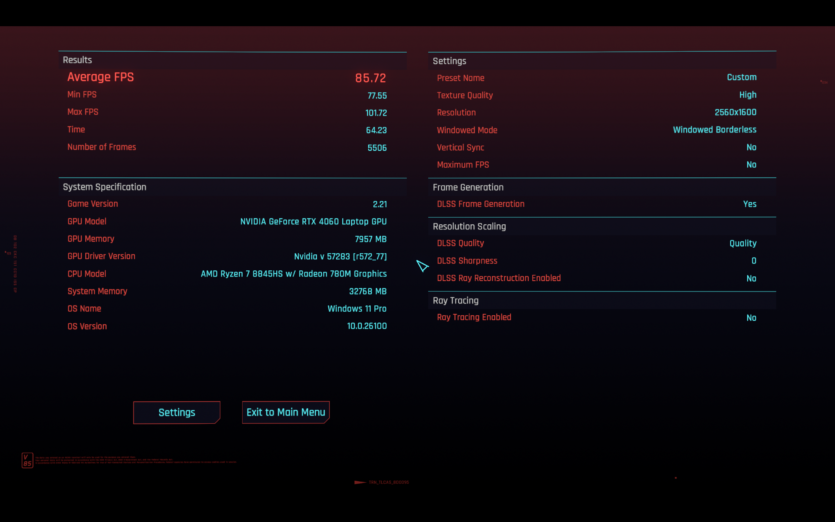
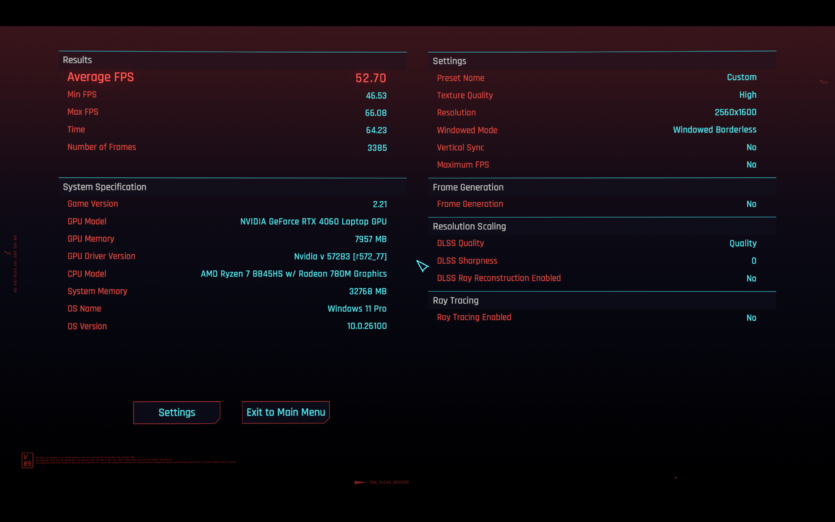


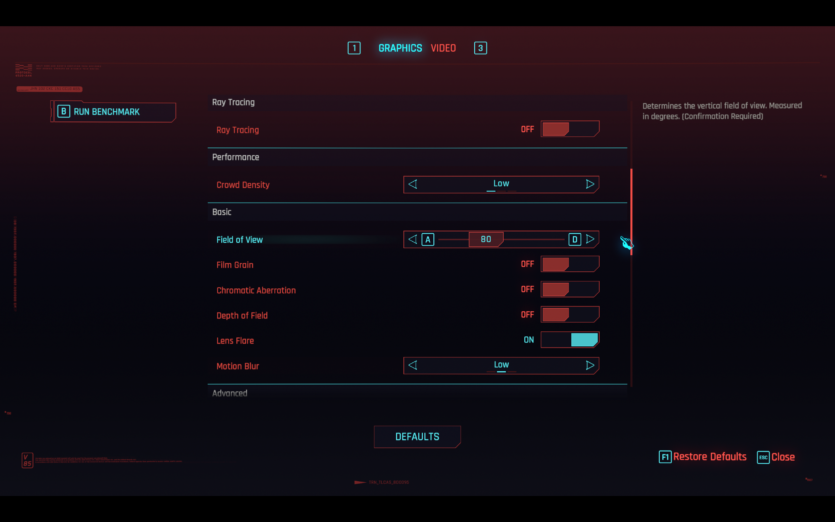
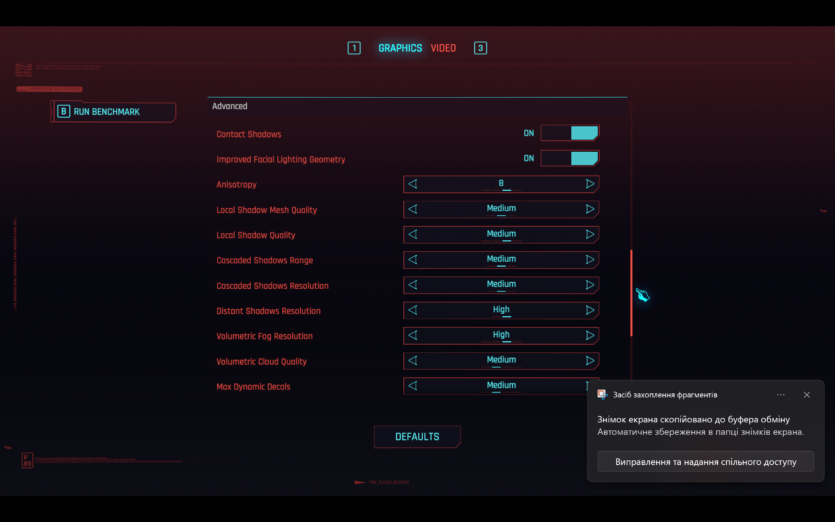
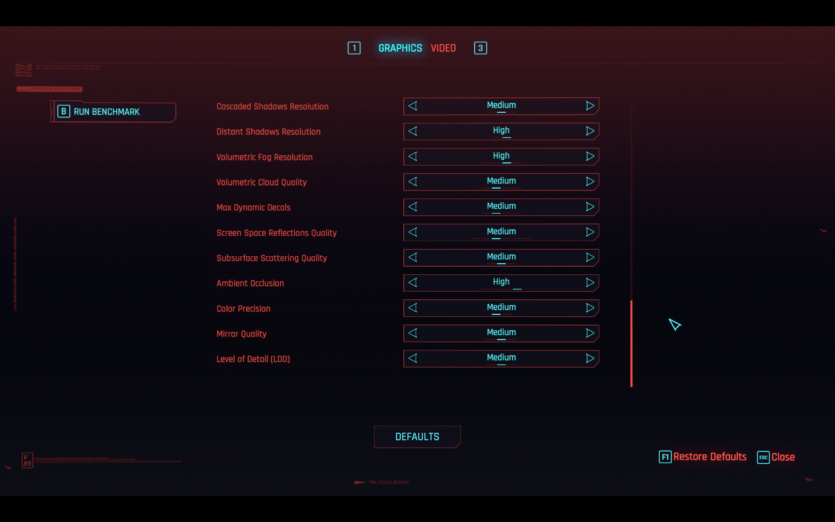
Silent Hill 2 Remake is a pretty heavy game. For stable 120 fps, you need to lower the settings to Minimum, enable DLSS Ultra Performance and Frame Generator. If you are satisfied with 50-60 fps, feel free to set the settings to High with DLSS Quality.
| Modes | FG is off | FG is enabled |
| FullHD (DLSS Quality) | 64 FPS | 99 FPS |
| 2K (DLSS Quality) | 50 FPS | 69 FPS |
| FullHD | 52 FPS | 63 FPS |
| 2К | 39 FPS | 49 FPS |
| For 120 FPS: 2K, DLSS Ultra Performance, Low Graphics | х | 130 FPS |
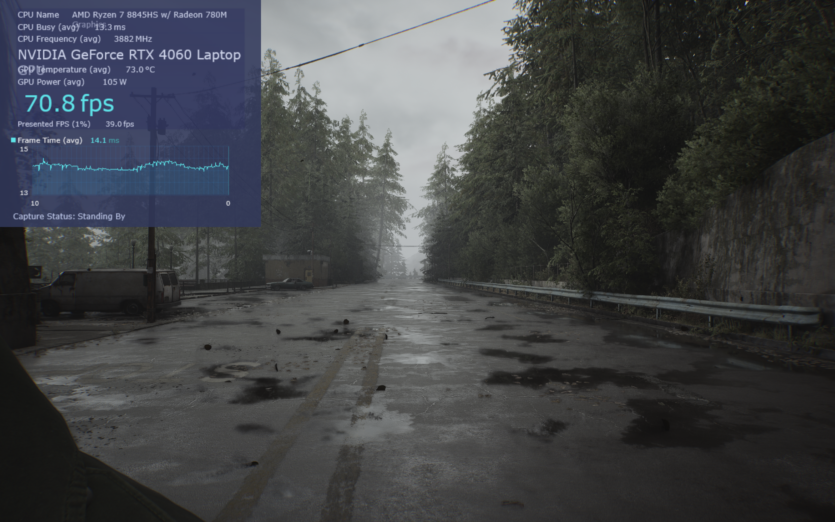
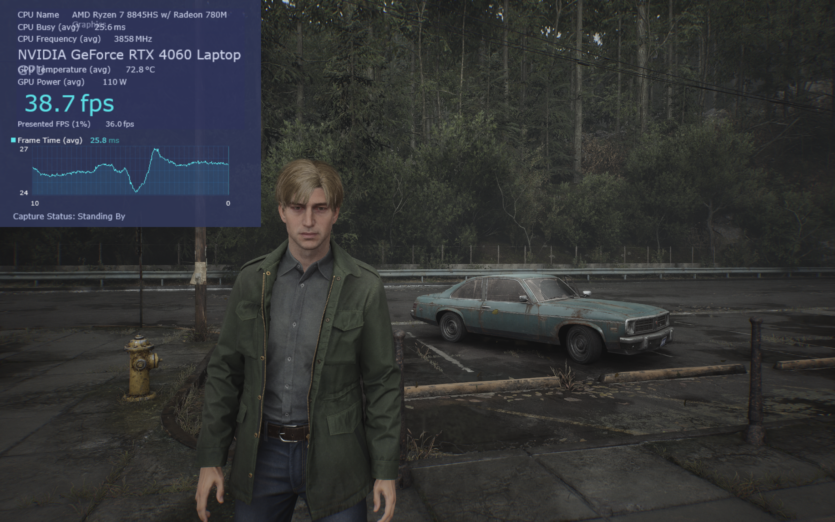

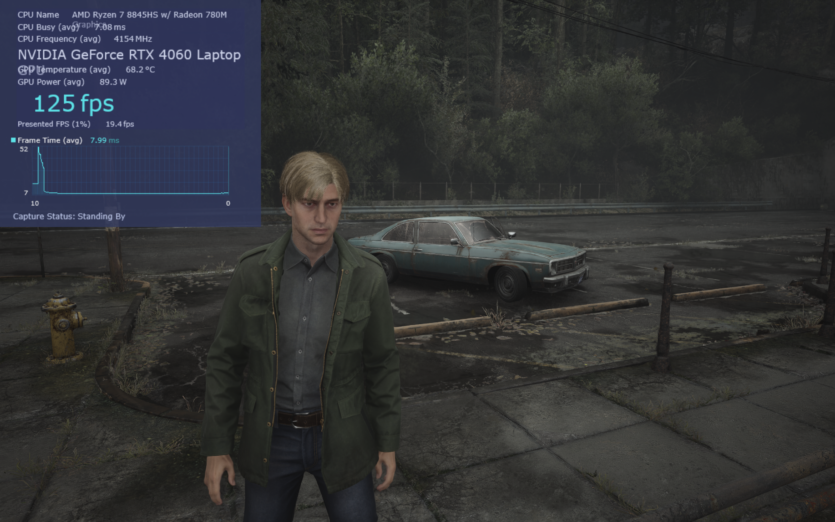
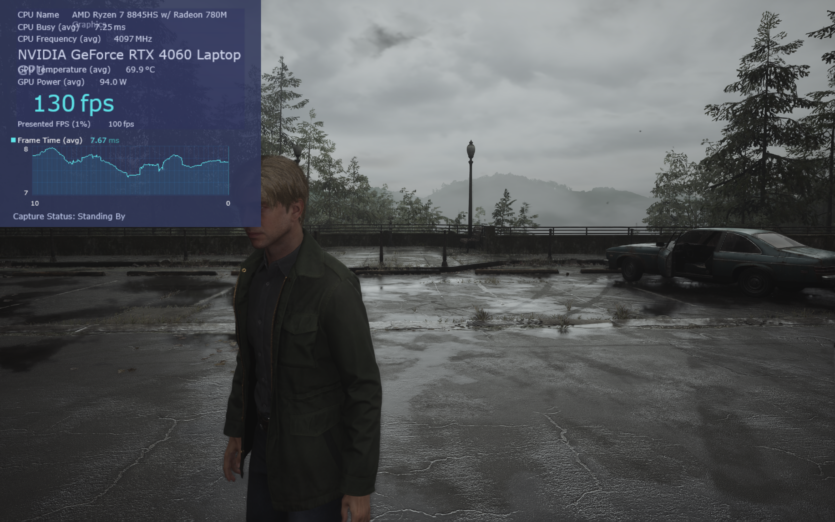
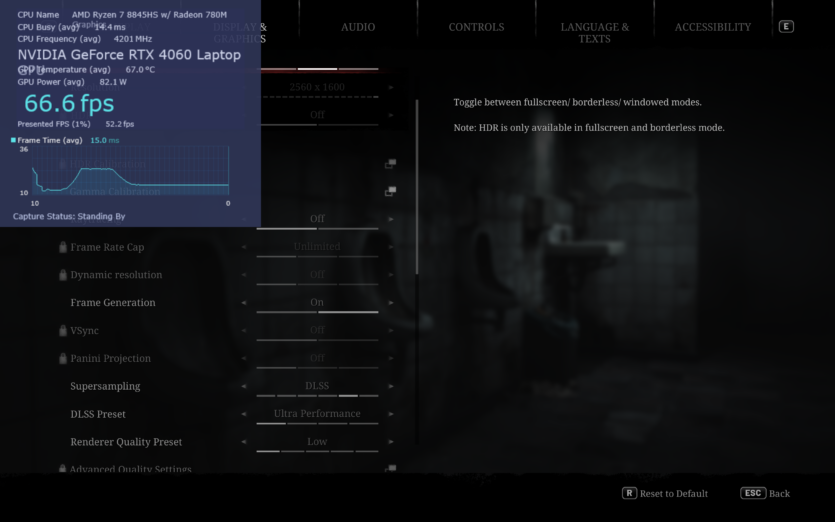
It seems that Forza Motorsport has a certain frame rate limit. There is no built-in generator in the game. Therefore, it will be very difficult to get at least one frame after 100 FPS. However, even on the lowest settings we get 121 FPS. But the graphics are so «terrible» and it is more desirable to get 100 FPS with a good image.
| Modes | FG is off |
| FullHD (DLSS Quality) | 110 FPS |
| 2K (DLSS Quality) | 105 FPS |
| FullHD | 105 FPS |
| 2К | 87 FPS |
| For 120 FPS: Very Low Graphics | 121 FPS |
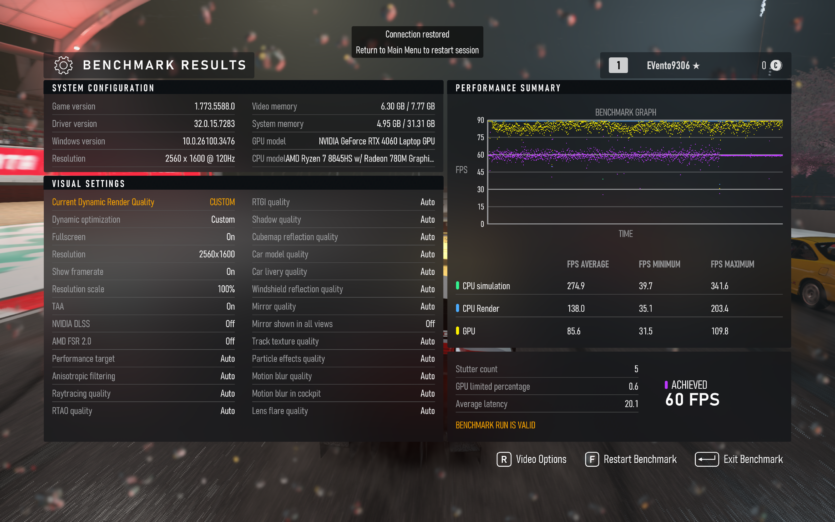
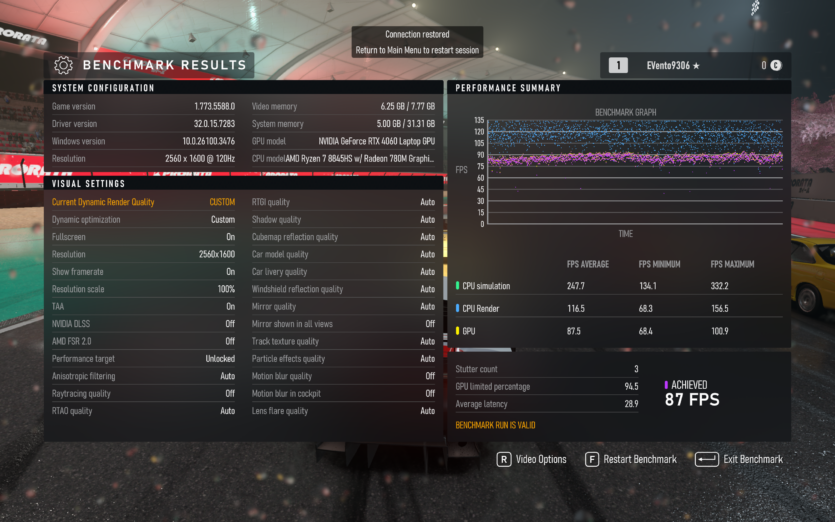
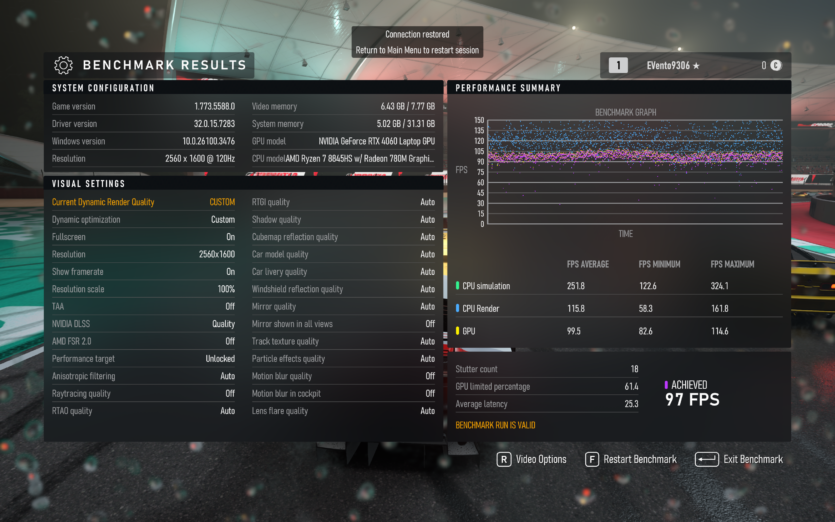
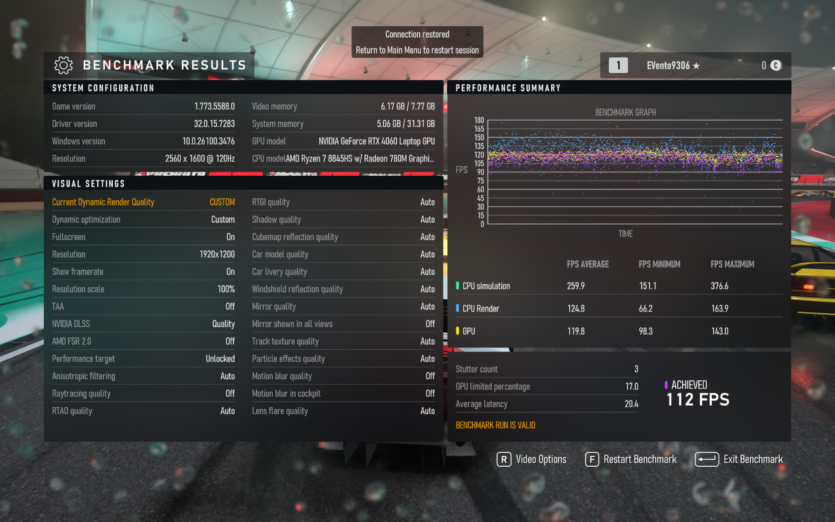
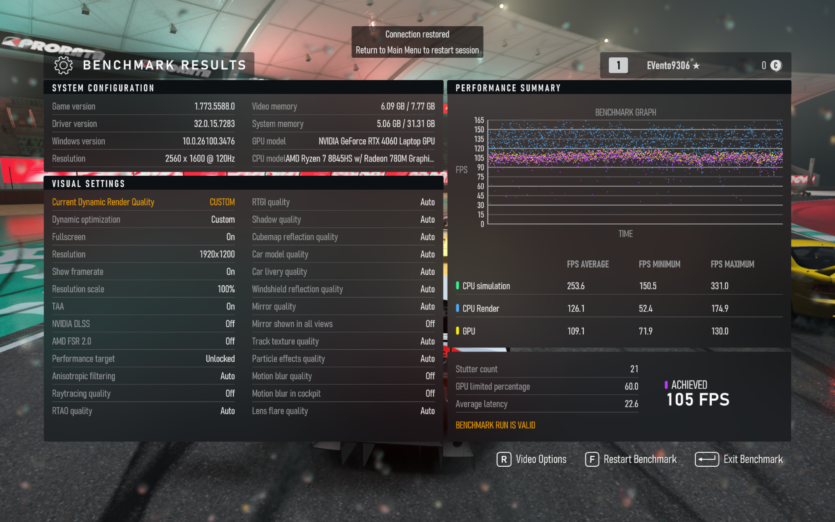
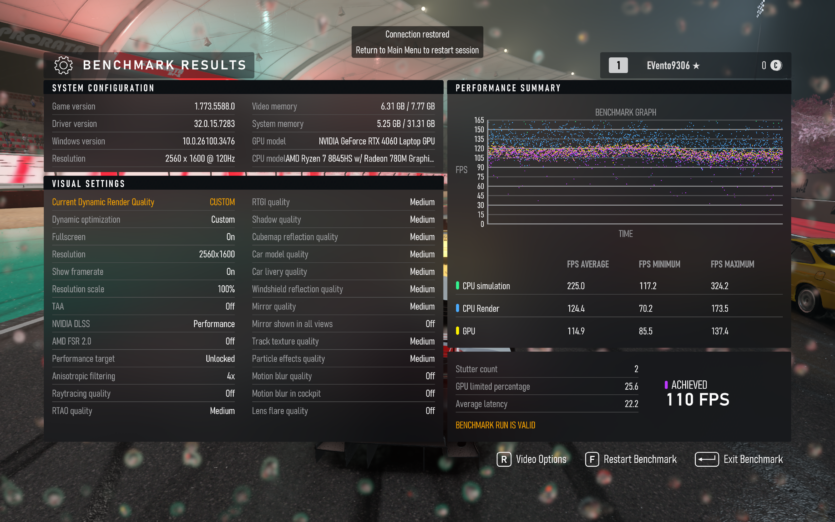


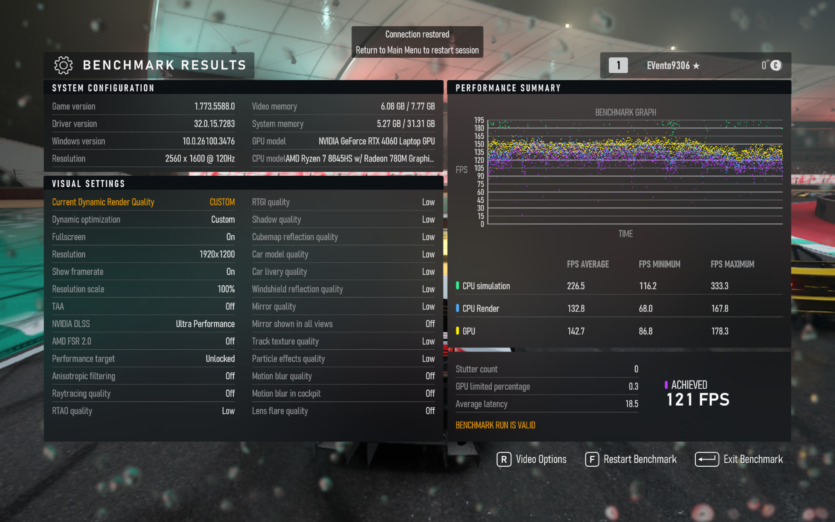
Another game with a limited FPS is Tekken 8. The maximum FPS in it is 60. The limit is primarily related to character animations. To achieve this value, you can set the settings to Ultra with DLSS Quality.
In SS2 with maximum 2K graphics, you can get 115 FPS. And if you enable eSports settings, you get 150 FPS in 2K. In Marvel: Rivals you can get 120 FPS, but it will not be stable. The reason for this will be freezes and staters from allied or enemy skins, as they will be loaded and displayed in the game for the first time.
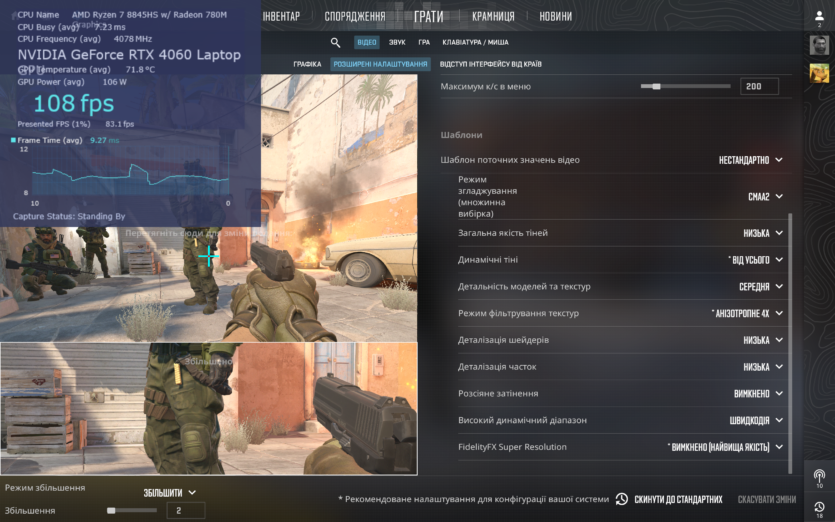
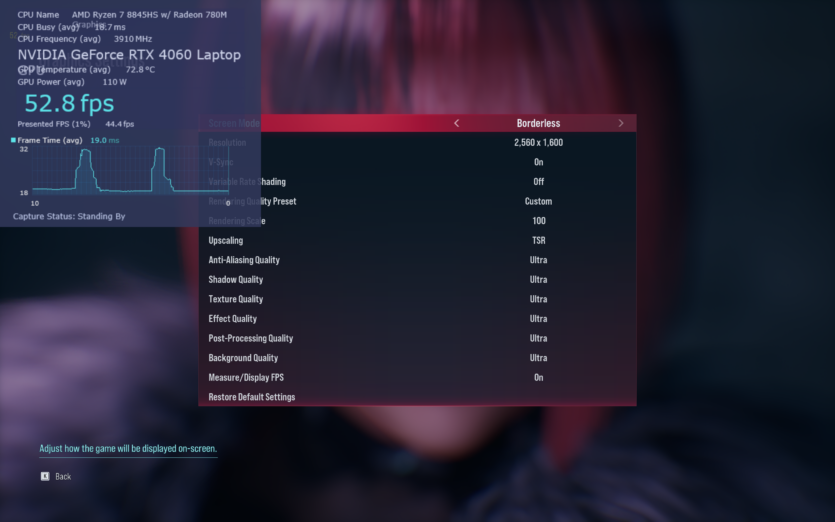
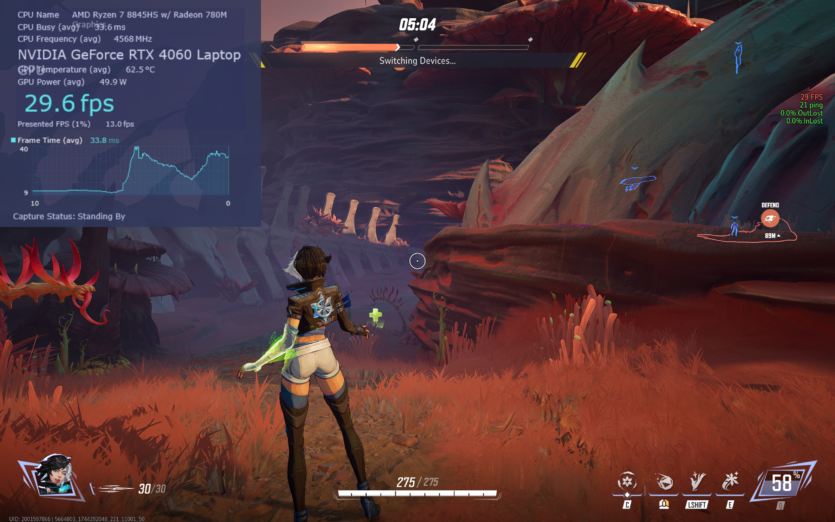
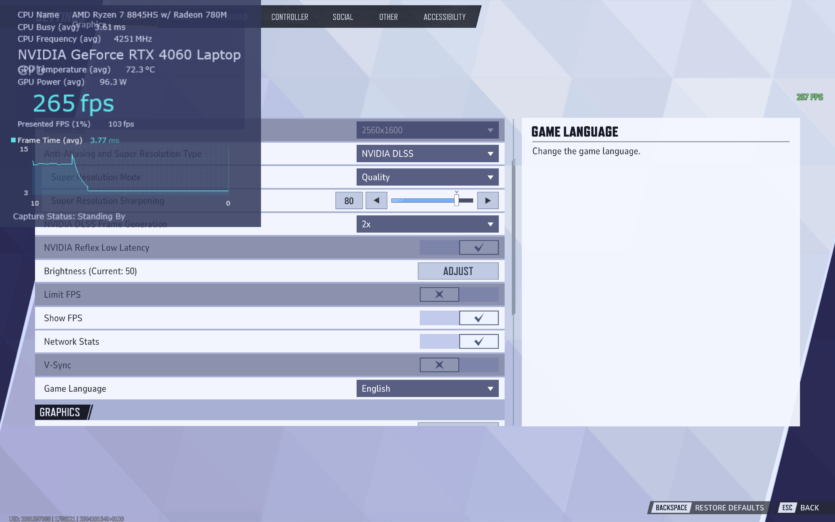
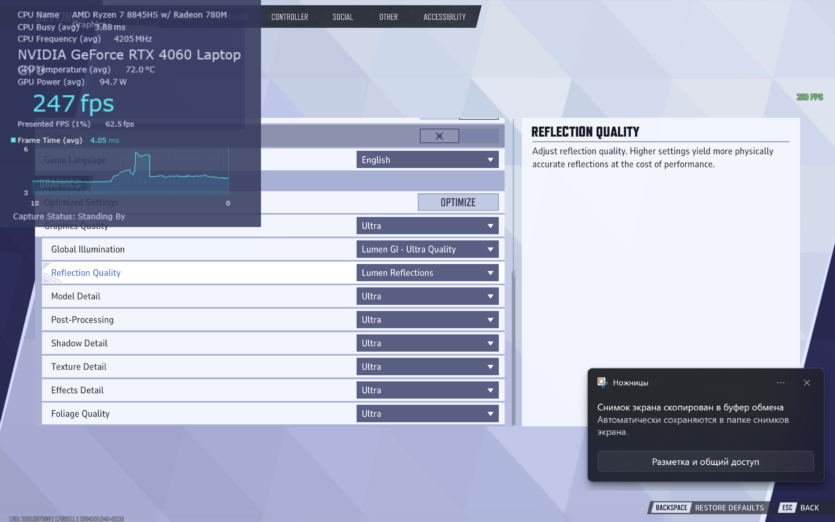
Battery life, temperatures and noise
The Acer Nitro 14 (AN14-41-R6) laptop has a 76 Wh battery. The battery looks good on paper. But the battery life is not impressive. With Wi-Fi, Bluetooth, display brightness at 75% and in Silent mode, the laptop will last more than 4 hours. This will clearly not be enough for a full working day (8 hours), so you will need to take a rather large and heavy (789 grams) charger with you. If you’re going to play it from the built-in battery, you’ll get about 1:30 minutes of playtime. Of course, it depends on the game you choose.
During the stress tests, it was found that the maximum temperature of the AMD Ryzen 7 8845HS processor in AIDA64 was 90 degrees with a 75W heat pack, while the NVIDIA RTX 4060 video card with a 113W TGP: average value of about 77 degrees, Hotspot — 89 degrees. The Vortex Flow cooling system can handle such really hot components.

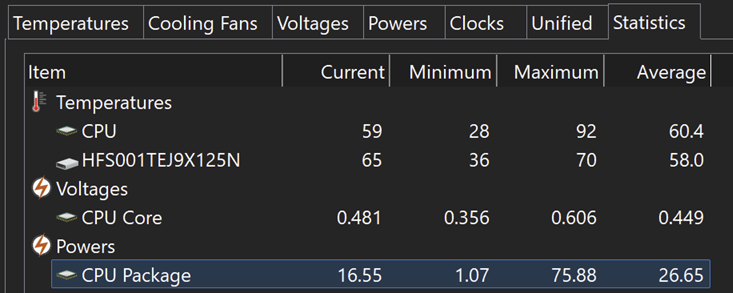
The noise is quite interesting. I like that in the Quiet mode the laptop automatically turns off the fans and turns them on when it is really necessary. Usually for about 5 seconds at most. Even in Turbo mode, they do not turn on without a load. The lowest noise occurs in Quiet/Balanced mode (up to 40 decibels), while the highest noise is in Turbo mode (60 decibels). Keep in mind that in Turbo mode with the game on, the speakers are almost inaudible. It’s also uncomfortable to sit for a long time with this noise level.
Experience of use
Once upon a time, I had a small 11-inch laptop that impressed me first of all with its austere and modern design. And only then with its pretty good performance for such a form factor. I even completed the last missions in the Battlefield 3 campaign on it.
The Acer Nitro 14 (AN14-41-R6) reminded me a lot of it with a lot of corrected shortcomings. Strict design on the outside? Yes, it is. It turns into a gaming laptop after «putting on a cloak» — the Power key. Weight. The same 2 kilograms as its predecessor.
Only «hardware» inside has improved significantly since then, so much so that modern AAA games can be played at high settings in FullHD or at medium settings in 2K. But let’s not forget that we are looking at a mobile RTX 4060 8GB. Having it in such a mobile case without restrictions is worth it. If you take a smaller TGP, then there is no point in buying an RTX 4060 in a laptop at all when it turns into an RTX 4050.
In general, I used the Silent mode, because this mode fully justifies its name — complete silence, which was interrupted by a sharp noise of the fans for about 2-5 seconds. I would like to make their «burst» less obvious to the user. Personally, it didn’t bother me, but it’s quite strange to hear.
What can be done to make it even better? This is a difficult question. The performance is clearly enough for more than one year. Is it the battery? Of course, yes, but for this you need to forget about using a discrete video card inside. And I don’t want to do that. I’m sure that the battery life can be increased, you just need to better configure the Silent mode (battery) and reduce power consumption to a maximum of 10-15 watts. This should give another 1-1.5 hours of battery life.
As for the small things, I would like to have a separate power button. Once, however, I couldn’t figure out why the laptop wasn’t responding for a long time. As it turned out, I confused the Power key with a separate key for changing power consumption modes.


There are only two things that bother me about the experience. The first is: will the round connector stay firmly in the charging slot? I personally saw an example with another laptop from the company in which the connector simply did not stay inside. Because of this, any slight movement of the laptop or the cable connected to it interrupted the battery charging. I hope this model doesn’t have such problems.
The second thing that worries me is the use of liquid metal in the cooling system. On the one hand, this thermal interface performs its main function well. On the other hand, it is not reliable in the long run. Why? There may be cases of «corrosion of» part of the nickel part of the cooling system. And with copper, «is not friends with» at all. Most likely, after a few years of operation, you will have to change the liquid metal to a regular thermal paste.
Price and competitors
The cost of the Acer Nitro 14 (AN14-41-R6) laptop is UAH 69999. Unlike the test device, you don’t get Windows 11 Pro for this price. This is a fairly affordable price compared to the following competitors, which cannot use the built-in discrete graphics card to its fullest.
The Lenovo Yoga Pro 7 14IMH9 laptop offers an Intel Core Ultra 9 185H processor, an OLED display with a resolution of 2880×1800. The NVIDIA RTX 4060 video card has a cut TGP (60 watts) versus the full-fledged one of our review hero (110 watts), although it has a lower weight (1.59 kg versus 2.02 kg). For this you have to give up 79999 UAH.
Not so long ago on review was an Acer Nitro V (14 ANV14-61) laptop with NVIDIA RTX 4050 in white. Yes, this video card is weaker, but the overall dimensions and weight (1.7 kg; -300 grams) are smaller, which increases user mobility. The battery is 57 Wh. The price of this solution is 58499 UAH.
If you want to have the size of a regular 14″ inch model, the HP Omen 14 FB00020UA (89755 UAH): Intel Core Ultra 9 185H processor, OLED display with a resolution of 2880×1800. However, the bundled 140W power supply hints that the potential of the mobile NVIDIA RTX 4060 or, especially, RTX 4070 will not be revealed.

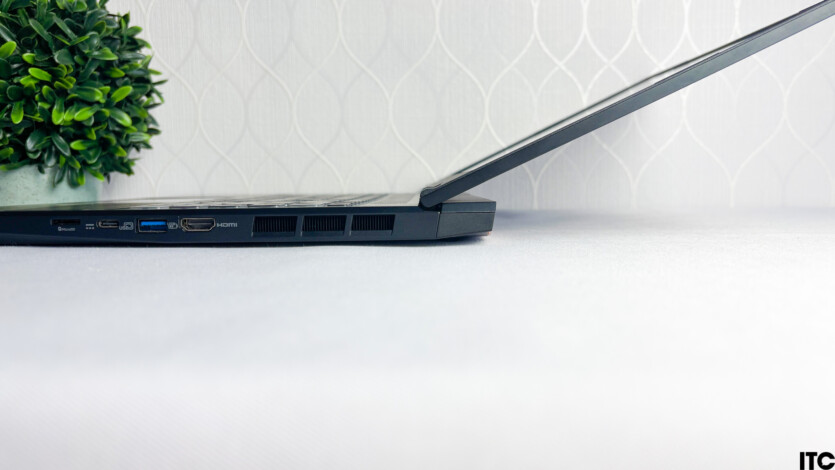

Spelling error report
The following text will be sent to our editors: